The Mediating Role of Organizational Learning in Business Performance: An Empirical Study
VerifiedAdded on 2019/09/13
|59
|13362
|512
Report
AI Summary
**Summary:** This assignment discusses various studies on organizational learning, human resource management, and their impact on business performance. The studies analyzed examine the mediating role of organizational learning, the moderating effects of organizational size, and the impact of human resource management on environmental performance. They also explore the relationship between high-performance work systems and organizational ambidexterity, as well as the effect of e-learning on individual performance. Additionally, the assignment touches upon smart cities, performance management systems, and the importance of gamification in education. The studies provide insights into how organizations can improve their learning orientation, employee commitment, and overall performance through effective HR practices.
Contribute Materials
Your contribution can guide someone’s learning journey. Share your
documents today.
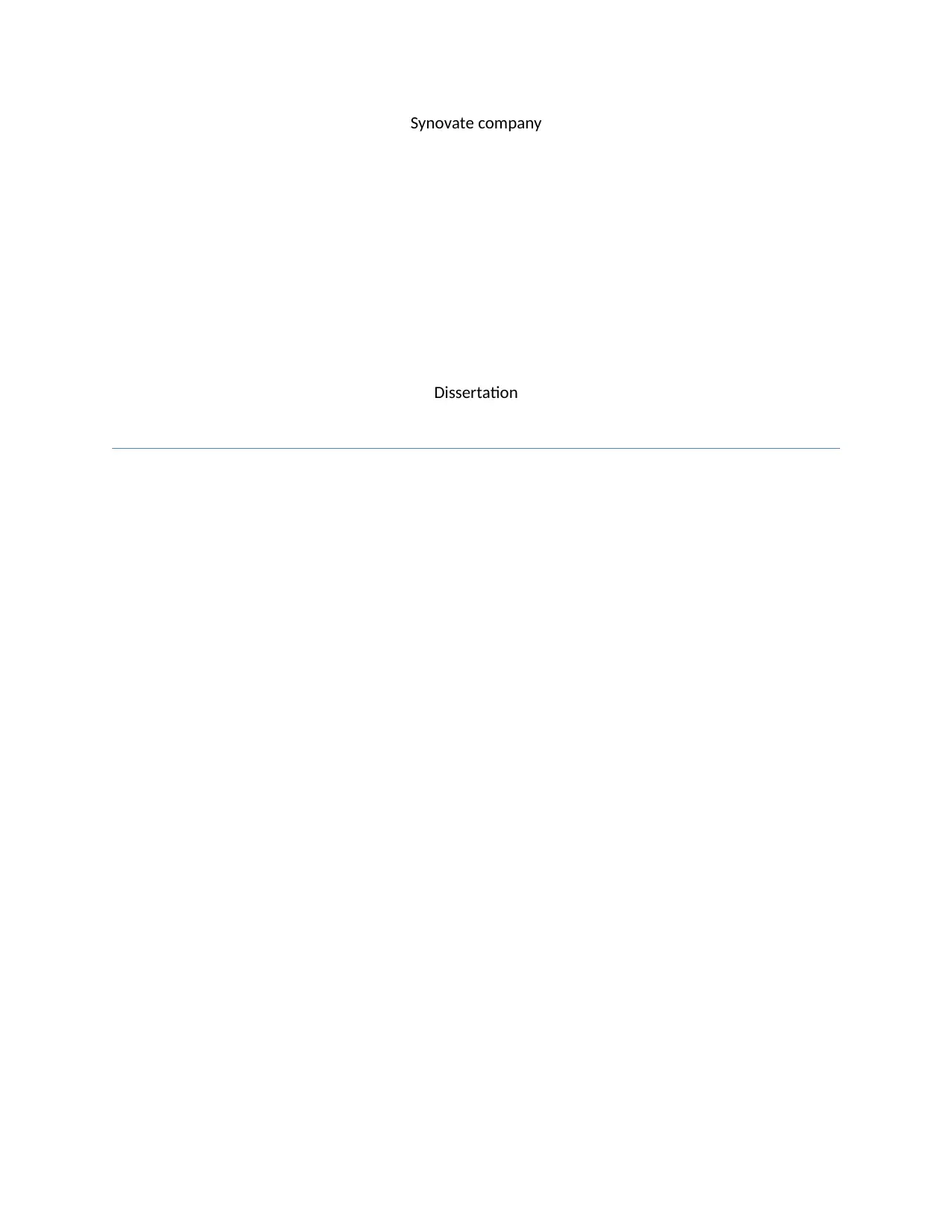
Synovate company
Dissertation
Dissertation
Secure Best Marks with AI Grader
Need help grading? Try our AI Grader for instant feedback on your assignments.
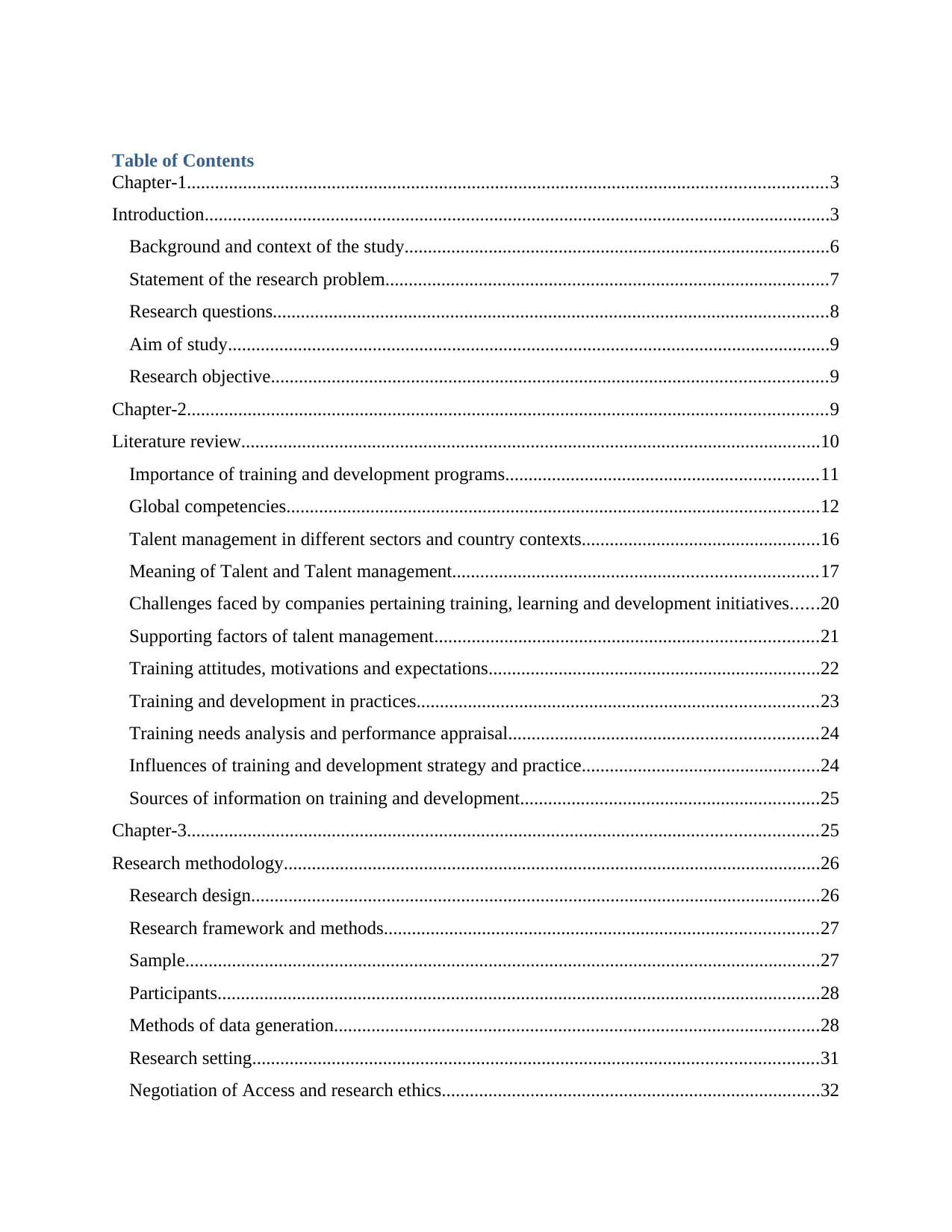
Table of Contents
Chapter-1.........................................................................................................................................3
Introduction......................................................................................................................................3
Background and context of the study...........................................................................................6
Statement of the research problem...............................................................................................7
Research questions.......................................................................................................................8
Aim of study.................................................................................................................................9
Research objective.......................................................................................................................9
Chapter-2.........................................................................................................................................9
Literature review............................................................................................................................10
Importance of training and development programs...................................................................11
Global competencies..................................................................................................................12
Talent management in different sectors and country contexts...................................................16
Meaning of Talent and Talent management..............................................................................17
Challenges faced by companies pertaining training, learning and development initiatives......20
Supporting factors of talent management..................................................................................21
Training attitudes, motivations and expectations.......................................................................22
Training and development in practices......................................................................................23
Training needs analysis and performance appraisal..................................................................24
Influences of training and development strategy and practice...................................................24
Sources of information on training and development................................................................25
Chapter-3.......................................................................................................................................25
Research methodology...................................................................................................................26
Research design..........................................................................................................................26
Research framework and methods.............................................................................................27
Sample........................................................................................................................................27
Participants.................................................................................................................................28
Methods of data generation........................................................................................................28
Research setting.........................................................................................................................31
Negotiation of Access and research ethics.................................................................................32
Chapter-1.........................................................................................................................................3
Introduction......................................................................................................................................3
Background and context of the study...........................................................................................6
Statement of the research problem...............................................................................................7
Research questions.......................................................................................................................8
Aim of study.................................................................................................................................9
Research objective.......................................................................................................................9
Chapter-2.........................................................................................................................................9
Literature review............................................................................................................................10
Importance of training and development programs...................................................................11
Global competencies..................................................................................................................12
Talent management in different sectors and country contexts...................................................16
Meaning of Talent and Talent management..............................................................................17
Challenges faced by companies pertaining training, learning and development initiatives......20
Supporting factors of talent management..................................................................................21
Training attitudes, motivations and expectations.......................................................................22
Training and development in practices......................................................................................23
Training needs analysis and performance appraisal..................................................................24
Influences of training and development strategy and practice...................................................24
Sources of information on training and development................................................................25
Chapter-3.......................................................................................................................................25
Research methodology...................................................................................................................26
Research design..........................................................................................................................26
Research framework and methods.............................................................................................27
Sample........................................................................................................................................27
Participants.................................................................................................................................28
Methods of data generation........................................................................................................28
Research setting.........................................................................................................................31
Negotiation of Access and research ethics.................................................................................32
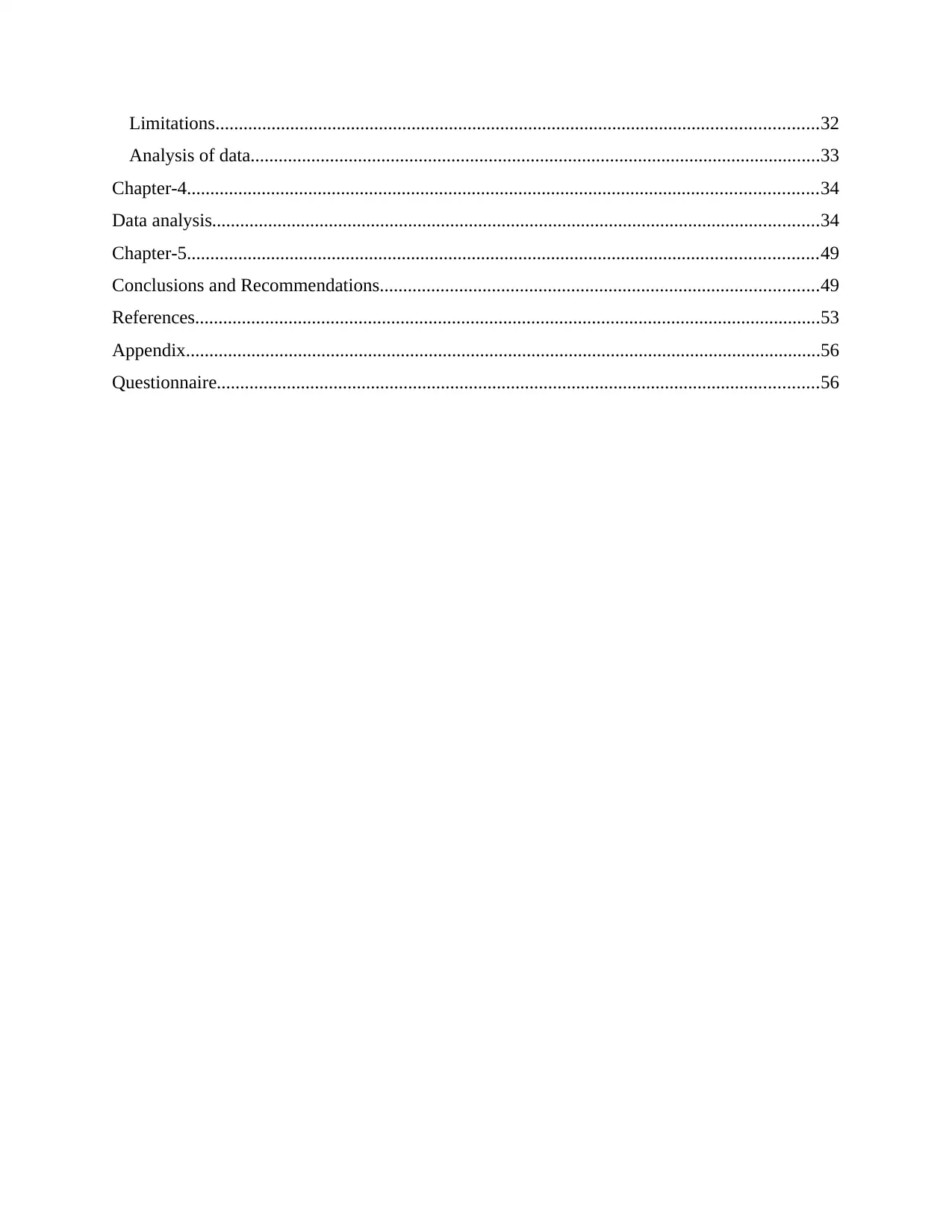
Limitations.................................................................................................................................32
Analysis of data..........................................................................................................................33
Chapter-4.......................................................................................................................................34
Data analysis..................................................................................................................................34
Chapter-5.......................................................................................................................................49
Conclusions and Recommendations..............................................................................................49
References......................................................................................................................................53
Appendix........................................................................................................................................56
Questionnaire.................................................................................................................................56
Analysis of data..........................................................................................................................33
Chapter-4.......................................................................................................................................34
Data analysis..................................................................................................................................34
Chapter-5.......................................................................................................................................49
Conclusions and Recommendations..............................................................................................49
References......................................................................................................................................53
Appendix........................................................................................................................................56
Questionnaire.................................................................................................................................56

QUESTIONNAIRE – 5 POINT SCALE AND ALSO ANALYSIS AS PER FORMAT (ALREADY
SENT) for example, use different charts/graphs for different questions (Pls.follow sample format)
ABOUT COMPANY – WRITE ONE PAGE IN THE SAMPLE section (UNDER RESEARCH
METHODOLOGY)
FIRST THREE PAGES FORMATS – TO BE FOLLOWED as per report format
WRITE LITERATURE REVIEW – 8 PAGES 2000 words
REFERENCES – TO BE WRITTEN IN THE FORMAT (PLEASE SEE SAMPLE REPORT)
SENT) for example, use different charts/graphs for different questions (Pls.follow sample format)
ABOUT COMPANY – WRITE ONE PAGE IN THE SAMPLE section (UNDER RESEARCH
METHODOLOGY)
FIRST THREE PAGES FORMATS – TO BE FOLLOWED as per report format
WRITE LITERATURE REVIEW – 8 PAGES 2000 words
REFERENCES – TO BE WRITTEN IN THE FORMAT (PLEASE SEE SAMPLE REPORT)
Paraphrase This Document
Need a fresh take? Get an instant paraphrase of this document with our AI Paraphraser

Chapter-1
Introduction
In this present paper, we will discuss the research report on the topic "Impact of learning and
development initiatives in the mid-sized organizations in UAE." The mid-sized organization in
UAE has financial constraints, so the learning and development initiatives enable to develop the
competitive advantage to the companies. The research is conducted in the Synovate Research
Company which is the mid-sized organization which provides decision support services such as
business information, technology, onsite reporting, online communication delivery, and others.
The company provides various products such as business assessment report, field assessment
report, and call verification report. The research is conducted to determine the impact of learning
and development initiatives in the mid-sized organizations. The paper includes five chapters
which comprise of introduction, literature review, research methodology, data analysis and
recommendations and conclusion. The aim of the study is to determine the impact of learning
and development initiatives on the performance of mid-sized organizations.
In the twenty-one century, the government is the witness for the drastic operational, economic
and institutional change. The competitive advantage among the companies enables to stand put
among the competitors within the same industry. The mid-sized organizations of the Middle
Eastern countries believe that the introduction of new managerial models helps to improve the
outcomes of the companies within the specific period of time. The study enables to determine the
impact of learning and development initiatives on the overall performance of the company.
Introduction
In this present paper, we will discuss the research report on the topic "Impact of learning and
development initiatives in the mid-sized organizations in UAE." The mid-sized organization in
UAE has financial constraints, so the learning and development initiatives enable to develop the
competitive advantage to the companies. The research is conducted in the Synovate Research
Company which is the mid-sized organization which provides decision support services such as
business information, technology, onsite reporting, online communication delivery, and others.
The company provides various products such as business assessment report, field assessment
report, and call verification report. The research is conducted to determine the impact of learning
and development initiatives in the mid-sized organizations. The paper includes five chapters
which comprise of introduction, literature review, research methodology, data analysis and
recommendations and conclusion. The aim of the study is to determine the impact of learning
and development initiatives on the performance of mid-sized organizations.
In the twenty-one century, the government is the witness for the drastic operational, economic
and institutional change. The competitive advantage among the companies enables to stand put
among the competitors within the same industry. The mid-sized organizations of the Middle
Eastern countries believe that the introduction of new managerial models helps to improve the
outcomes of the companies within the specific period of time. The study enables to determine the
impact of learning and development initiatives on the overall performance of the company.

The developing and developed countries are suffered from the lack of effective training
programs. It is argued that the training programs are failed in the organizations due to the
inappropriate designing of training programs. It is mainly due to the lengthy and theoretical
training programs, and they are not directed towards the achievement of training and
development objectives. Binstead and Stuart et al., (1979) states that there are mainly three
elements of the successful training programs, namely, the content of training program, processes,
and environment of the organization. Healy et al., 2001 states that the goal of the training and
development program is to improve the performance of the employees in order to provide a
competitive advantage to the company. Mentz et al., 1997 states that the quality of delivering
services is improved through providing training and development to the employees. McCourt
and Sola et al., 1999 states that the successful training program leads to achieve the desired
changes in the organization. The training and development programs lead to provide the advance
knowledge to the employees, and it provides the specialization to perform the specific roles and
responsibilities in a most efficient and effective manner.
The training and development are one of the most important elements of the talent management
system as the mid-sized organizations contribute towards the development of the UAE through
improving the performance of the companies. There are various problems in the training and
development program such as the improper implementation of training and development
program, lack of processing's, and lack of management awareness. The human resource
management of the company is responsible for determining the strength, skills, and knowledge
of the employee in order to use them in a right direction. The human resource which is also
known as the personnel management that focused on the transaction process such as salary
package, employment benefits, fringe benefits and others. Tansley et al., 2011 states that the
programs. It is argued that the training programs are failed in the organizations due to the
inappropriate designing of training programs. It is mainly due to the lengthy and theoretical
training programs, and they are not directed towards the achievement of training and
development objectives. Binstead and Stuart et al., (1979) states that there are mainly three
elements of the successful training programs, namely, the content of training program, processes,
and environment of the organization. Healy et al., 2001 states that the goal of the training and
development program is to improve the performance of the employees in order to provide a
competitive advantage to the company. Mentz et al., 1997 states that the quality of delivering
services is improved through providing training and development to the employees. McCourt
and Sola et al., 1999 states that the successful training program leads to achieve the desired
changes in the organization. The training and development programs lead to provide the advance
knowledge to the employees, and it provides the specialization to perform the specific roles and
responsibilities in a most efficient and effective manner.
The training and development are one of the most important elements of the talent management
system as the mid-sized organizations contribute towards the development of the UAE through
improving the performance of the companies. There are various problems in the training and
development program such as the improper implementation of training and development
program, lack of processing's, and lack of management awareness. The human resource
management of the company is responsible for determining the strength, skills, and knowledge
of the employee in order to use them in a right direction. The human resource which is also
known as the personnel management that focused on the transaction process such as salary
package, employment benefits, fringe benefits and others. Tansley et al., 2011 states that the
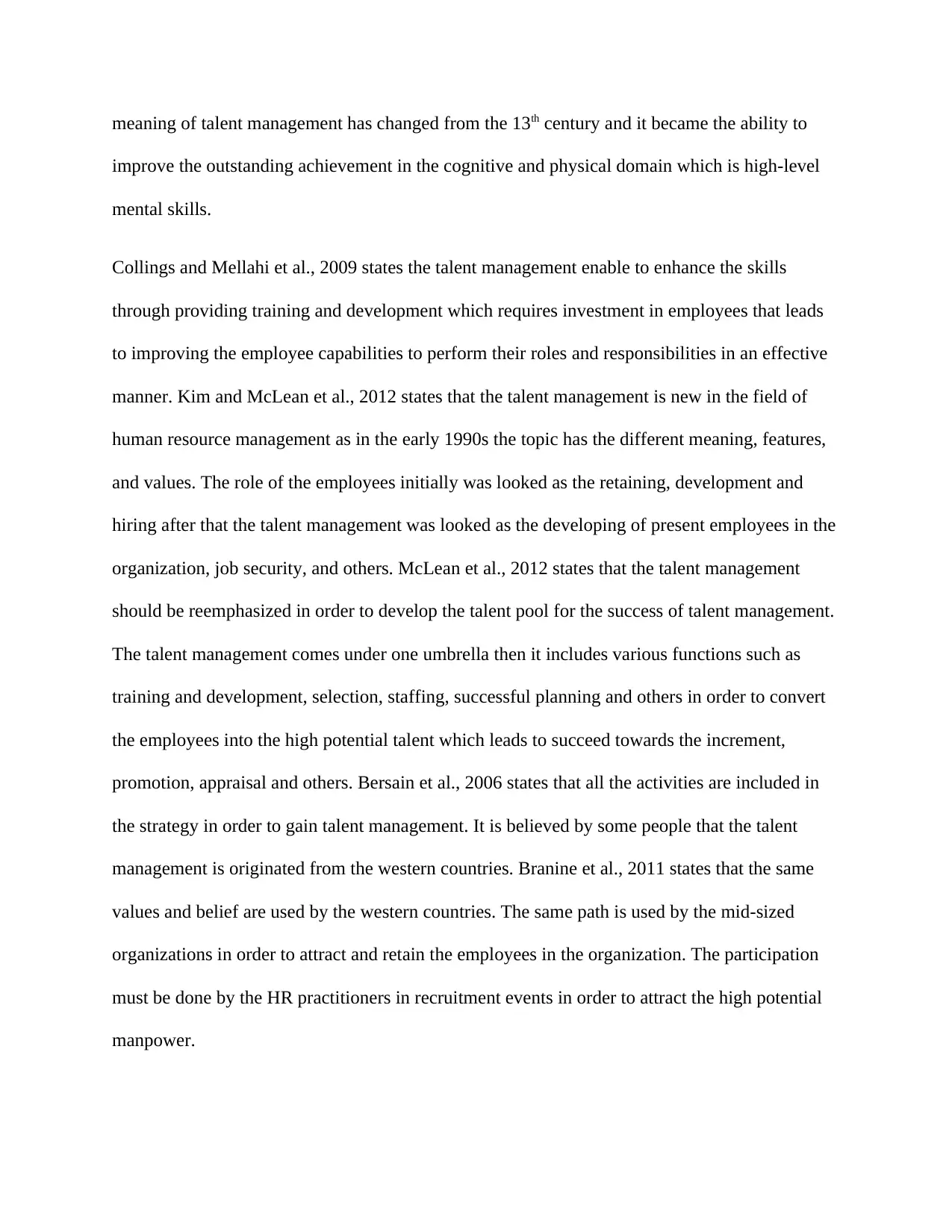
meaning of talent management has changed from the 13th century and it became the ability to
improve the outstanding achievement in the cognitive and physical domain which is high-level
mental skills.
Collings and Mellahi et al., 2009 states the talent management enable to enhance the skills
through providing training and development which requires investment in employees that leads
to improving the employee capabilities to perform their roles and responsibilities in an effective
manner. Kim and McLean et al., 2012 states that the talent management is new in the field of
human resource management as in the early 1990s the topic has the different meaning, features,
and values. The role of the employees initially was looked as the retaining, development and
hiring after that the talent management was looked as the developing of present employees in the
organization, job security, and others. McLean et al., 2012 states that the talent management
should be reemphasized in order to develop the talent pool for the success of talent management.
The talent management comes under one umbrella then it includes various functions such as
training and development, selection, staffing, successful planning and others in order to convert
the employees into the high potential talent which leads to succeed towards the increment,
promotion, appraisal and others. Bersain et al., 2006 states that all the activities are included in
the strategy in order to gain talent management. It is believed by some people that the talent
management is originated from the western countries. Branine et al., 2011 states that the same
values and belief are used by the western countries. The same path is used by the mid-sized
organizations in order to attract and retain the employees in the organization. The participation
must be done by the HR practitioners in recruitment events in order to attract the high potential
manpower.
improve the outstanding achievement in the cognitive and physical domain which is high-level
mental skills.
Collings and Mellahi et al., 2009 states the talent management enable to enhance the skills
through providing training and development which requires investment in employees that leads
to improving the employee capabilities to perform their roles and responsibilities in an effective
manner. Kim and McLean et al., 2012 states that the talent management is new in the field of
human resource management as in the early 1990s the topic has the different meaning, features,
and values. The role of the employees initially was looked as the retaining, development and
hiring after that the talent management was looked as the developing of present employees in the
organization, job security, and others. McLean et al., 2012 states that the talent management
should be reemphasized in order to develop the talent pool for the success of talent management.
The talent management comes under one umbrella then it includes various functions such as
training and development, selection, staffing, successful planning and others in order to convert
the employees into the high potential talent which leads to succeed towards the increment,
promotion, appraisal and others. Bersain et al., 2006 states that all the activities are included in
the strategy in order to gain talent management. It is believed by some people that the talent
management is originated from the western countries. Branine et al., 2011 states that the same
values and belief are used by the western countries. The same path is used by the mid-sized
organizations in order to attract and retain the employees in the organization. The participation
must be done by the HR practitioners in recruitment events in order to attract the high potential
manpower.
Secure Best Marks with AI Grader
Need help grading? Try our AI Grader for instant feedback on your assignments.
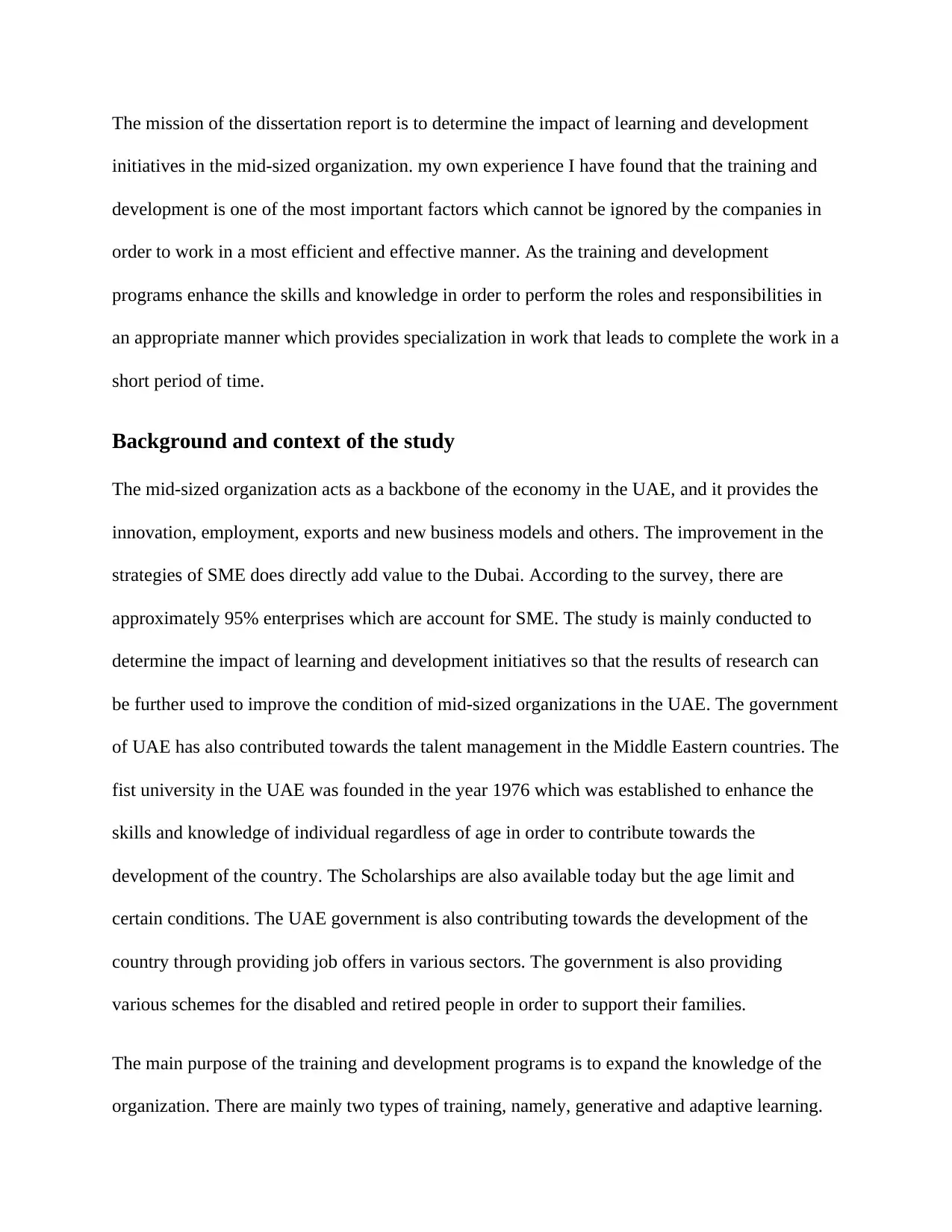
The mission of the dissertation report is to determine the impact of learning and development
initiatives in the mid-sized organization. my own experience I have found that the training and
development is one of the most important factors which cannot be ignored by the companies in
order to work in a most efficient and effective manner. As the training and development
programs enhance the skills and knowledge in order to perform the roles and responsibilities in
an appropriate manner which provides specialization in work that leads to complete the work in a
short period of time.
Background and context of the study
The mid-sized organization acts as a backbone of the economy in the UAE, and it provides the
innovation, employment, exports and new business models and others. The improvement in the
strategies of SME does directly add value to the Dubai. According to the survey, there are
approximately 95% enterprises which are account for SME. The study is mainly conducted to
determine the impact of learning and development initiatives so that the results of research can
be further used to improve the condition of mid-sized organizations in the UAE. The government
of UAE has also contributed towards the talent management in the Middle Eastern countries. The
fist university in the UAE was founded in the year 1976 which was established to enhance the
skills and knowledge of individual regardless of age in order to contribute towards the
development of the country. The Scholarships are also available today but the age limit and
certain conditions. The UAE government is also contributing towards the development of the
country through providing job offers in various sectors. The government is also providing
various schemes for the disabled and retired people in order to support their families.
The main purpose of the training and development programs is to expand the knowledge of the
organization. There are mainly two types of training, namely, generative and adaptive learning.
initiatives in the mid-sized organization. my own experience I have found that the training and
development is one of the most important factors which cannot be ignored by the companies in
order to work in a most efficient and effective manner. As the training and development
programs enhance the skills and knowledge in order to perform the roles and responsibilities in
an appropriate manner which provides specialization in work that leads to complete the work in a
short period of time.
Background and context of the study
The mid-sized organization acts as a backbone of the economy in the UAE, and it provides the
innovation, employment, exports and new business models and others. The improvement in the
strategies of SME does directly add value to the Dubai. According to the survey, there are
approximately 95% enterprises which are account for SME. The study is mainly conducted to
determine the impact of learning and development initiatives so that the results of research can
be further used to improve the condition of mid-sized organizations in the UAE. The government
of UAE has also contributed towards the talent management in the Middle Eastern countries. The
fist university in the UAE was founded in the year 1976 which was established to enhance the
skills and knowledge of individual regardless of age in order to contribute towards the
development of the country. The Scholarships are also available today but the age limit and
certain conditions. The UAE government is also contributing towards the development of the
country through providing job offers in various sectors. The government is also providing
various schemes for the disabled and retired people in order to support their families.
The main purpose of the training and development programs is to expand the knowledge of the
organization. There are mainly two types of training, namely, generative and adaptive learning.
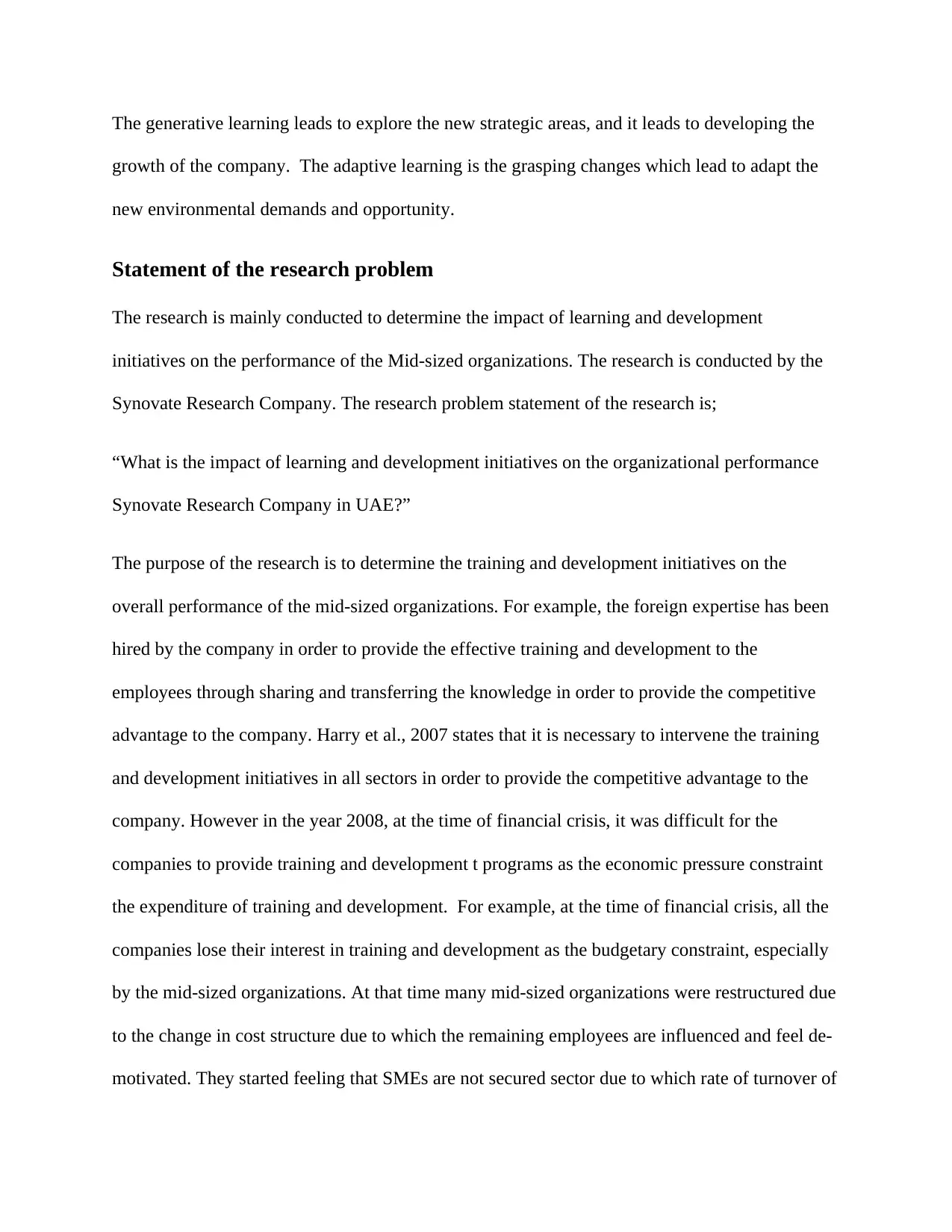
The generative learning leads to explore the new strategic areas, and it leads to developing the
growth of the company. The adaptive learning is the grasping changes which lead to adapt the
new environmental demands and opportunity.
Statement of the research problem
The research is mainly conducted to determine the impact of learning and development
initiatives on the performance of the Mid-sized organizations. The research is conducted by the
Synovate Research Company. The research problem statement of the research is;
“What is the impact of learning and development initiatives on the organizational performance
Synovate Research Company in UAE?”
The purpose of the research is to determine the training and development initiatives on the
overall performance of the mid-sized organizations. For example, the foreign expertise has been
hired by the company in order to provide the effective training and development to the
employees through sharing and transferring the knowledge in order to provide the competitive
advantage to the company. Harry et al., 2007 states that it is necessary to intervene the training
and development initiatives in all sectors in order to provide the competitive advantage to the
company. However in the year 2008, at the time of financial crisis, it was difficult for the
companies to provide training and development t programs as the economic pressure constraint
the expenditure of training and development. For example, at the time of financial crisis, all the
companies lose their interest in training and development as the budgetary constraint, especially
by the mid-sized organizations. At that time many mid-sized organizations were restructured due
to the change in cost structure due to which the remaining employees are influenced and feel de-
motivated. They started feeling that SMEs are not secured sector due to which rate of turnover of
growth of the company. The adaptive learning is the grasping changes which lead to adapt the
new environmental demands and opportunity.
Statement of the research problem
The research is mainly conducted to determine the impact of learning and development
initiatives on the performance of the Mid-sized organizations. The research is conducted by the
Synovate Research Company. The research problem statement of the research is;
“What is the impact of learning and development initiatives on the organizational performance
Synovate Research Company in UAE?”
The purpose of the research is to determine the training and development initiatives on the
overall performance of the mid-sized organizations. For example, the foreign expertise has been
hired by the company in order to provide the effective training and development to the
employees through sharing and transferring the knowledge in order to provide the competitive
advantage to the company. Harry et al., 2007 states that it is necessary to intervene the training
and development initiatives in all sectors in order to provide the competitive advantage to the
company. However in the year 2008, at the time of financial crisis, it was difficult for the
companies to provide training and development t programs as the economic pressure constraint
the expenditure of training and development. For example, at the time of financial crisis, all the
companies lose their interest in training and development as the budgetary constraint, especially
by the mid-sized organizations. At that time many mid-sized organizations were restructured due
to the change in cost structure due to which the remaining employees are influenced and feel de-
motivated. They started feeling that SMEs are not secured sector due to which rate of turnover of
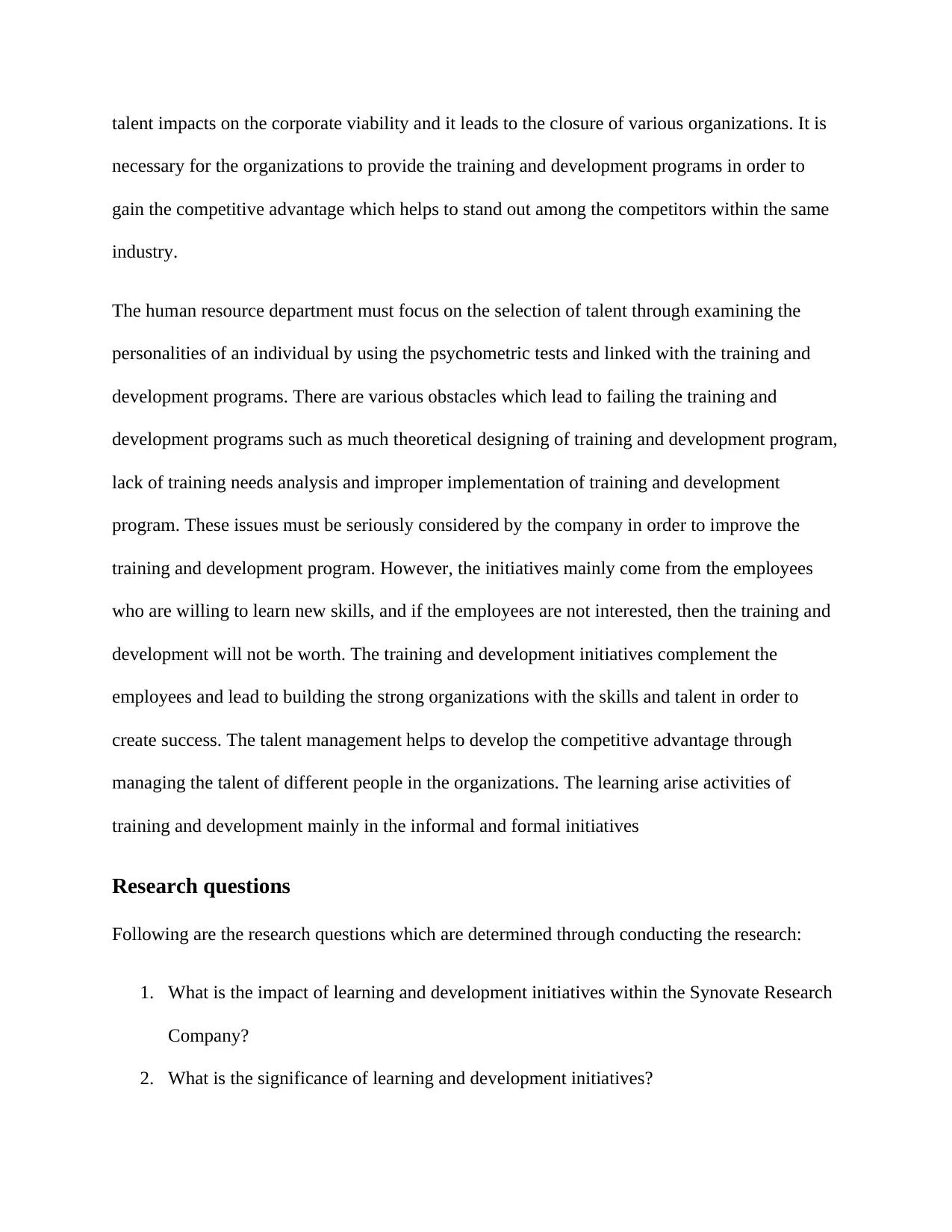
talent impacts on the corporate viability and it leads to the closure of various organizations. It is
necessary for the organizations to provide the training and development programs in order to
gain the competitive advantage which helps to stand out among the competitors within the same
industry.
The human resource department must focus on the selection of talent through examining the
personalities of an individual by using the psychometric tests and linked with the training and
development programs. There are various obstacles which lead to failing the training and
development programs such as much theoretical designing of training and development program,
lack of training needs analysis and improper implementation of training and development
program. These issues must be seriously considered by the company in order to improve the
training and development program. However, the initiatives mainly come from the employees
who are willing to learn new skills, and if the employees are not interested, then the training and
development will not be worth. The training and development initiatives complement the
employees and lead to building the strong organizations with the skills and talent in order to
create success. The talent management helps to develop the competitive advantage through
managing the talent of different people in the organizations. The learning arise activities of
training and development mainly in the informal and formal initiatives
Research questions
Following are the research questions which are determined through conducting the research:
1. What is the impact of learning and development initiatives within the Synovate Research
Company?
2. What is the significance of learning and development initiatives?
necessary for the organizations to provide the training and development programs in order to
gain the competitive advantage which helps to stand out among the competitors within the same
industry.
The human resource department must focus on the selection of talent through examining the
personalities of an individual by using the psychometric tests and linked with the training and
development programs. There are various obstacles which lead to failing the training and
development programs such as much theoretical designing of training and development program,
lack of training needs analysis and improper implementation of training and development
program. These issues must be seriously considered by the company in order to improve the
training and development program. However, the initiatives mainly come from the employees
who are willing to learn new skills, and if the employees are not interested, then the training and
development will not be worth. The training and development initiatives complement the
employees and lead to building the strong organizations with the skills and talent in order to
create success. The talent management helps to develop the competitive advantage through
managing the talent of different people in the organizations. The learning arise activities of
training and development mainly in the informal and formal initiatives
Research questions
Following are the research questions which are determined through conducting the research:
1. What is the impact of learning and development initiatives within the Synovate Research
Company?
2. What is the significance of learning and development initiatives?
Paraphrase This Document
Need a fresh take? Get an instant paraphrase of this document with our AI Paraphraser
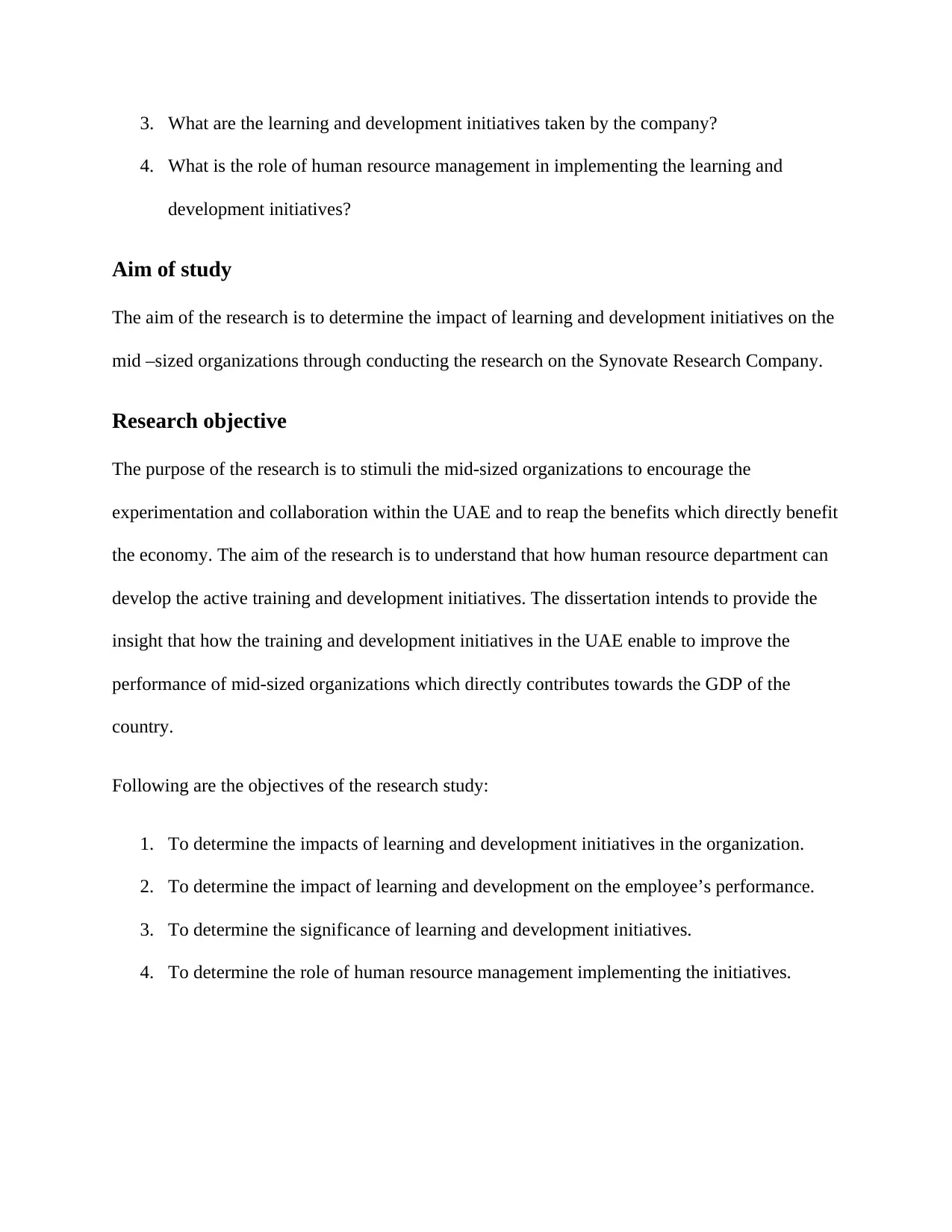
3. What are the learning and development initiatives taken by the company?
4. What is the role of human resource management in implementing the learning and
development initiatives?
Aim of study
The aim of the research is to determine the impact of learning and development initiatives on the
mid –sized organizations through conducting the research on the Synovate Research Company.
Research objective
The purpose of the research is to stimuli the mid-sized organizations to encourage the
experimentation and collaboration within the UAE and to reap the benefits which directly benefit
the economy. The aim of the research is to understand that how human resource department can
develop the active training and development initiatives. The dissertation intends to provide the
insight that how the training and development initiatives in the UAE enable to improve the
performance of mid-sized organizations which directly contributes towards the GDP of the
country.
Following are the objectives of the research study:
1. To determine the impacts of learning and development initiatives in the organization.
2. To determine the impact of learning and development on the employee’s performance.
3. To determine the significance of learning and development initiatives.
4. To determine the role of human resource management implementing the initiatives.
4. What is the role of human resource management in implementing the learning and
development initiatives?
Aim of study
The aim of the research is to determine the impact of learning and development initiatives on the
mid –sized organizations through conducting the research on the Synovate Research Company.
Research objective
The purpose of the research is to stimuli the mid-sized organizations to encourage the
experimentation and collaboration within the UAE and to reap the benefits which directly benefit
the economy. The aim of the research is to understand that how human resource department can
develop the active training and development initiatives. The dissertation intends to provide the
insight that how the training and development initiatives in the UAE enable to improve the
performance of mid-sized organizations which directly contributes towards the GDP of the
country.
Following are the objectives of the research study:
1. To determine the impacts of learning and development initiatives in the organization.
2. To determine the impact of learning and development on the employee’s performance.
3. To determine the significance of learning and development initiatives.
4. To determine the role of human resource management implementing the initiatives.
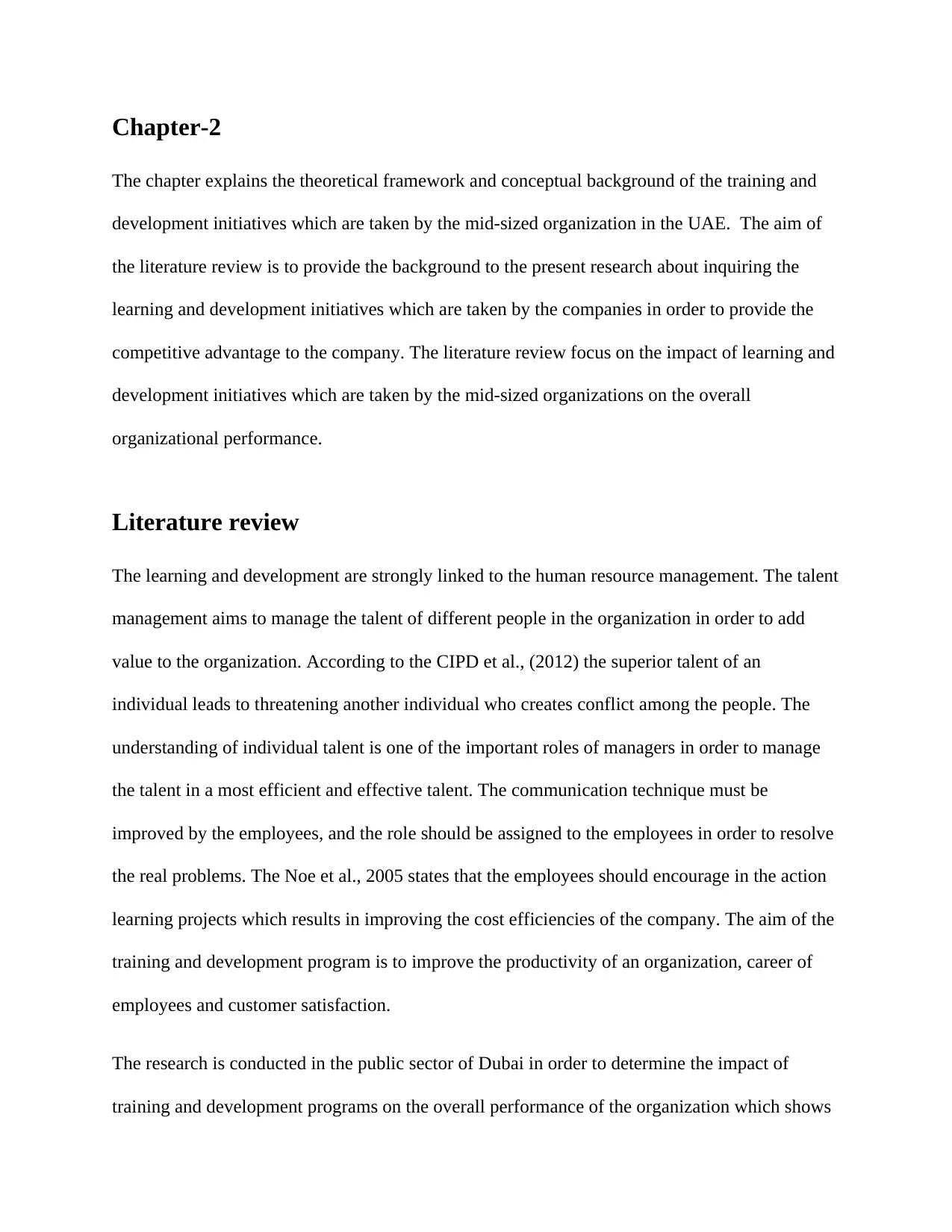
Chapter-2
The chapter explains the theoretical framework and conceptual background of the training and
development initiatives which are taken by the mid-sized organization in the UAE. The aim of
the literature review is to provide the background to the present research about inquiring the
learning and development initiatives which are taken by the companies in order to provide the
competitive advantage to the company. The literature review focus on the impact of learning and
development initiatives which are taken by the mid-sized organizations on the overall
organizational performance.
Literature review
The learning and development are strongly linked to the human resource management. The talent
management aims to manage the talent of different people in the organization in order to add
value to the organization. According to the CIPD et al., (2012) the superior talent of an
individual leads to threatening another individual who creates conflict among the people. The
understanding of individual talent is one of the important roles of managers in order to manage
the talent in a most efficient and effective talent. The communication technique must be
improved by the employees, and the role should be assigned to the employees in order to resolve
the real problems. The Noe et al., 2005 states that the employees should encourage in the action
learning projects which results in improving the cost efficiencies of the company. The aim of the
training and development program is to improve the productivity of an organization, career of
employees and customer satisfaction.
The research is conducted in the public sector of Dubai in order to determine the impact of
training and development programs on the overall performance of the organization which shows
The chapter explains the theoretical framework and conceptual background of the training and
development initiatives which are taken by the mid-sized organization in the UAE. The aim of
the literature review is to provide the background to the present research about inquiring the
learning and development initiatives which are taken by the companies in order to provide the
competitive advantage to the company. The literature review focus on the impact of learning and
development initiatives which are taken by the mid-sized organizations on the overall
organizational performance.
Literature review
The learning and development are strongly linked to the human resource management. The talent
management aims to manage the talent of different people in the organization in order to add
value to the organization. According to the CIPD et al., (2012) the superior talent of an
individual leads to threatening another individual who creates conflict among the people. The
understanding of individual talent is one of the important roles of managers in order to manage
the talent in a most efficient and effective talent. The communication technique must be
improved by the employees, and the role should be assigned to the employees in order to resolve
the real problems. The Noe et al., 2005 states that the employees should encourage in the action
learning projects which results in improving the cost efficiencies of the company. The aim of the
training and development program is to improve the productivity of an organization, career of
employees and customer satisfaction.
The research is conducted in the public sector of Dubai in order to determine the impact of
training and development programs on the overall performance of the organization which shows
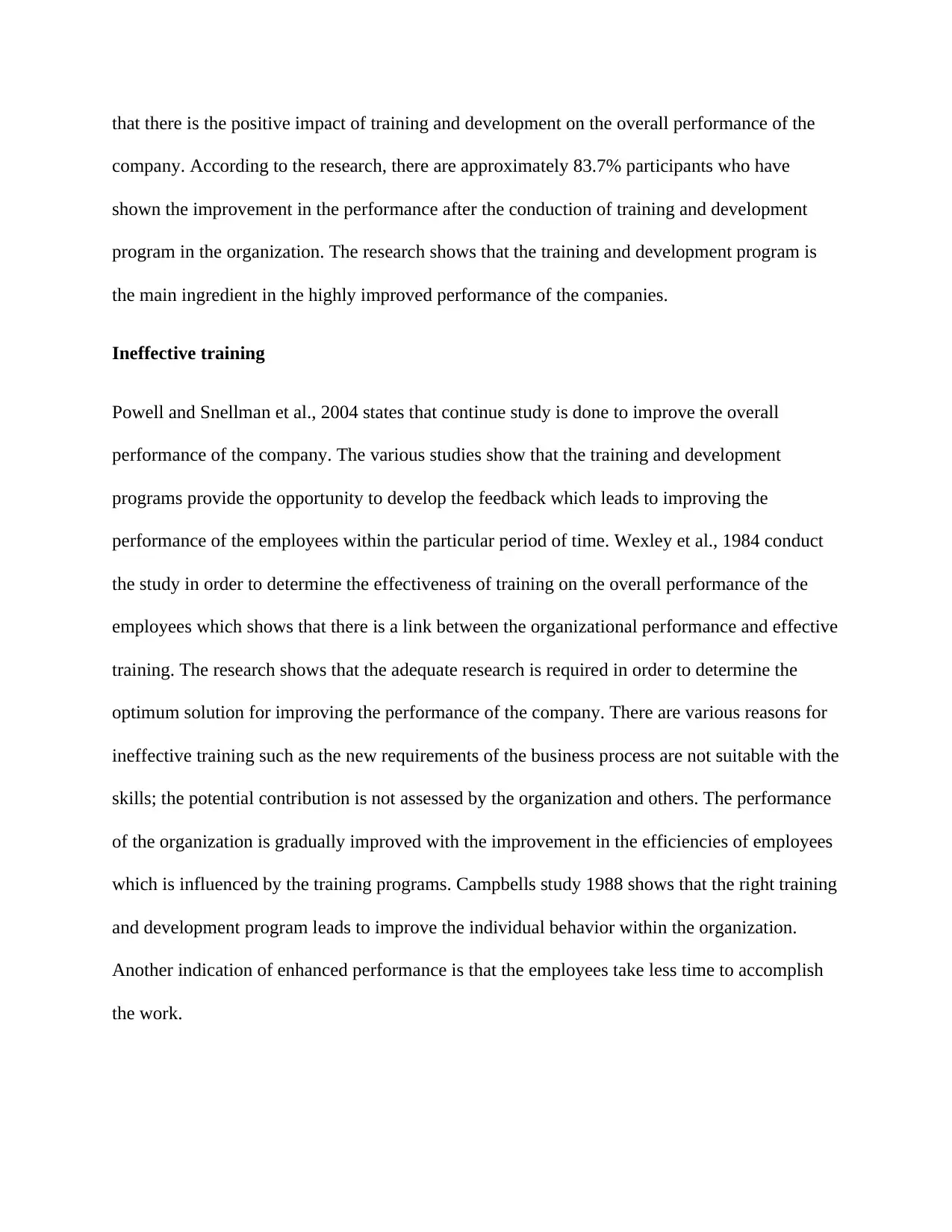
that there is the positive impact of training and development on the overall performance of the
company. According to the research, there are approximately 83.7% participants who have
shown the improvement in the performance after the conduction of training and development
program in the organization. The research shows that the training and development program is
the main ingredient in the highly improved performance of the companies.
Ineffective training
Powell and Snellman et al., 2004 states that continue study is done to improve the overall
performance of the company. The various studies show that the training and development
programs provide the opportunity to develop the feedback which leads to improving the
performance of the employees within the particular period of time. Wexley et al., 1984 conduct
the study in order to determine the effectiveness of training on the overall performance of the
employees which shows that there is a link between the organizational performance and effective
training. The research shows that the adequate research is required in order to determine the
optimum solution for improving the performance of the company. There are various reasons for
ineffective training such as the new requirements of the business process are not suitable with the
skills; the potential contribution is not assessed by the organization and others. The performance
of the organization is gradually improved with the improvement in the efficiencies of employees
which is influenced by the training programs. Campbells study 1988 shows that the right training
and development program leads to improve the individual behavior within the organization.
Another indication of enhanced performance is that the employees take less time to accomplish
the work.
company. According to the research, there are approximately 83.7% participants who have
shown the improvement in the performance after the conduction of training and development
program in the organization. The research shows that the training and development program is
the main ingredient in the highly improved performance of the companies.
Ineffective training
Powell and Snellman et al., 2004 states that continue study is done to improve the overall
performance of the company. The various studies show that the training and development
programs provide the opportunity to develop the feedback which leads to improving the
performance of the employees within the particular period of time. Wexley et al., 1984 conduct
the study in order to determine the effectiveness of training on the overall performance of the
employees which shows that there is a link between the organizational performance and effective
training. The research shows that the adequate research is required in order to determine the
optimum solution for improving the performance of the company. There are various reasons for
ineffective training such as the new requirements of the business process are not suitable with the
skills; the potential contribution is not assessed by the organization and others. The performance
of the organization is gradually improved with the improvement in the efficiencies of employees
which is influenced by the training programs. Campbells study 1988 shows that the right training
and development program leads to improve the individual behavior within the organization.
Another indication of enhanced performance is that the employees take less time to accomplish
the work.
Secure Best Marks with AI Grader
Need help grading? Try our AI Grader for instant feedback on your assignments.
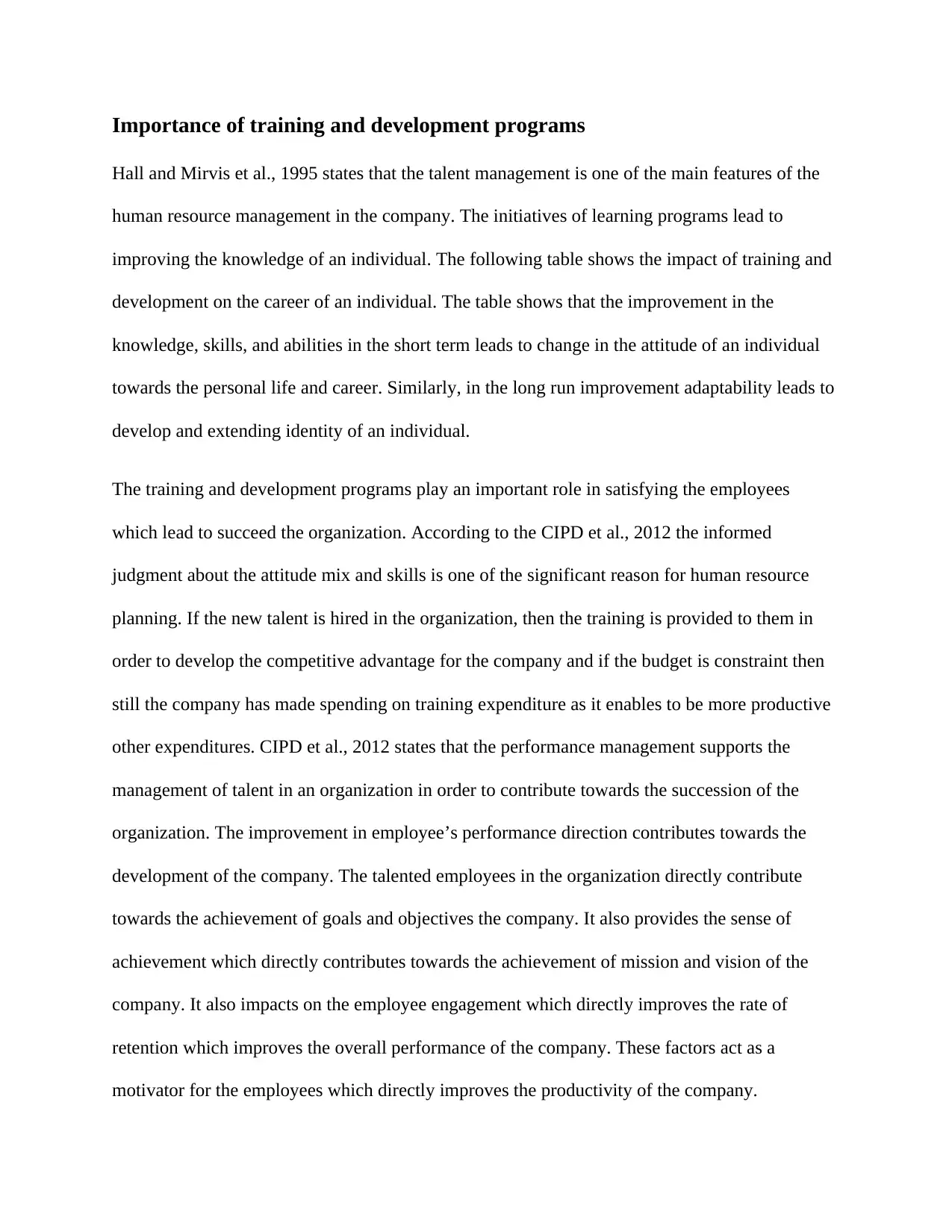
Importance of training and development programs
Hall and Mirvis et al., 1995 states that the talent management is one of the main features of the
human resource management in the company. The initiatives of learning programs lead to
improving the knowledge of an individual. The following table shows the impact of training and
development on the career of an individual. The table shows that the improvement in the
knowledge, skills, and abilities in the short term leads to change in the attitude of an individual
towards the personal life and career. Similarly, in the long run improvement adaptability leads to
develop and extending identity of an individual.
The training and development programs play an important role in satisfying the employees
which lead to succeed the organization. According to the CIPD et al., 2012 the informed
judgment about the attitude mix and skills is one of the significant reason for human resource
planning. If the new talent is hired in the organization, then the training is provided to them in
order to develop the competitive advantage for the company and if the budget is constraint then
still the company has made spending on training expenditure as it enables to be more productive
other expenditures. CIPD et al., 2012 states that the performance management supports the
management of talent in an organization in order to contribute towards the succession of the
organization. The improvement in employee’s performance direction contributes towards the
development of the company. The talented employees in the organization directly contribute
towards the achievement of goals and objectives the company. It also provides the sense of
achievement which directly contributes towards the achievement of mission and vision of the
company. It also impacts on the employee engagement which directly improves the rate of
retention which improves the overall performance of the company. These factors act as a
motivator for the employees which directly improves the productivity of the company.
Hall and Mirvis et al., 1995 states that the talent management is one of the main features of the
human resource management in the company. The initiatives of learning programs lead to
improving the knowledge of an individual. The following table shows the impact of training and
development on the career of an individual. The table shows that the improvement in the
knowledge, skills, and abilities in the short term leads to change in the attitude of an individual
towards the personal life and career. Similarly, in the long run improvement adaptability leads to
develop and extending identity of an individual.
The training and development programs play an important role in satisfying the employees
which lead to succeed the organization. According to the CIPD et al., 2012 the informed
judgment about the attitude mix and skills is one of the significant reason for human resource
planning. If the new talent is hired in the organization, then the training is provided to them in
order to develop the competitive advantage for the company and if the budget is constraint then
still the company has made spending on training expenditure as it enables to be more productive
other expenditures. CIPD et al., 2012 states that the performance management supports the
management of talent in an organization in order to contribute towards the succession of the
organization. The improvement in employee’s performance direction contributes towards the
development of the company. The talented employees in the organization directly contribute
towards the achievement of goals and objectives the company. It also provides the sense of
achievement which directly contributes towards the achievement of mission and vision of the
company. It also impacts on the employee engagement which directly improves the rate of
retention which improves the overall performance of the company. These factors act as a
motivator for the employees which directly improves the productivity of the company.
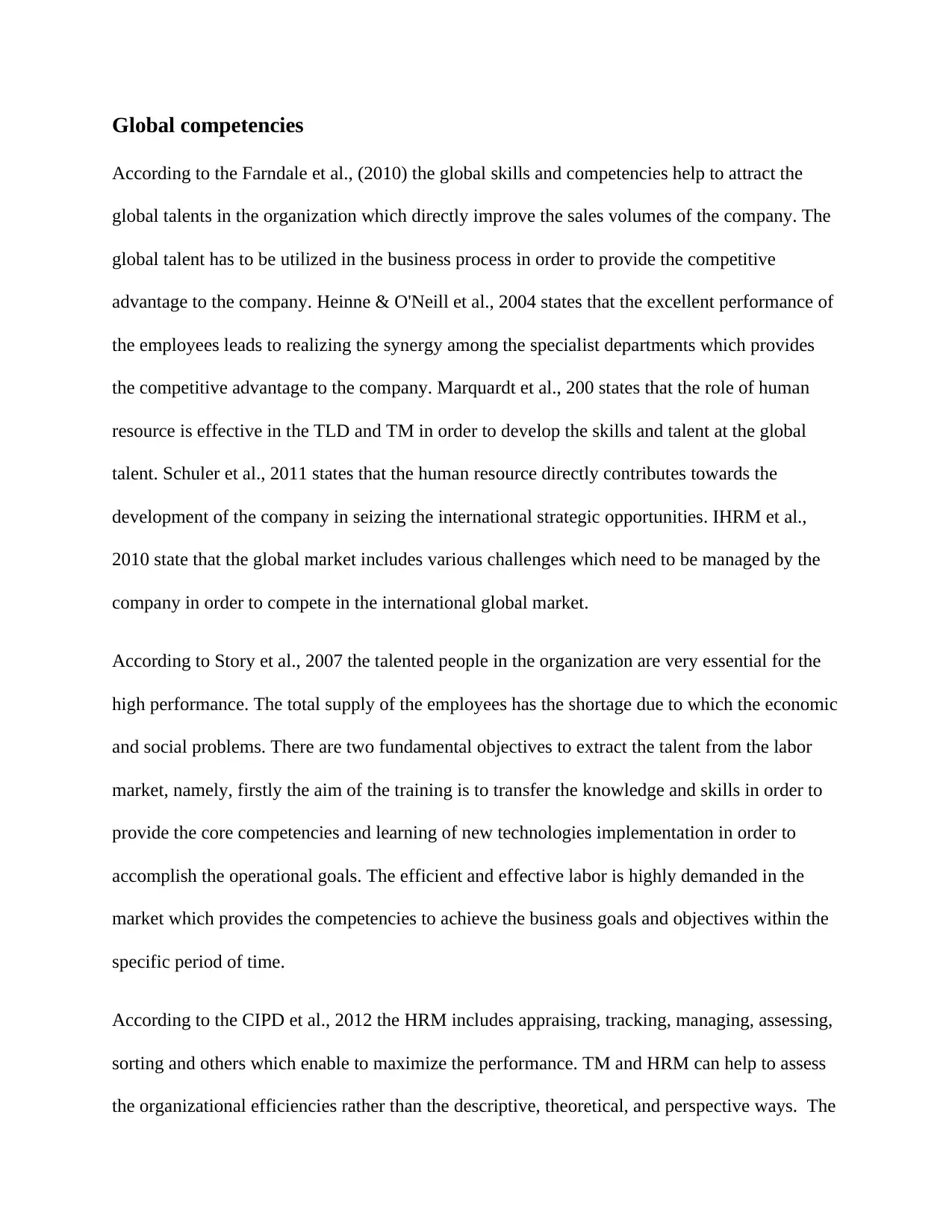
Global competencies
According to the Farndale et al., (2010) the global skills and competencies help to attract the
global talents in the organization which directly improve the sales volumes of the company. The
global talent has to be utilized in the business process in order to provide the competitive
advantage to the company. Heinne & O'Neill et al., 2004 states that the excellent performance of
the employees leads to realizing the synergy among the specialist departments which provides
the competitive advantage to the company. Marquardt et al., 200 states that the role of human
resource is effective in the TLD and TM in order to develop the skills and talent at the global
talent. Schuler et al., 2011 states that the human resource directly contributes towards the
development of the company in seizing the international strategic opportunities. IHRM et al.,
2010 state that the global market includes various challenges which need to be managed by the
company in order to compete in the international global market.
According to Story et al., 2007 the talented people in the organization are very essential for the
high performance. The total supply of the employees has the shortage due to which the economic
and social problems. There are two fundamental objectives to extract the talent from the labor
market, namely, firstly the aim of the training is to transfer the knowledge and skills in order to
provide the core competencies and learning of new technologies implementation in order to
accomplish the operational goals. The efficient and effective labor is highly demanded in the
market which provides the competencies to achieve the business goals and objectives within the
specific period of time.
According to the CIPD et al., 2012 the HRM includes appraising, tracking, managing, assessing,
sorting and others which enable to maximize the performance. TM and HRM can help to assess
the organizational efficiencies rather than the descriptive, theoretical, and perspective ways. The
According to the Farndale et al., (2010) the global skills and competencies help to attract the
global talents in the organization which directly improve the sales volumes of the company. The
global talent has to be utilized in the business process in order to provide the competitive
advantage to the company. Heinne & O'Neill et al., 2004 states that the excellent performance of
the employees leads to realizing the synergy among the specialist departments which provides
the competitive advantage to the company. Marquardt et al., 200 states that the role of human
resource is effective in the TLD and TM in order to develop the skills and talent at the global
talent. Schuler et al., 2011 states that the human resource directly contributes towards the
development of the company in seizing the international strategic opportunities. IHRM et al.,
2010 state that the global market includes various challenges which need to be managed by the
company in order to compete in the international global market.
According to Story et al., 2007 the talented people in the organization are very essential for the
high performance. The total supply of the employees has the shortage due to which the economic
and social problems. There are two fundamental objectives to extract the talent from the labor
market, namely, firstly the aim of the training is to transfer the knowledge and skills in order to
provide the core competencies and learning of new technologies implementation in order to
accomplish the operational goals. The efficient and effective labor is highly demanded in the
market which provides the competencies to achieve the business goals and objectives within the
specific period of time.
According to the CIPD et al., 2012 the HRM includes appraising, tracking, managing, assessing,
sorting and others which enable to maximize the performance. TM and HRM can help to assess
the organizational efficiencies rather than the descriptive, theoretical, and perspective ways. The
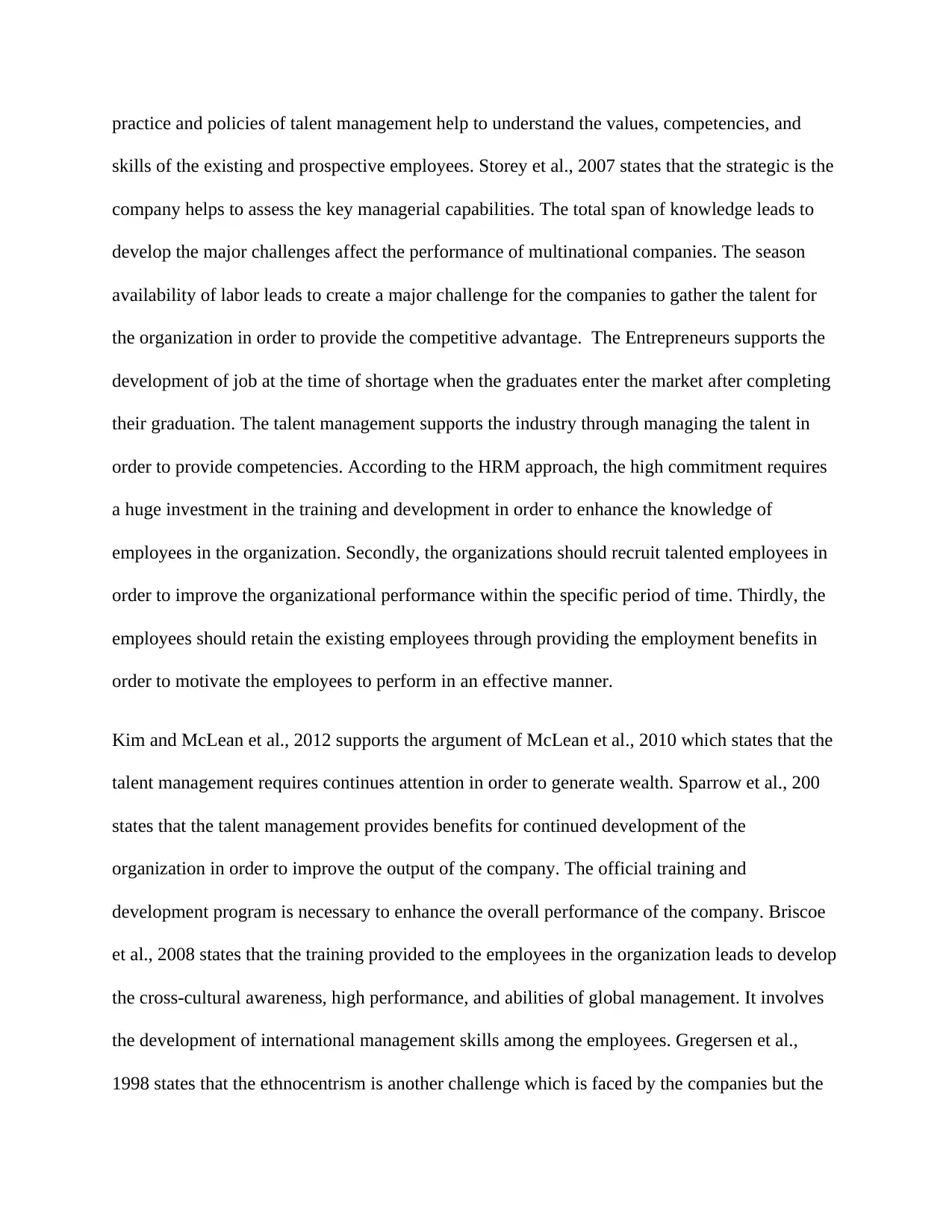
practice and policies of talent management help to understand the values, competencies, and
skills of the existing and prospective employees. Storey et al., 2007 states that the strategic is the
company helps to assess the key managerial capabilities. The total span of knowledge leads to
develop the major challenges affect the performance of multinational companies. The season
availability of labor leads to create a major challenge for the companies to gather the talent for
the organization in order to provide the competitive advantage. The Entrepreneurs supports the
development of job at the time of shortage when the graduates enter the market after completing
their graduation. The talent management supports the industry through managing the talent in
order to provide competencies. According to the HRM approach, the high commitment requires
a huge investment in the training and development in order to enhance the knowledge of
employees in the organization. Secondly, the organizations should recruit talented employees in
order to improve the organizational performance within the specific period of time. Thirdly, the
employees should retain the existing employees through providing the employment benefits in
order to motivate the employees to perform in an effective manner.
Kim and McLean et al., 2012 supports the argument of McLean et al., 2010 which states that the
talent management requires continues attention in order to generate wealth. Sparrow et al., 200
states that the talent management provides benefits for continued development of the
organization in order to improve the output of the company. The official training and
development program is necessary to enhance the overall performance of the company. Briscoe
et al., 2008 states that the training provided to the employees in the organization leads to develop
the cross-cultural awareness, high performance, and abilities of global management. It involves
the development of international management skills among the employees. Gregersen et al.,
1998 states that the ethnocentrism is another challenge which is faced by the companies but the
skills of the existing and prospective employees. Storey et al., 2007 states that the strategic is the
company helps to assess the key managerial capabilities. The total span of knowledge leads to
develop the major challenges affect the performance of multinational companies. The season
availability of labor leads to create a major challenge for the companies to gather the talent for
the organization in order to provide the competitive advantage. The Entrepreneurs supports the
development of job at the time of shortage when the graduates enter the market after completing
their graduation. The talent management supports the industry through managing the talent in
order to provide competencies. According to the HRM approach, the high commitment requires
a huge investment in the training and development in order to enhance the knowledge of
employees in the organization. Secondly, the organizations should recruit talented employees in
order to improve the organizational performance within the specific period of time. Thirdly, the
employees should retain the existing employees through providing the employment benefits in
order to motivate the employees to perform in an effective manner.
Kim and McLean et al., 2012 supports the argument of McLean et al., 2010 which states that the
talent management requires continues attention in order to generate wealth. Sparrow et al., 200
states that the talent management provides benefits for continued development of the
organization in order to improve the output of the company. The official training and
development program is necessary to enhance the overall performance of the company. Briscoe
et al., 2008 states that the training provided to the employees in the organization leads to develop
the cross-cultural awareness, high performance, and abilities of global management. It involves
the development of international management skills among the employees. Gregersen et al.,
1998 states that the ethnocentrism is another challenge which is faced by the companies but the
Paraphrase This Document
Need a fresh take? Get an instant paraphrase of this document with our AI Paraphraser
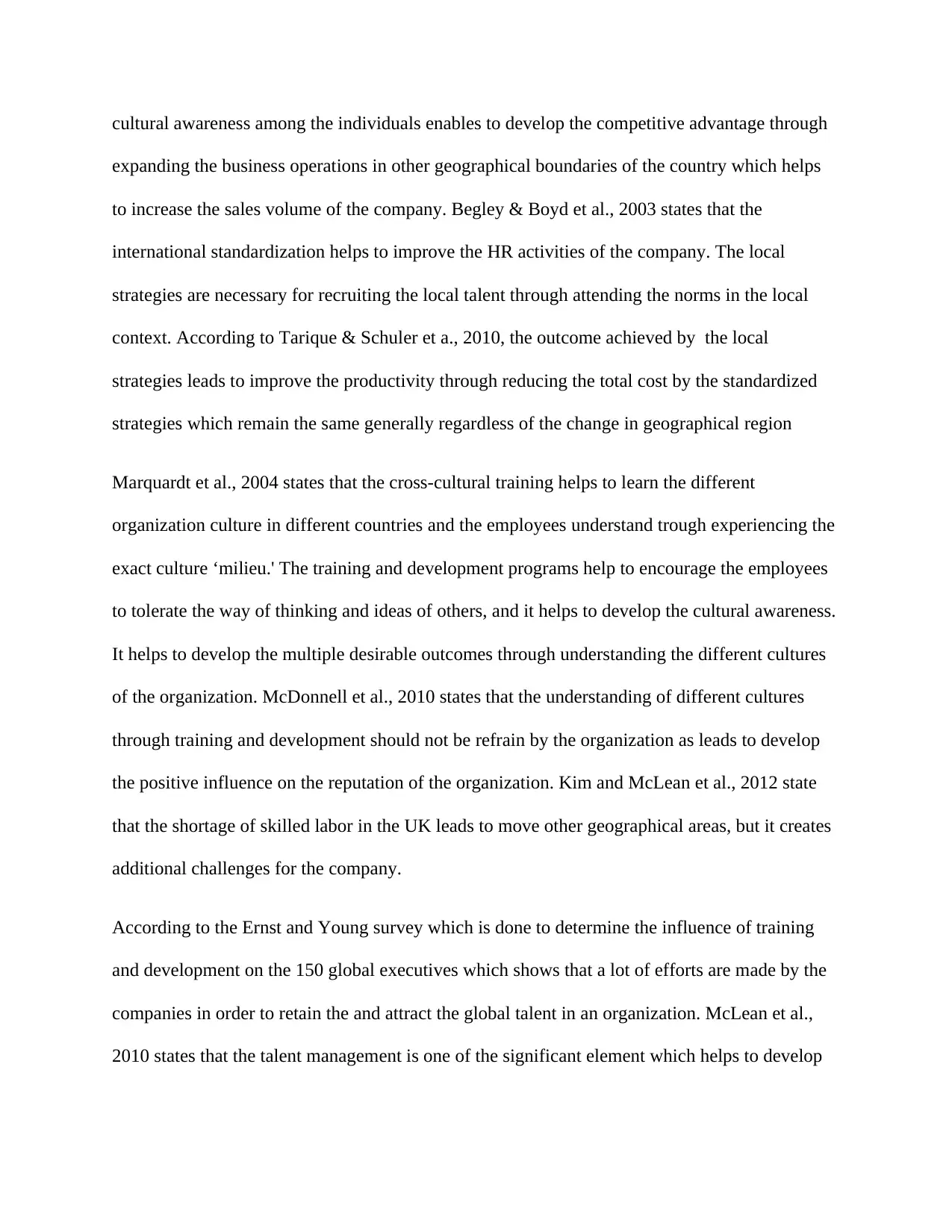
cultural awareness among the individuals enables to develop the competitive advantage through
expanding the business operations in other geographical boundaries of the country which helps
to increase the sales volume of the company. Begley & Boyd et al., 2003 states that the
international standardization helps to improve the HR activities of the company. The local
strategies are necessary for recruiting the local talent through attending the norms in the local
context. According to Tarique & Schuler et a., 2010, the outcome achieved by the local
strategies leads to improve the productivity through reducing the total cost by the standardized
strategies which remain the same generally regardless of the change in geographical region
Marquardt et al., 2004 states that the cross-cultural training helps to learn the different
organization culture in different countries and the employees understand trough experiencing the
exact culture ‘milieu.' The training and development programs help to encourage the employees
to tolerate the way of thinking and ideas of others, and it helps to develop the cultural awareness.
It helps to develop the multiple desirable outcomes through understanding the different cultures
of the organization. McDonnell et al., 2010 states that the understanding of different cultures
through training and development should not be refrain by the organization as leads to develop
the positive influence on the reputation of the organization. Kim and McLean et al., 2012 state
that the shortage of skilled labor in the UK leads to move other geographical areas, but it creates
additional challenges for the company.
According to the Ernst and Young survey which is done to determine the influence of training
and development on the 150 global executives which shows that a lot of efforts are made by the
companies in order to retain the and attract the global talent in an organization. McLean et al.,
2010 states that the talent management is one of the significant element which helps to develop
expanding the business operations in other geographical boundaries of the country which helps
to increase the sales volume of the company. Begley & Boyd et al., 2003 states that the
international standardization helps to improve the HR activities of the company. The local
strategies are necessary for recruiting the local talent through attending the norms in the local
context. According to Tarique & Schuler et a., 2010, the outcome achieved by the local
strategies leads to improve the productivity through reducing the total cost by the standardized
strategies which remain the same generally regardless of the change in geographical region
Marquardt et al., 2004 states that the cross-cultural training helps to learn the different
organization culture in different countries and the employees understand trough experiencing the
exact culture ‘milieu.' The training and development programs help to encourage the employees
to tolerate the way of thinking and ideas of others, and it helps to develop the cultural awareness.
It helps to develop the multiple desirable outcomes through understanding the different cultures
of the organization. McDonnell et al., 2010 states that the understanding of different cultures
through training and development should not be refrain by the organization as leads to develop
the positive influence on the reputation of the organization. Kim and McLean et al., 2012 state
that the shortage of skilled labor in the UK leads to move other geographical areas, but it creates
additional challenges for the company.
According to the Ernst and Young survey which is done to determine the influence of training
and development on the 150 global executives which shows that a lot of efforts are made by the
companies in order to retain the and attract the global talent in an organization. McLean et al.,
2010 states that the talent management is one of the significant element which helps to develop
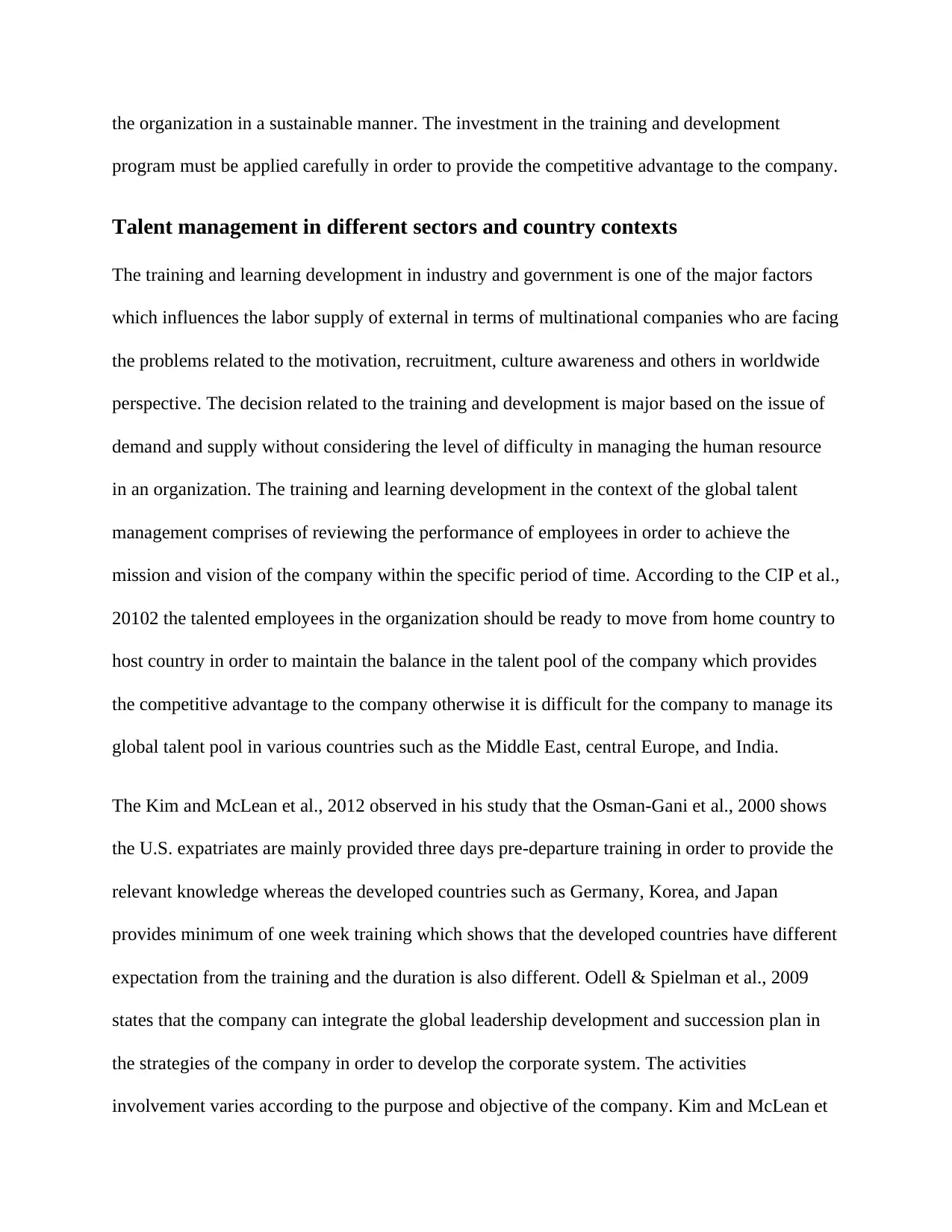
the organization in a sustainable manner. The investment in the training and development
program must be applied carefully in order to provide the competitive advantage to the company.
Talent management in different sectors and country contexts
The training and learning development in industry and government is one of the major factors
which influences the labor supply of external in terms of multinational companies who are facing
the problems related to the motivation, recruitment, culture awareness and others in worldwide
perspective. The decision related to the training and development is major based on the issue of
demand and supply without considering the level of difficulty in managing the human resource
in an organization. The training and learning development in the context of the global talent
management comprises of reviewing the performance of employees in order to achieve the
mission and vision of the company within the specific period of time. According to the CIP et al.,
20102 the talented employees in the organization should be ready to move from home country to
host country in order to maintain the balance in the talent pool of the company which provides
the competitive advantage to the company otherwise it is difficult for the company to manage its
global talent pool in various countries such as the Middle East, central Europe, and India.
The Kim and McLean et al., 2012 observed in his study that the Osman-Gani et al., 2000 shows
the U.S. expatriates are mainly provided three days pre-departure training in order to provide the
relevant knowledge whereas the developed countries such as Germany, Korea, and Japan
provides minimum of one week training which shows that the developed countries have different
expectation from the training and the duration is also different. Odell & Spielman et al., 2009
states that the company can integrate the global leadership development and succession plan in
the strategies of the company in order to develop the corporate system. The activities
involvement varies according to the purpose and objective of the company. Kim and McLean et
program must be applied carefully in order to provide the competitive advantage to the company.
Talent management in different sectors and country contexts
The training and learning development in industry and government is one of the major factors
which influences the labor supply of external in terms of multinational companies who are facing
the problems related to the motivation, recruitment, culture awareness and others in worldwide
perspective. The decision related to the training and development is major based on the issue of
demand and supply without considering the level of difficulty in managing the human resource
in an organization. The training and learning development in the context of the global talent
management comprises of reviewing the performance of employees in order to achieve the
mission and vision of the company within the specific period of time. According to the CIP et al.,
20102 the talented employees in the organization should be ready to move from home country to
host country in order to maintain the balance in the talent pool of the company which provides
the competitive advantage to the company otherwise it is difficult for the company to manage its
global talent pool in various countries such as the Middle East, central Europe, and India.
The Kim and McLean et al., 2012 observed in his study that the Osman-Gani et al., 2000 shows
the U.S. expatriates are mainly provided three days pre-departure training in order to provide the
relevant knowledge whereas the developed countries such as Germany, Korea, and Japan
provides minimum of one week training which shows that the developed countries have different
expectation from the training and the duration is also different. Odell & Spielman et al., 2009
states that the company can integrate the global leadership development and succession plan in
the strategies of the company in order to develop the corporate system. The activities
involvement varies according to the purpose and objective of the company. Kim and McLean et
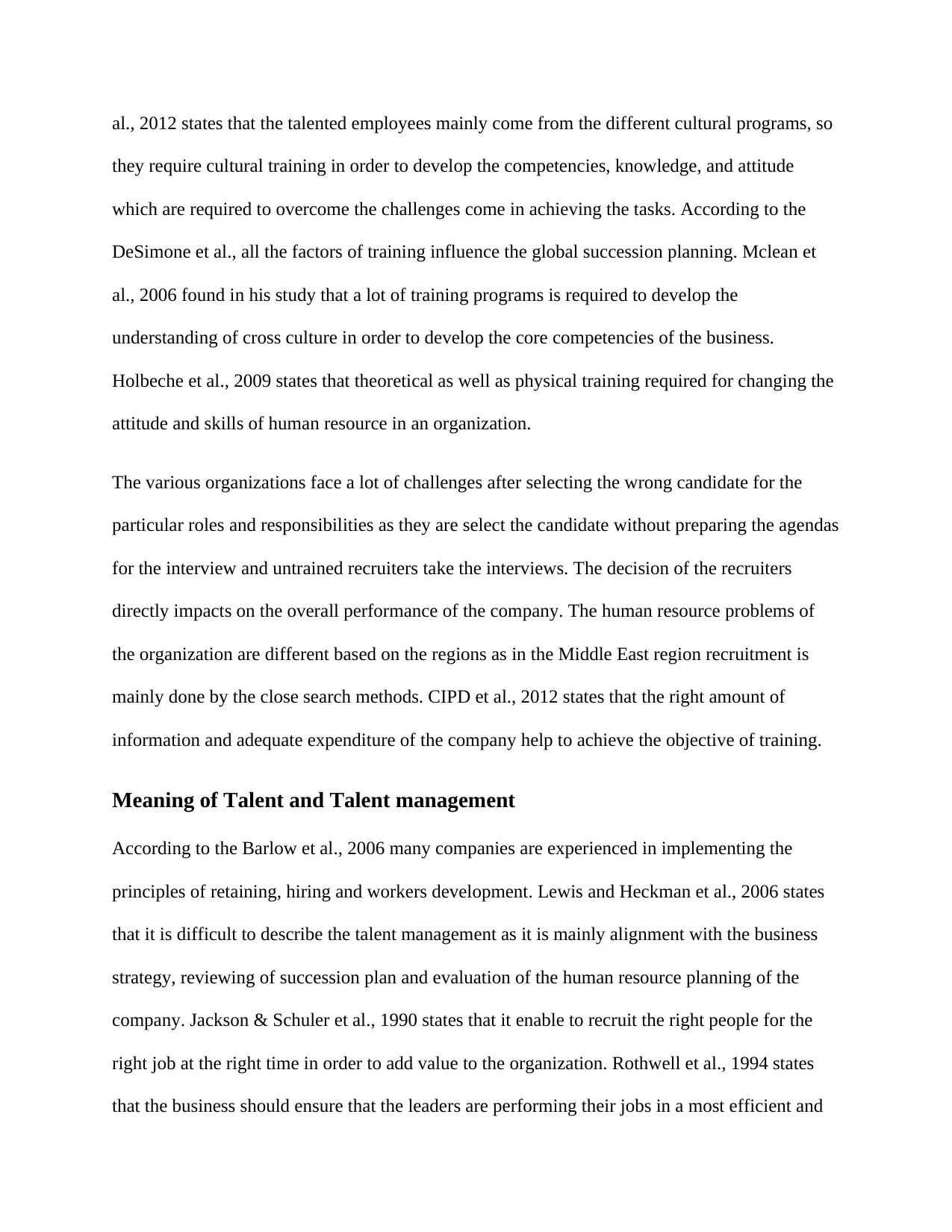
al., 2012 states that the talented employees mainly come from the different cultural programs, so
they require cultural training in order to develop the competencies, knowledge, and attitude
which are required to overcome the challenges come in achieving the tasks. According to the
DeSimone et al., all the factors of training influence the global succession planning. Mclean et
al., 2006 found in his study that a lot of training programs is required to develop the
understanding of cross culture in order to develop the core competencies of the business.
Holbeche et al., 2009 states that theoretical as well as physical training required for changing the
attitude and skills of human resource in an organization.
The various organizations face a lot of challenges after selecting the wrong candidate for the
particular roles and responsibilities as they are select the candidate without preparing the agendas
for the interview and untrained recruiters take the interviews. The decision of the recruiters
directly impacts on the overall performance of the company. The human resource problems of
the organization are different based on the regions as in the Middle East region recruitment is
mainly done by the close search methods. CIPD et al., 2012 states that the right amount of
information and adequate expenditure of the company help to achieve the objective of training.
Meaning of Talent and Talent management
According to the Barlow et al., 2006 many companies are experienced in implementing the
principles of retaining, hiring and workers development. Lewis and Heckman et al., 2006 states
that it is difficult to describe the talent management as it is mainly alignment with the business
strategy, reviewing of succession plan and evaluation of the human resource planning of the
company. Jackson & Schuler et al., 1990 states that it enable to recruit the right people for the
right job at the right time in order to add value to the organization. Rothwell et al., 1994 states
that the business should ensure that the leaders are performing their jobs in a most efficient and
they require cultural training in order to develop the competencies, knowledge, and attitude
which are required to overcome the challenges come in achieving the tasks. According to the
DeSimone et al., all the factors of training influence the global succession planning. Mclean et
al., 2006 found in his study that a lot of training programs is required to develop the
understanding of cross culture in order to develop the core competencies of the business.
Holbeche et al., 2009 states that theoretical as well as physical training required for changing the
attitude and skills of human resource in an organization.
The various organizations face a lot of challenges after selecting the wrong candidate for the
particular roles and responsibilities as they are select the candidate without preparing the agendas
for the interview and untrained recruiters take the interviews. The decision of the recruiters
directly impacts on the overall performance of the company. The human resource problems of
the organization are different based on the regions as in the Middle East region recruitment is
mainly done by the close search methods. CIPD et al., 2012 states that the right amount of
information and adequate expenditure of the company help to achieve the objective of training.
Meaning of Talent and Talent management
According to the Barlow et al., 2006 many companies are experienced in implementing the
principles of retaining, hiring and workers development. Lewis and Heckman et al., 2006 states
that it is difficult to describe the talent management as it is mainly alignment with the business
strategy, reviewing of succession plan and evaluation of the human resource planning of the
company. Jackson & Schuler et al., 1990 states that it enable to recruit the right people for the
right job at the right time in order to add value to the organization. Rothwell et al., 1994 states
that the business should ensure that the leaders are performing their jobs in a most efficient and
Secure Best Marks with AI Grader
Need help grading? Try our AI Grader for instant feedback on your assignments.

effective manner. Pascal et al., 2004 states that the business individual contribution towards the
achievement of strategic goals through optimal response to the issue related to the supply and
demand of resources.
The talent management integrates and aligns with the human resource department into the
business strategy in order to develop the competitive advantage to the company. According to
the CIPD et al., 2009 the talent management is an identification, systematic attraction,
engagement, development, and deployment of the human resource who are having high potential
and that adds value to the organization. The human resource is accountable for the hiring and
recruitment of right people in order to add value to the organization. According to the Hughes &
Rog et al., 2008 the human resource is also responsible for retaining the employees in the
organization and to investment in employees in order to achieve the business objectives. The
awareness must be developed in order to understand the importance of human resources among
the organizations (Real et al., 2014). Storey et al., 2007 states the employer and employees are
connected to achieve the business goals as well as the political goals of organizations.
The line manager must understand the importance of training and development in order to
achieve the success of business through determining the nature of job and how the employee
should perform their roles and responsibilities which enable to reduce the resistance of employee
for the management goals and it emphasize on the learning which motivates the employee to
improve their performance (Dhar et al., 2015). Bratton & Gold et al., 1999 states that the
training, learning, and development help to improve the cognitive skills in the long as well as
short-term period through developing the problem-solving skills, and employee knowledge
among the employees.
achievement of strategic goals through optimal response to the issue related to the supply and
demand of resources.
The talent management integrates and aligns with the human resource department into the
business strategy in order to develop the competitive advantage to the company. According to
the CIPD et al., 2009 the talent management is an identification, systematic attraction,
engagement, development, and deployment of the human resource who are having high potential
and that adds value to the organization. The human resource is accountable for the hiring and
recruitment of right people in order to add value to the organization. According to the Hughes &
Rog et al., 2008 the human resource is also responsible for retaining the employees in the
organization and to investment in employees in order to achieve the business objectives. The
awareness must be developed in order to understand the importance of human resources among
the organizations (Real et al., 2014). Storey et al., 2007 states the employer and employees are
connected to achieve the business goals as well as the political goals of organizations.
The line manager must understand the importance of training and development in order to
achieve the success of business through determining the nature of job and how the employee
should perform their roles and responsibilities which enable to reduce the resistance of employee
for the management goals and it emphasize on the learning which motivates the employee to
improve their performance (Dhar et al., 2015). Bratton & Gold et al., 1999 states that the
training, learning, and development help to improve the cognitive skills in the long as well as
short-term period through developing the problem-solving skills, and employee knowledge
among the employees.

According to the Tansley et al., 2011 the individual performance directly contributes towards the
performance of the company and the high performance of the employees leads to improve the
overall performance of the company. But some theorists argument the new approaches must be
developed by the companies in order to provide better management of talent in an organization
within the specific period of time. Holbeche et al., 2009 states the new talent management
approach should include talent management strategy and strategy execution which comprises of
management, talent acquisition, retention, and development.
According to the Storey et al., 2007 states that the talent management shows high potential
whereas Guthridge et al., 2008 argues that the talent management is a business problem as the
various factors which are connected with the globalization that posed ling term challenges for the
company. However, the planning of labor force and talent management acts as a backbone of
organization which must be included in the business strategies. Cheese et al., 2007 state that the
senior manager and leaders play an important role in the facilitating the system and practices of
talent management. But the clear definition of talent management must be understood by the
company in order to manage the equal talent pool in the various locations of the company.
Boussebaa and Morgan et al., 2008 states that the various challenges are faced by the
multinational companies which show that the understanding of talent is different in each country
(Paillé et al., 2014). The different meaning of programs among the countries leads to the
unsuccessful system and programs of talent management due to the difference in the
misunderstanding in the host and home country. According to the Branine et al., 2011 the
training and development initiatives require helps to manage the talent of employees which
directly contributes towards the organizational performance within the specific time framework.
performance of the company and the high performance of the employees leads to improve the
overall performance of the company. But some theorists argument the new approaches must be
developed by the companies in order to provide better management of talent in an organization
within the specific period of time. Holbeche et al., 2009 states the new talent management
approach should include talent management strategy and strategy execution which comprises of
management, talent acquisition, retention, and development.
According to the Storey et al., 2007 states that the talent management shows high potential
whereas Guthridge et al., 2008 argues that the talent management is a business problem as the
various factors which are connected with the globalization that posed ling term challenges for the
company. However, the planning of labor force and talent management acts as a backbone of
organization which must be included in the business strategies. Cheese et al., 2007 state that the
senior manager and leaders play an important role in the facilitating the system and practices of
talent management. But the clear definition of talent management must be understood by the
company in order to manage the equal talent pool in the various locations of the company.
Boussebaa and Morgan et al., 2008 states that the various challenges are faced by the
multinational companies which show that the understanding of talent is different in each country
(Paillé et al., 2014). The different meaning of programs among the countries leads to the
unsuccessful system and programs of talent management due to the difference in the
misunderstanding in the host and home country. According to the Branine et al., 2011 the
training and development initiatives require helps to manage the talent of employees which
directly contributes towards the organizational performance within the specific time framework.
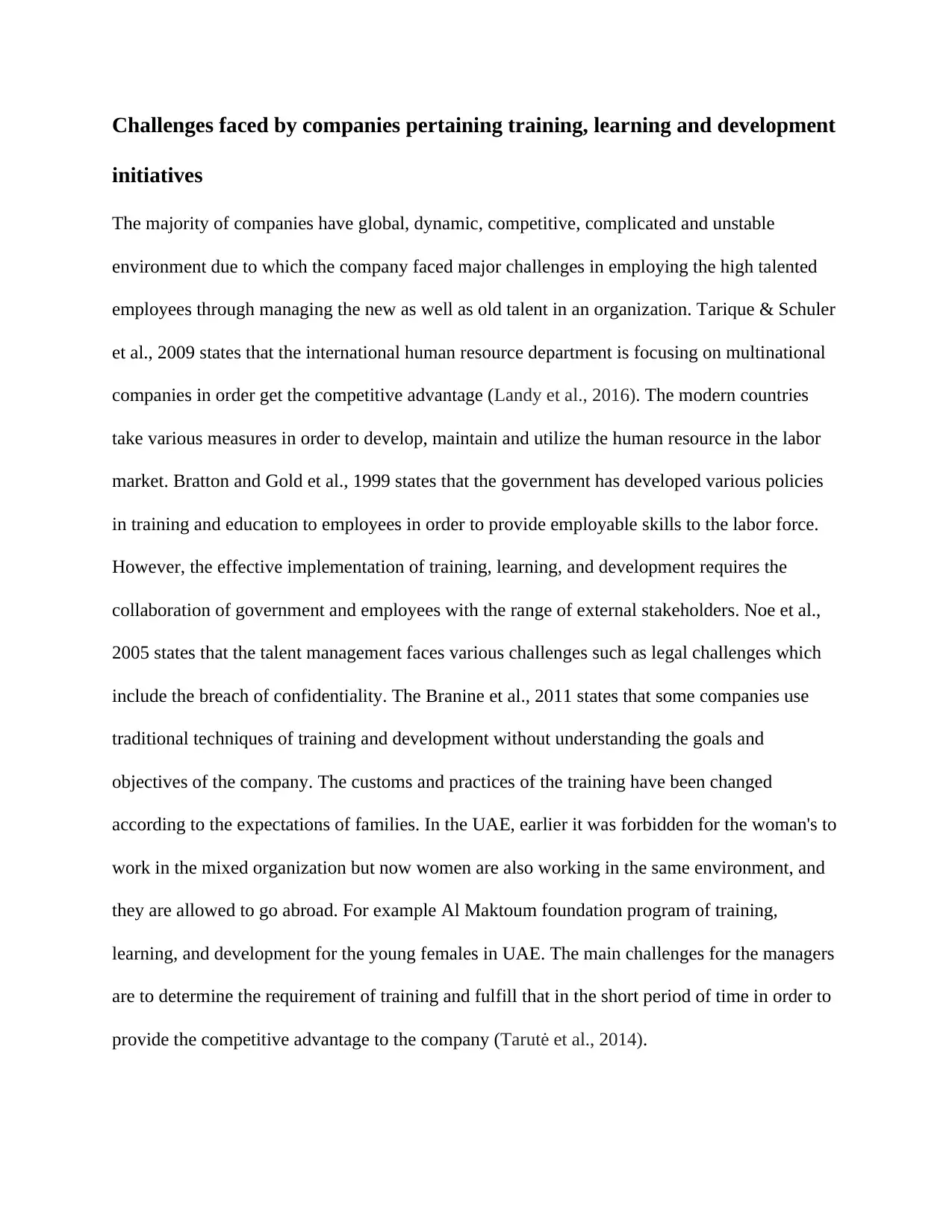
Challenges faced by companies pertaining training, learning and development
initiatives
The majority of companies have global, dynamic, competitive, complicated and unstable
environment due to which the company faced major challenges in employing the high talented
employees through managing the new as well as old talent in an organization. Tarique & Schuler
et al., 2009 states that the international human resource department is focusing on multinational
companies in order get the competitive advantage (Landy et al., 2016). The modern countries
take various measures in order to develop, maintain and utilize the human resource in the labor
market. Bratton and Gold et al., 1999 states that the government has developed various policies
in training and education to employees in order to provide employable skills to the labor force.
However, the effective implementation of training, learning, and development requires the
collaboration of government and employees with the range of external stakeholders. Noe et al.,
2005 states that the talent management faces various challenges such as legal challenges which
include the breach of confidentiality. The Branine et al., 2011 states that some companies use
traditional techniques of training and development without understanding the goals and
objectives of the company. The customs and practices of the training have been changed
according to the expectations of families. In the UAE, earlier it was forbidden for the woman's to
work in the mixed organization but now women are also working in the same environment, and
they are allowed to go abroad. For example Al Maktoum foundation program of training,
learning, and development for the young females in UAE. The main challenges for the managers
are to determine the requirement of training and fulfill that in the short period of time in order to
provide the competitive advantage to the company (Tarutė et al., 2014).
initiatives
The majority of companies have global, dynamic, competitive, complicated and unstable
environment due to which the company faced major challenges in employing the high talented
employees through managing the new as well as old talent in an organization. Tarique & Schuler
et al., 2009 states that the international human resource department is focusing on multinational
companies in order get the competitive advantage (Landy et al., 2016). The modern countries
take various measures in order to develop, maintain and utilize the human resource in the labor
market. Bratton and Gold et al., 1999 states that the government has developed various policies
in training and education to employees in order to provide employable skills to the labor force.
However, the effective implementation of training, learning, and development requires the
collaboration of government and employees with the range of external stakeholders. Noe et al.,
2005 states that the talent management faces various challenges such as legal challenges which
include the breach of confidentiality. The Branine et al., 2011 states that some companies use
traditional techniques of training and development without understanding the goals and
objectives of the company. The customs and practices of the training have been changed
according to the expectations of families. In the UAE, earlier it was forbidden for the woman's to
work in the mixed organization but now women are also working in the same environment, and
they are allowed to go abroad. For example Al Maktoum foundation program of training,
learning, and development for the young females in UAE. The main challenges for the managers
are to determine the requirement of training and fulfill that in the short period of time in order to
provide the competitive advantage to the company (Tarutė et al., 2014).
Paraphrase This Document
Need a fresh take? Get an instant paraphrase of this document with our AI Paraphraser
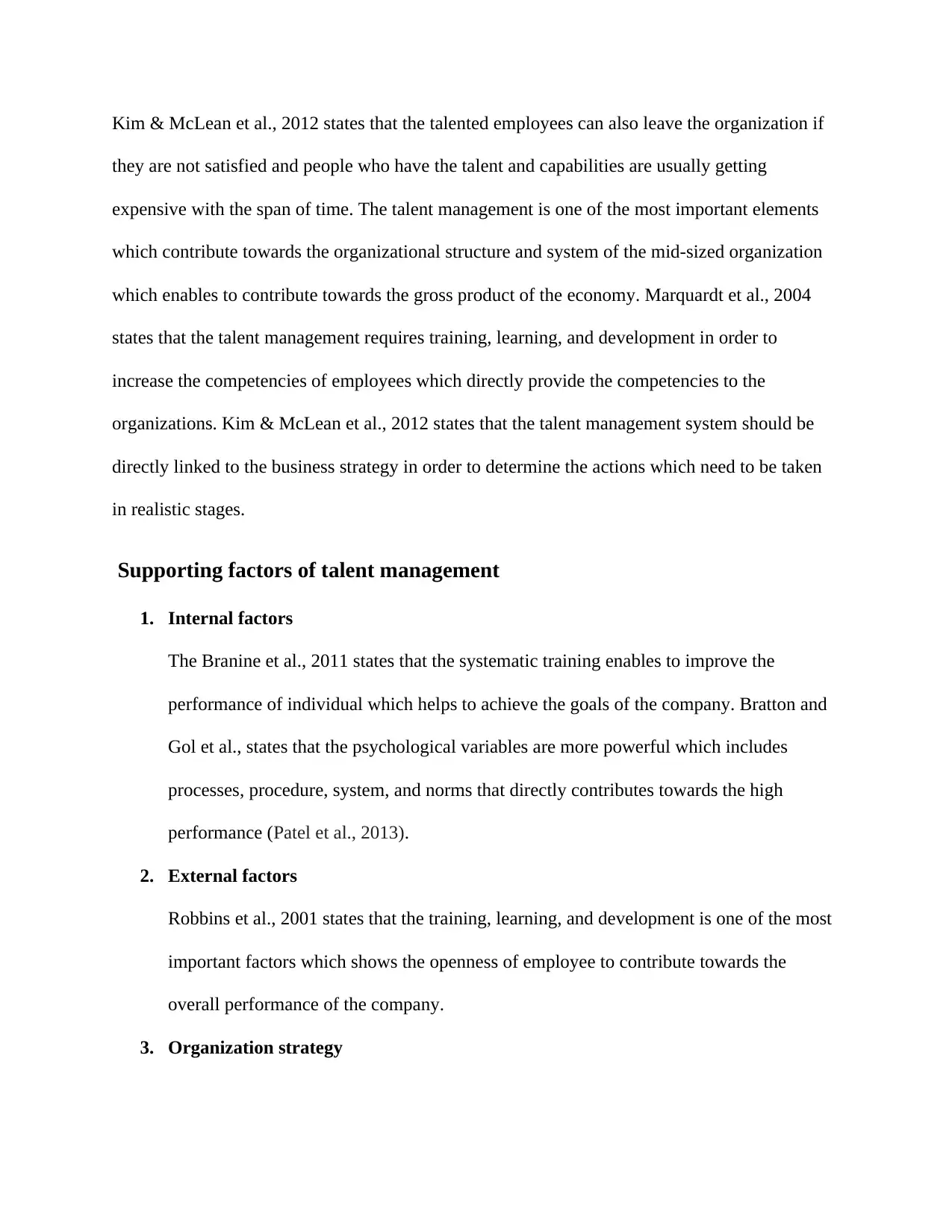
Kim & McLean et al., 2012 states that the talented employees can also leave the organization if
they are not satisfied and people who have the talent and capabilities are usually getting
expensive with the span of time. The talent management is one of the most important elements
which contribute towards the organizational structure and system of the mid-sized organization
which enables to contribute towards the gross product of the economy. Marquardt et al., 2004
states that the talent management requires training, learning, and development in order to
increase the competencies of employees which directly provide the competencies to the
organizations. Kim & McLean et al., 2012 states that the talent management system should be
directly linked to the business strategy in order to determine the actions which need to be taken
in realistic stages.
Supporting factors of talent management
1. Internal factors
The Branine et al., 2011 states that the systematic training enables to improve the
performance of individual which helps to achieve the goals of the company. Bratton and
Gol et al., states that the psychological variables are more powerful which includes
processes, procedure, system, and norms that directly contributes towards the high
performance (Patel et al., 2013).
2. External factors
Robbins et al., 2001 states that the training, learning, and development is one of the most
important factors which shows the openness of employee to contribute towards the
overall performance of the company.
3. Organization strategy
they are not satisfied and people who have the talent and capabilities are usually getting
expensive with the span of time. The talent management is one of the most important elements
which contribute towards the organizational structure and system of the mid-sized organization
which enables to contribute towards the gross product of the economy. Marquardt et al., 2004
states that the talent management requires training, learning, and development in order to
increase the competencies of employees which directly provide the competencies to the
organizations. Kim & McLean et al., 2012 states that the talent management system should be
directly linked to the business strategy in order to determine the actions which need to be taken
in realistic stages.
Supporting factors of talent management
1. Internal factors
The Branine et al., 2011 states that the systematic training enables to improve the
performance of individual which helps to achieve the goals of the company. Bratton and
Gol et al., states that the psychological variables are more powerful which includes
processes, procedure, system, and norms that directly contributes towards the high
performance (Patel et al., 2013).
2. External factors
Robbins et al., 2001 states that the training, learning, and development is one of the most
important factors which shows the openness of employee to contribute towards the
overall performance of the company.
3. Organization strategy
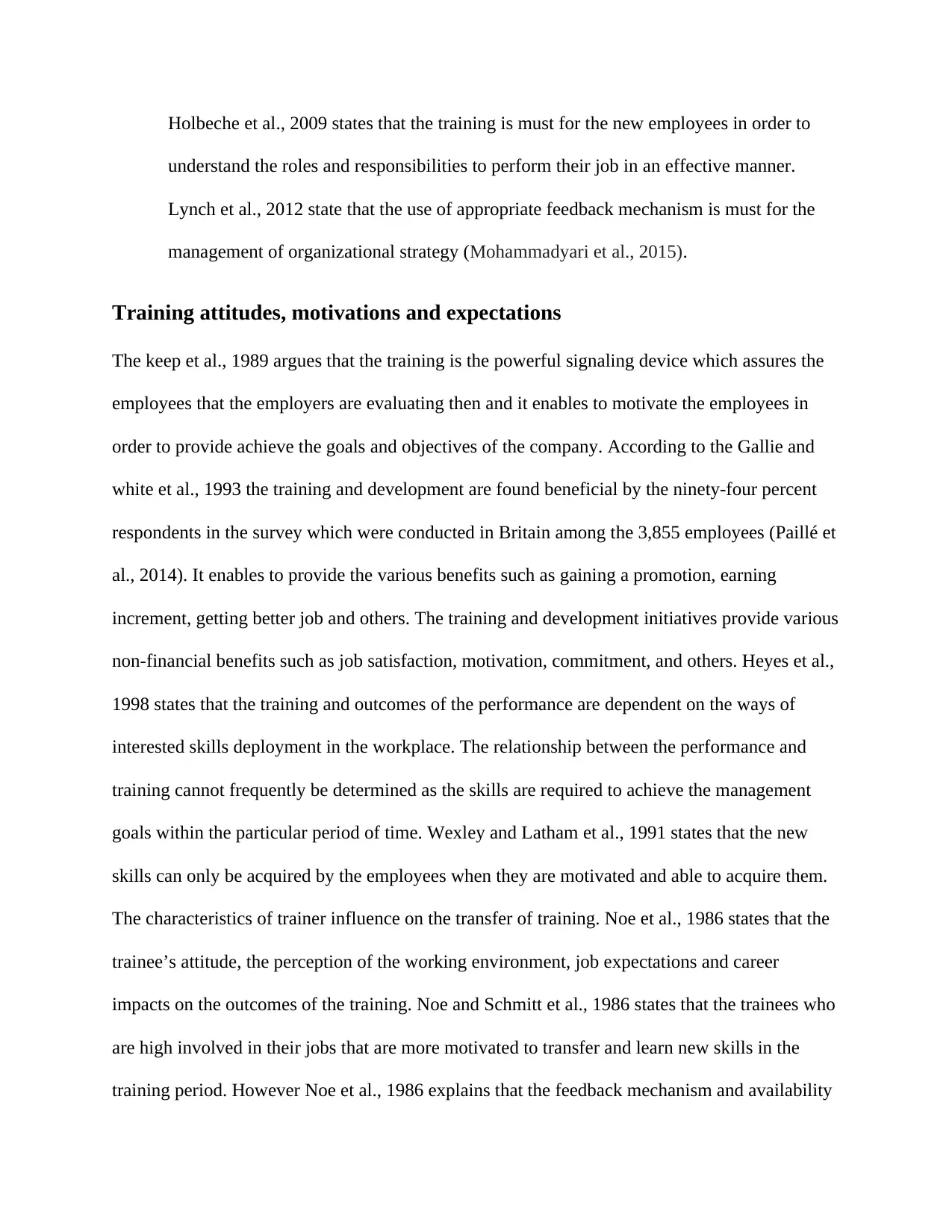
Holbeche et al., 2009 states that the training is must for the new employees in order to
understand the roles and responsibilities to perform their job in an effective manner.
Lynch et al., 2012 state that the use of appropriate feedback mechanism is must for the
management of organizational strategy (Mohammadyari et al., 2015).
Training attitudes, motivations and expectations
The keep et al., 1989 argues that the training is the powerful signaling device which assures the
employees that the employers are evaluating then and it enables to motivate the employees in
order to provide achieve the goals and objectives of the company. According to the Gallie and
white et al., 1993 the training and development are found beneficial by the ninety-four percent
respondents in the survey which were conducted in Britain among the 3,855 employees (Paillé et
al., 2014). It enables to provide the various benefits such as gaining a promotion, earning
increment, getting better job and others. The training and development initiatives provide various
non-financial benefits such as job satisfaction, motivation, commitment, and others. Heyes et al.,
1998 states that the training and outcomes of the performance are dependent on the ways of
interested skills deployment in the workplace. The relationship between the performance and
training cannot frequently be determined as the skills are required to achieve the management
goals within the particular period of time. Wexley and Latham et al., 1991 states that the new
skills can only be acquired by the employees when they are motivated and able to acquire them.
The characteristics of trainer influence on the transfer of training. Noe et al., 1986 states that the
trainee’s attitude, the perception of the working environment, job expectations and career
impacts on the outcomes of the training. Noe and Schmitt et al., 1986 states that the trainees who
are high involved in their jobs that are more motivated to transfer and learn new skills in the
training period. However Noe et al., 1986 explains that the feedback mechanism and availability
understand the roles and responsibilities to perform their job in an effective manner.
Lynch et al., 2012 state that the use of appropriate feedback mechanism is must for the
management of organizational strategy (Mohammadyari et al., 2015).
Training attitudes, motivations and expectations
The keep et al., 1989 argues that the training is the powerful signaling device which assures the
employees that the employers are evaluating then and it enables to motivate the employees in
order to provide achieve the goals and objectives of the company. According to the Gallie and
white et al., 1993 the training and development are found beneficial by the ninety-four percent
respondents in the survey which were conducted in Britain among the 3,855 employees (Paillé et
al., 2014). It enables to provide the various benefits such as gaining a promotion, earning
increment, getting better job and others. The training and development initiatives provide various
non-financial benefits such as job satisfaction, motivation, commitment, and others. Heyes et al.,
1998 states that the training and outcomes of the performance are dependent on the ways of
interested skills deployment in the workplace. The relationship between the performance and
training cannot frequently be determined as the skills are required to achieve the management
goals within the particular period of time. Wexley and Latham et al., 1991 states that the new
skills can only be acquired by the employees when they are motivated and able to acquire them.
The characteristics of trainer influence on the transfer of training. Noe et al., 1986 states that the
trainee’s attitude, the perception of the working environment, job expectations and career
impacts on the outcomes of the training. Noe and Schmitt et al., 1986 states that the trainees who
are high involved in their jobs that are more motivated to transfer and learn new skills in the
training period. However Noe et al., 1986 explains that the feedback mechanism and availability
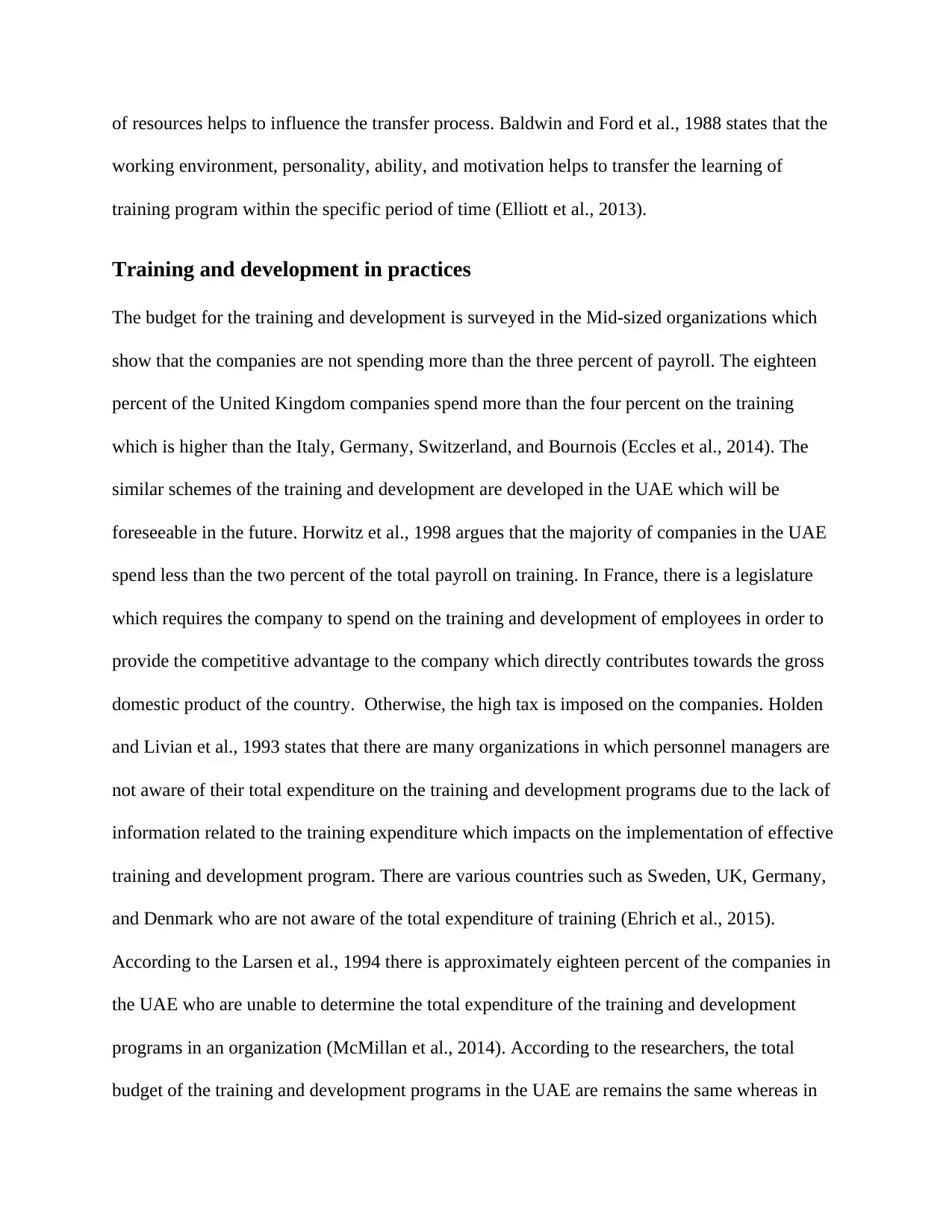
of resources helps to influence the transfer process. Baldwin and Ford et al., 1988 states that the
working environment, personality, ability, and motivation helps to transfer the learning of
training program within the specific period of time (Elliott et al., 2013).
Training and development in practices
The budget for the training and development is surveyed in the Mid-sized organizations which
show that the companies are not spending more than the three percent of payroll. The eighteen
percent of the United Kingdom companies spend more than the four percent on the training
which is higher than the Italy, Germany, Switzerland, and Bournois (Eccles et al., 2014). The
similar schemes of the training and development are developed in the UAE which will be
foreseeable in the future. Horwitz et al., 1998 argues that the majority of companies in the UAE
spend less than the two percent of the total payroll on training. In France, there is a legislature
which requires the company to spend on the training and development of employees in order to
provide the competitive advantage to the company which directly contributes towards the gross
domestic product of the country. Otherwise, the high tax is imposed on the companies. Holden
and Livian et al., 1993 states that there are many organizations in which personnel managers are
not aware of their total expenditure on the training and development programs due to the lack of
information related to the training expenditure which impacts on the implementation of effective
training and development program. There are various countries such as Sweden, UK, Germany,
and Denmark who are not aware of the total expenditure of training (Ehrich et al., 2015).
According to the Larsen et al., 1994 there is approximately eighteen percent of the companies in
the UAE who are unable to determine the total expenditure of the training and development
programs in an organization (McMillan et al., 2014). According to the researchers, the total
budget of the training and development programs in the UAE are remains the same whereas in
working environment, personality, ability, and motivation helps to transfer the learning of
training program within the specific period of time (Elliott et al., 2013).
Training and development in practices
The budget for the training and development is surveyed in the Mid-sized organizations which
show that the companies are not spending more than the three percent of payroll. The eighteen
percent of the United Kingdom companies spend more than the four percent on the training
which is higher than the Italy, Germany, Switzerland, and Bournois (Eccles et al., 2014). The
similar schemes of the training and development are developed in the UAE which will be
foreseeable in the future. Horwitz et al., 1998 argues that the majority of companies in the UAE
spend less than the two percent of the total payroll on training. In France, there is a legislature
which requires the company to spend on the training and development of employees in order to
provide the competitive advantage to the company which directly contributes towards the gross
domestic product of the country. Otherwise, the high tax is imposed on the companies. Holden
and Livian et al., 1993 states that there are many organizations in which personnel managers are
not aware of their total expenditure on the training and development programs due to the lack of
information related to the training expenditure which impacts on the implementation of effective
training and development program. There are various countries such as Sweden, UK, Germany,
and Denmark who are not aware of the total expenditure of training (Ehrich et al., 2015).
According to the Larsen et al., 1994 there is approximately eighteen percent of the companies in
the UAE who are unable to determine the total expenditure of the training and development
programs in an organization (McMillan et al., 2014). According to the researchers, the total
budget of the training and development programs in the UAE are remains the same whereas in
Secure Best Marks with AI Grader
Need help grading? Try our AI Grader for instant feedback on your assignments.
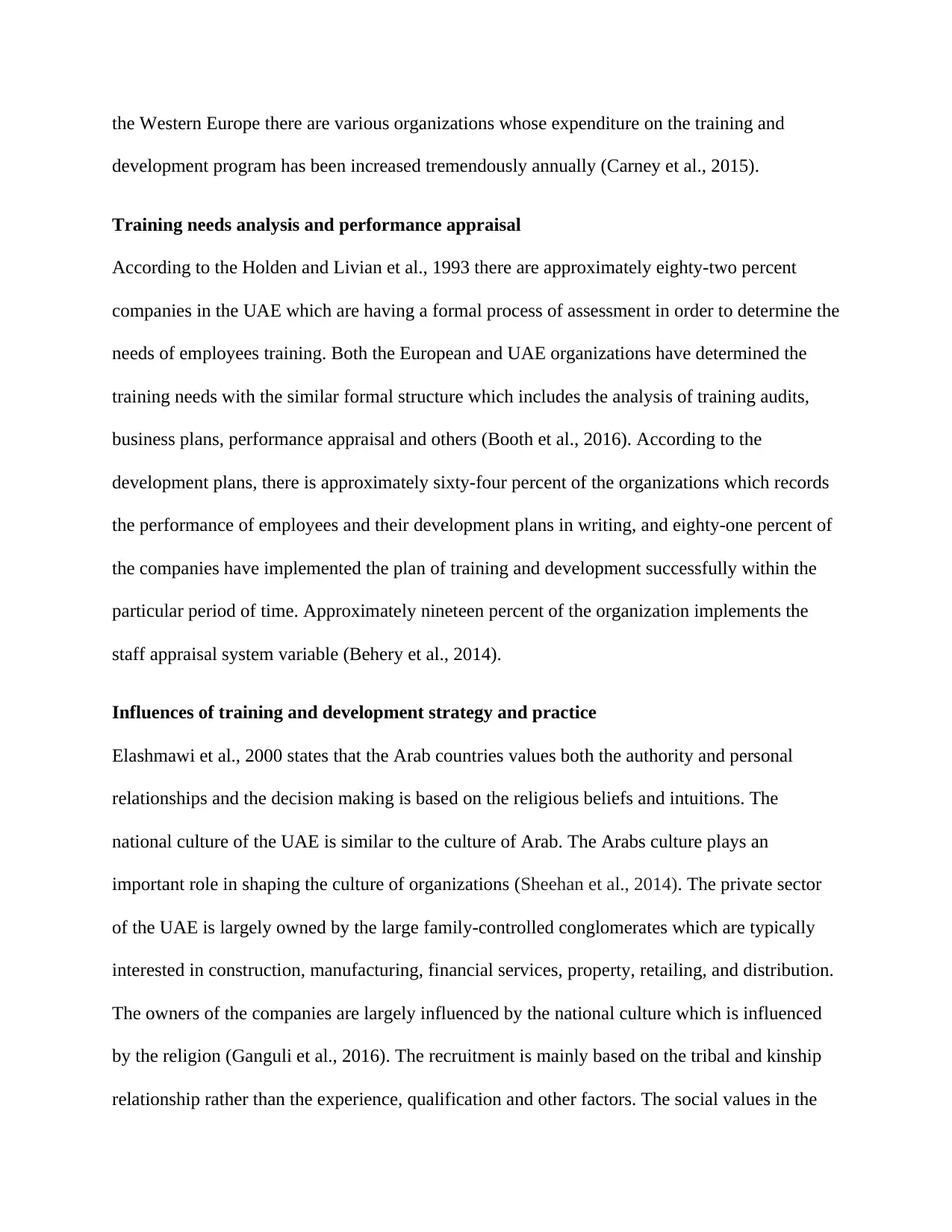
the Western Europe there are various organizations whose expenditure on the training and
development program has been increased tremendously annually (Carney et al., 2015).
Training needs analysis and performance appraisal
According to the Holden and Livian et al., 1993 there are approximately eighty-two percent
companies in the UAE which are having a formal process of assessment in order to determine the
needs of employees training. Both the European and UAE organizations have determined the
training needs with the similar formal structure which includes the analysis of training audits,
business plans, performance appraisal and others (Booth et al., 2016). According to the
development plans, there is approximately sixty-four percent of the organizations which records
the performance of employees and their development plans in writing, and eighty-one percent of
the companies have implemented the plan of training and development successfully within the
particular period of time. Approximately nineteen percent of the organization implements the
staff appraisal system variable (Behery et al., 2014).
Influences of training and development strategy and practice
Elashmawi et al., 2000 states that the Arab countries values both the authority and personal
relationships and the decision making is based on the religious beliefs and intuitions. The
national culture of the UAE is similar to the culture of Arab. The Arabs culture plays an
important role in shaping the culture of organizations (Sheehan et al., 2014). The private sector
of the UAE is largely owned by the large family-controlled conglomerates which are typically
interested in construction, manufacturing, financial services, property, retailing, and distribution.
The owners of the companies are largely influenced by the national culture which is influenced
by the religion (Ganguli et al., 2016). The recruitment is mainly based on the tribal and kinship
relationship rather than the experience, qualification and other factors. The social values in the
development program has been increased tremendously annually (Carney et al., 2015).
Training needs analysis and performance appraisal
According to the Holden and Livian et al., 1993 there are approximately eighty-two percent
companies in the UAE which are having a formal process of assessment in order to determine the
needs of employees training. Both the European and UAE organizations have determined the
training needs with the similar formal structure which includes the analysis of training audits,
business plans, performance appraisal and others (Booth et al., 2016). According to the
development plans, there is approximately sixty-four percent of the organizations which records
the performance of employees and their development plans in writing, and eighty-one percent of
the companies have implemented the plan of training and development successfully within the
particular period of time. Approximately nineteen percent of the organization implements the
staff appraisal system variable (Behery et al., 2014).
Influences of training and development strategy and practice
Elashmawi et al., 2000 states that the Arab countries values both the authority and personal
relationships and the decision making is based on the religious beliefs and intuitions. The
national culture of the UAE is similar to the culture of Arab. The Arabs culture plays an
important role in shaping the culture of organizations (Sheehan et al., 2014). The private sector
of the UAE is largely owned by the large family-controlled conglomerates which are typically
interested in construction, manufacturing, financial services, property, retailing, and distribution.
The owners of the companies are largely influenced by the national culture which is influenced
by the religion (Ganguli et al., 2016). The recruitment is mainly based on the tribal and kinship
relationship rather than the experience, qualification and other factors. The social values in the
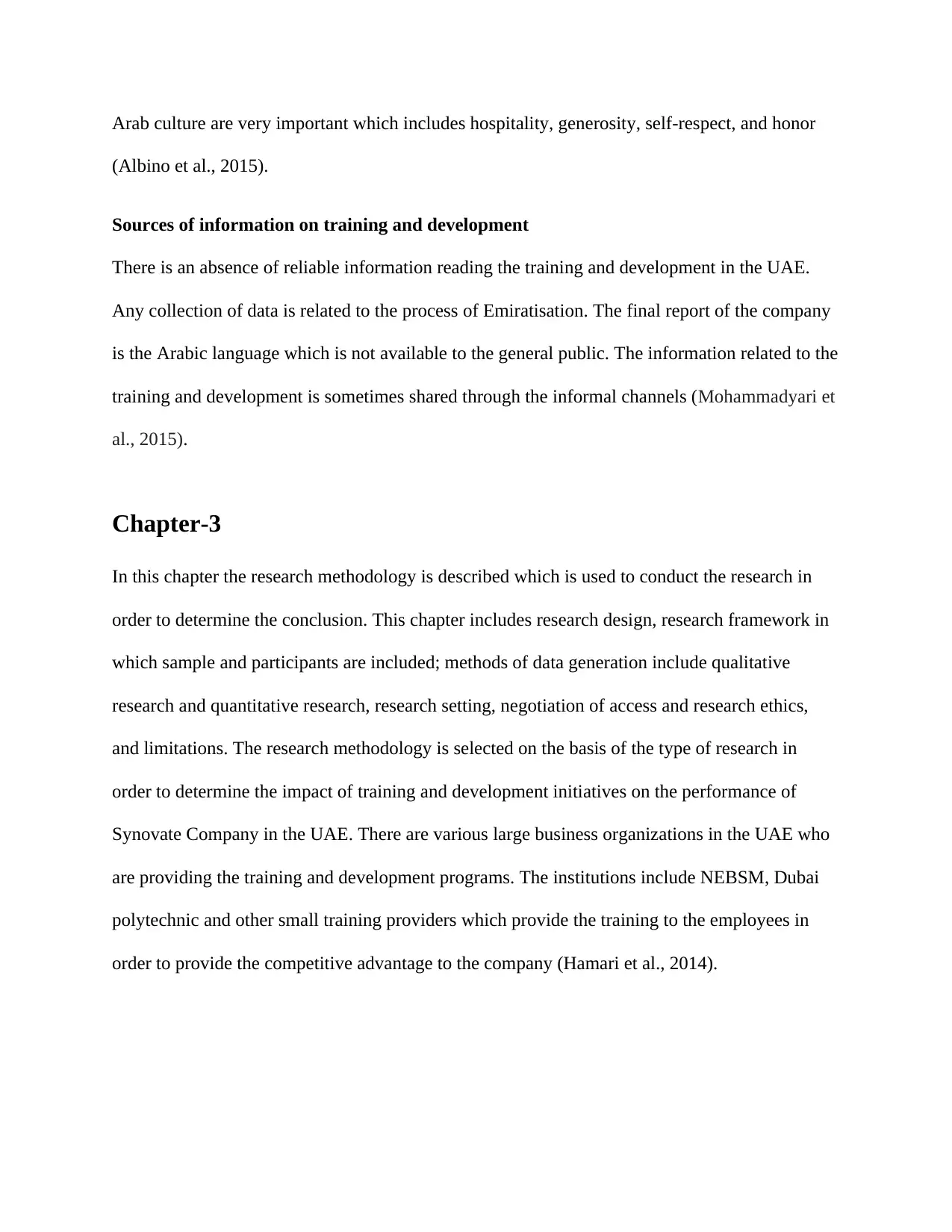
Arab culture are very important which includes hospitality, generosity, self-respect, and honor
(Albino et al., 2015).
Sources of information on training and development
There is an absence of reliable information reading the training and development in the UAE.
Any collection of data is related to the process of Emiratisation. The final report of the company
is the Arabic language which is not available to the general public. The information related to the
training and development is sometimes shared through the informal channels (Mohammadyari et
al., 2015).
Chapter-3
In this chapter the research methodology is described which is used to conduct the research in
order to determine the conclusion. This chapter includes research design, research framework in
which sample and participants are included; methods of data generation include qualitative
research and quantitative research, research setting, negotiation of access and research ethics,
and limitations. The research methodology is selected on the basis of the type of research in
order to determine the impact of training and development initiatives on the performance of
Synovate Company in the UAE. There are various large business organizations in the UAE who
are providing the training and development programs. The institutions include NEBSM, Dubai
polytechnic and other small training providers which provide the training to the employees in
order to provide the competitive advantage to the company (Hamari et al., 2014).
(Albino et al., 2015).
Sources of information on training and development
There is an absence of reliable information reading the training and development in the UAE.
Any collection of data is related to the process of Emiratisation. The final report of the company
is the Arabic language which is not available to the general public. The information related to the
training and development is sometimes shared through the informal channels (Mohammadyari et
al., 2015).
Chapter-3
In this chapter the research methodology is described which is used to conduct the research in
order to determine the conclusion. This chapter includes research design, research framework in
which sample and participants are included; methods of data generation include qualitative
research and quantitative research, research setting, negotiation of access and research ethics,
and limitations. The research methodology is selected on the basis of the type of research in
order to determine the impact of training and development initiatives on the performance of
Synovate Company in the UAE. There are various large business organizations in the UAE who
are providing the training and development programs. The institutions include NEBSM, Dubai
polytechnic and other small training providers which provide the training to the employees in
order to provide the competitive advantage to the company (Hamari et al., 2014).

Research methodology
It is mandatory to carry out the research in order to determine the answers to the research
questions and accomplish the research objectives. The research methodology includes research
design, sampling, and data collection methods, negotiation of access and research ethics, and
research setting.
Research design
The research design in this report is of explanatory nature which is mainly focused on
determining the impact of learning and development initiatives in the mid-sized organizations on
the overall performance of the companies in UAE. The research is carrying out through survey
and in-depth interview of the management of the company in order to determine its impact on the
overall performance of the company. It is mainly important as the research questions are mainly
dependent on the research objective. The mixed research design method is used to conduct the
research. The descriptive method is selected as there are the different attitude of respondents, so
it covers the response of all the respondents.
According to the Bryman and Bell et al., 2007 the mixed research design is the combination of
quantitative and qualitative methods of data collection. The mixed research method helps to
provide more credibility and confidence in order to judge the information which is collected
through various sources of information, and it enables to develop the interrelations among the
findings. The mixed research method helps to analyze the information and answer the research
questions.
The qualitative data is collected from the interviews which are conducted with the management
of the company, and quantitative data is collected through using a questionnaire to the employees
It is mandatory to carry out the research in order to determine the answers to the research
questions and accomplish the research objectives. The research methodology includes research
design, sampling, and data collection methods, negotiation of access and research ethics, and
research setting.
Research design
The research design in this report is of explanatory nature which is mainly focused on
determining the impact of learning and development initiatives in the mid-sized organizations on
the overall performance of the companies in UAE. The research is carrying out through survey
and in-depth interview of the management of the company in order to determine its impact on the
overall performance of the company. It is mainly important as the research questions are mainly
dependent on the research objective. The mixed research design method is used to conduct the
research. The descriptive method is selected as there are the different attitude of respondents, so
it covers the response of all the respondents.
According to the Bryman and Bell et al., 2007 the mixed research design is the combination of
quantitative and qualitative methods of data collection. The mixed research method helps to
provide more credibility and confidence in order to judge the information which is collected
through various sources of information, and it enables to develop the interrelations among the
findings. The mixed research method helps to analyze the information and answer the research
questions.
The qualitative data is collected from the interviews which are conducted with the management
of the company, and quantitative data is collected through using a questionnaire to the employees
Paraphrase This Document
Need a fresh take? Get an instant paraphrase of this document with our AI Paraphraser
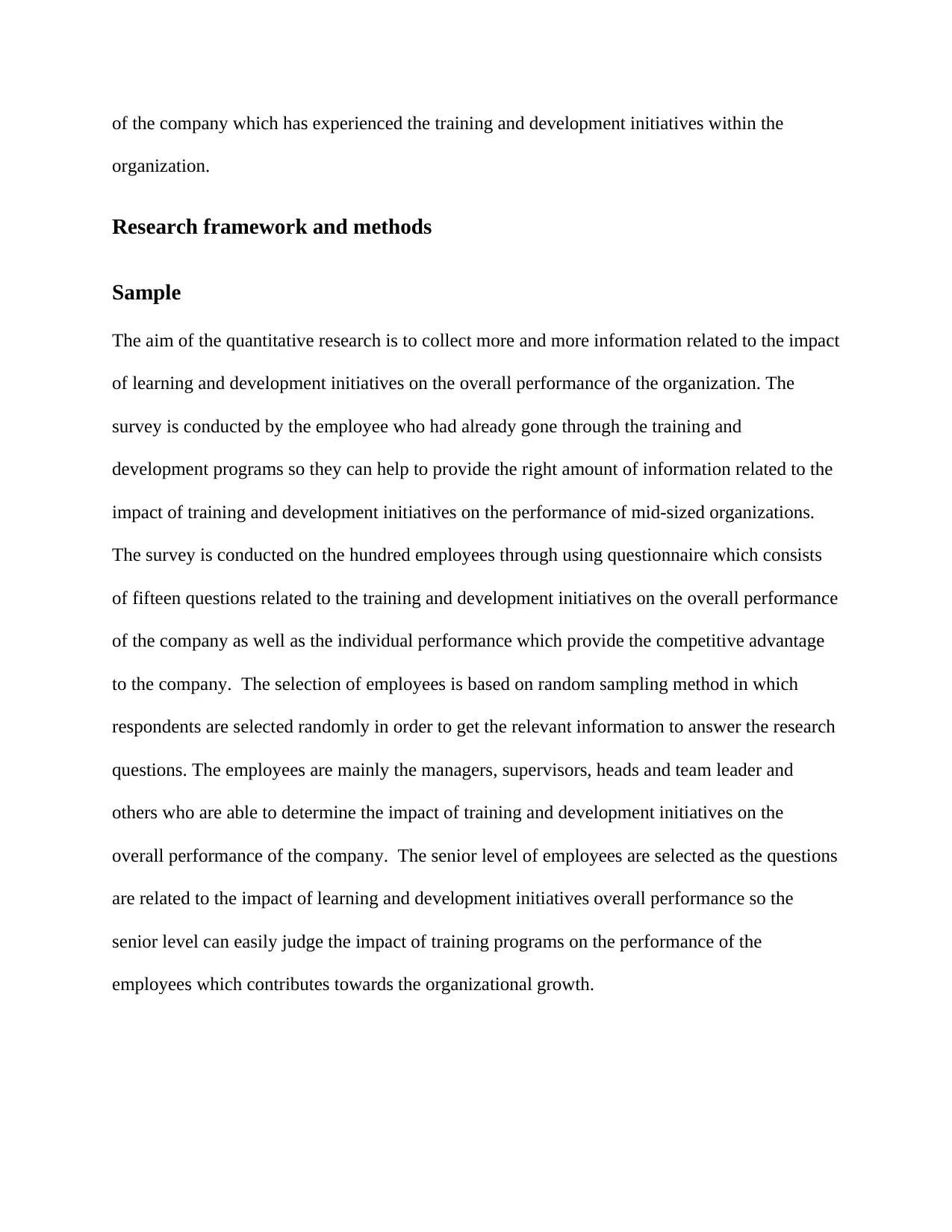
of the company which has experienced the training and development initiatives within the
organization.
Research framework and methods
Sample
The aim of the quantitative research is to collect more and more information related to the impact
of learning and development initiatives on the overall performance of the organization. The
survey is conducted by the employee who had already gone through the training and
development programs so they can help to provide the right amount of information related to the
impact of training and development initiatives on the performance of mid-sized organizations.
The survey is conducted on the hundred employees through using questionnaire which consists
of fifteen questions related to the training and development initiatives on the overall performance
of the company as well as the individual performance which provide the competitive advantage
to the company. The selection of employees is based on random sampling method in which
respondents are selected randomly in order to get the relevant information to answer the research
questions. The employees are mainly the managers, supervisors, heads and team leader and
others who are able to determine the impact of training and development initiatives on the
overall performance of the company. The senior level of employees are selected as the questions
are related to the impact of learning and development initiatives overall performance so the
senior level can easily judge the impact of training programs on the performance of the
employees which contributes towards the organizational growth.
organization.
Research framework and methods
Sample
The aim of the quantitative research is to collect more and more information related to the impact
of learning and development initiatives on the overall performance of the organization. The
survey is conducted by the employee who had already gone through the training and
development programs so they can help to provide the right amount of information related to the
impact of training and development initiatives on the performance of mid-sized organizations.
The survey is conducted on the hundred employees through using questionnaire which consists
of fifteen questions related to the training and development initiatives on the overall performance
of the company as well as the individual performance which provide the competitive advantage
to the company. The selection of employees is based on random sampling method in which
respondents are selected randomly in order to get the relevant information to answer the research
questions. The employees are mainly the managers, supervisors, heads and team leader and
others who are able to determine the impact of training and development initiatives on the
overall performance of the company. The senior level of employees are selected as the questions
are related to the impact of learning and development initiatives overall performance so the
senior level can easily judge the impact of training programs on the performance of the
employees which contributes towards the organizational growth.
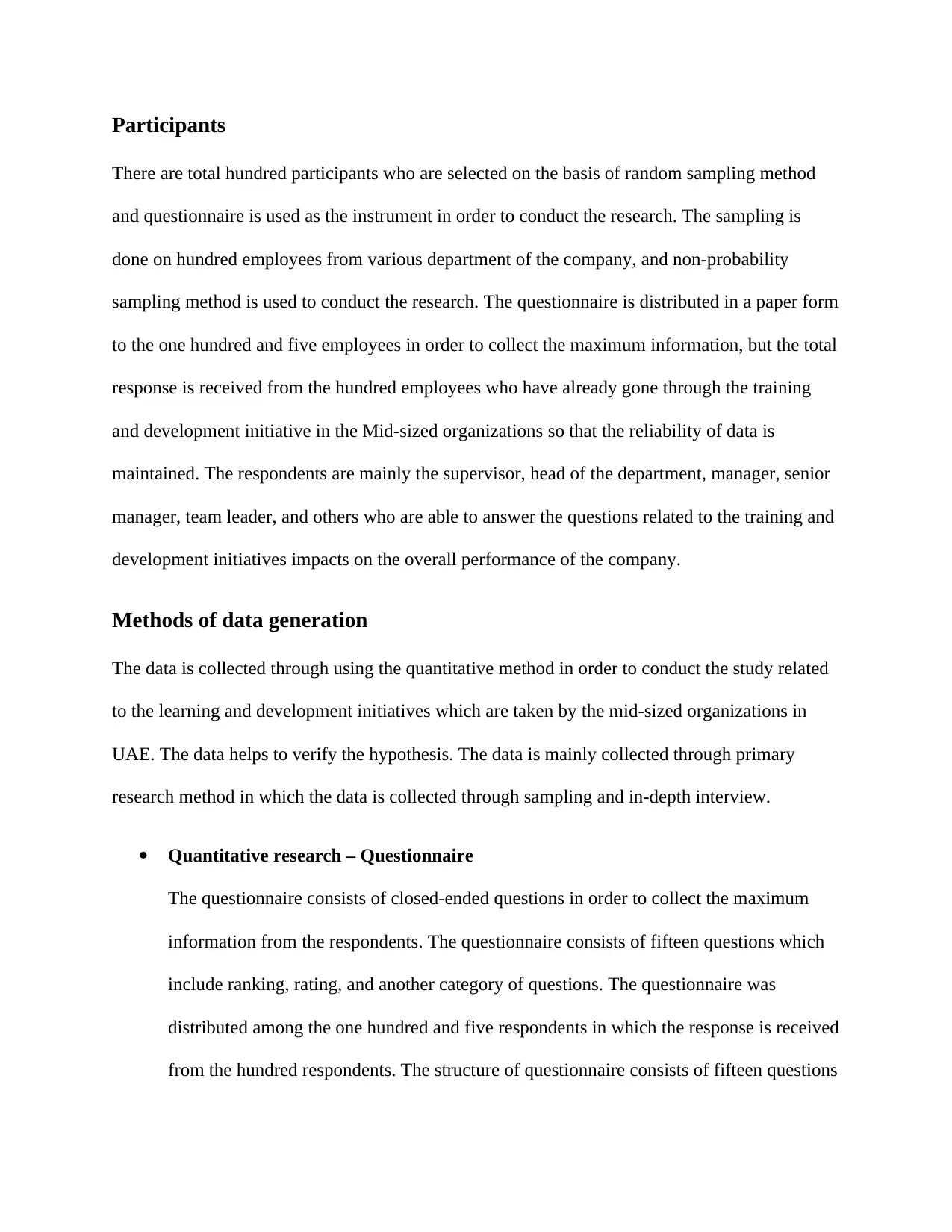
Participants
There are total hundred participants who are selected on the basis of random sampling method
and questionnaire is used as the instrument in order to conduct the research. The sampling is
done on hundred employees from various department of the company, and non-probability
sampling method is used to conduct the research. The questionnaire is distributed in a paper form
to the one hundred and five employees in order to collect the maximum information, but the total
response is received from the hundred employees who have already gone through the training
and development initiative in the Mid-sized organizations so that the reliability of data is
maintained. The respondents are mainly the supervisor, head of the department, manager, senior
manager, team leader, and others who are able to answer the questions related to the training and
development initiatives impacts on the overall performance of the company.
Methods of data generation
The data is collected through using the quantitative method in order to conduct the study related
to the learning and development initiatives which are taken by the mid-sized organizations in
UAE. The data helps to verify the hypothesis. The data is mainly collected through primary
research method in which the data is collected through sampling and in-depth interview.
Quantitative research – Questionnaire
The questionnaire consists of closed-ended questions in order to collect the maximum
information from the respondents. The questionnaire consists of fifteen questions which
include ranking, rating, and another category of questions. The questionnaire was
distributed among the one hundred and five respondents in which the response is received
from the hundred respondents. The structure of questionnaire consists of fifteen questions
There are total hundred participants who are selected on the basis of random sampling method
and questionnaire is used as the instrument in order to conduct the research. The sampling is
done on hundred employees from various department of the company, and non-probability
sampling method is used to conduct the research. The questionnaire is distributed in a paper form
to the one hundred and five employees in order to collect the maximum information, but the total
response is received from the hundred employees who have already gone through the training
and development initiative in the Mid-sized organizations so that the reliability of data is
maintained. The respondents are mainly the supervisor, head of the department, manager, senior
manager, team leader, and others who are able to answer the questions related to the training and
development initiatives impacts on the overall performance of the company.
Methods of data generation
The data is collected through using the quantitative method in order to conduct the study related
to the learning and development initiatives which are taken by the mid-sized organizations in
UAE. The data helps to verify the hypothesis. The data is mainly collected through primary
research method in which the data is collected through sampling and in-depth interview.
Quantitative research – Questionnaire
The questionnaire consists of closed-ended questions in order to collect the maximum
information from the respondents. The questionnaire consists of fifteen questions which
include ranking, rating, and another category of questions. The questionnaire was
distributed among the one hundred and five respondents in which the response is received
from the hundred respondents. The structure of questionnaire consists of fifteen questions

related to the learning and development initiatives which help to determine the impact of
initiatives on the overall performance of the company. The research is conducted on the
respondents who have already gone through the training and development initiative in
order to maintain the reliability of data. The questionnaire is distributed among the
employees through taking the permission and disclose about the research in order to
maintain the transparency in conducting the research. The expected response of the
survey is high as it is profitable for the employer as well as for the employees. The
questionnaire is the research tool which helps to provide the information through
providing the answers to the questions. The questionnaire helps to conduct the primary
research in order to answers of the research questions. The questionnaire was developed
on the nominal scale in order to collect the first-hand information from the respondents
which help to maintain the accuracy of data in conducting the research study. The Likert
scale is used to conduct the research study which helps to analyze the data in a most
efficient and effective manner. The questionnaire includes two sections in which the
section includes personal information such as designation, contact number, and name
whereas the second section consists of fifteen questions which are related to the training
and development initiatives by the Synovate Company and its impact on the overall
performance of the company. The questionnaire is prepared by considering the research
questions and research outcome in order to conduct the successful research within the
particular period of time.
Qualitative research- Semi-structured interviews
initiatives on the overall performance of the company. The research is conducted on the
respondents who have already gone through the training and development initiative in
order to maintain the reliability of data. The questionnaire is distributed among the
employees through taking the permission and disclose about the research in order to
maintain the transparency in conducting the research. The expected response of the
survey is high as it is profitable for the employer as well as for the employees. The
questionnaire is the research tool which helps to provide the information through
providing the answers to the questions. The questionnaire helps to conduct the primary
research in order to answers of the research questions. The questionnaire was developed
on the nominal scale in order to collect the first-hand information from the respondents
which help to maintain the accuracy of data in conducting the research study. The Likert
scale is used to conduct the research study which helps to analyze the data in a most
efficient and effective manner. The questionnaire includes two sections in which the
section includes personal information such as designation, contact number, and name
whereas the second section consists of fifteen questions which are related to the training
and development initiatives by the Synovate Company and its impact on the overall
performance of the company. The questionnaire is prepared by considering the research
questions and research outcome in order to conduct the successful research within the
particular period of time.
Qualitative research- Semi-structured interviews
Secure Best Marks with AI Grader
Need help grading? Try our AI Grader for instant feedback on your assignments.
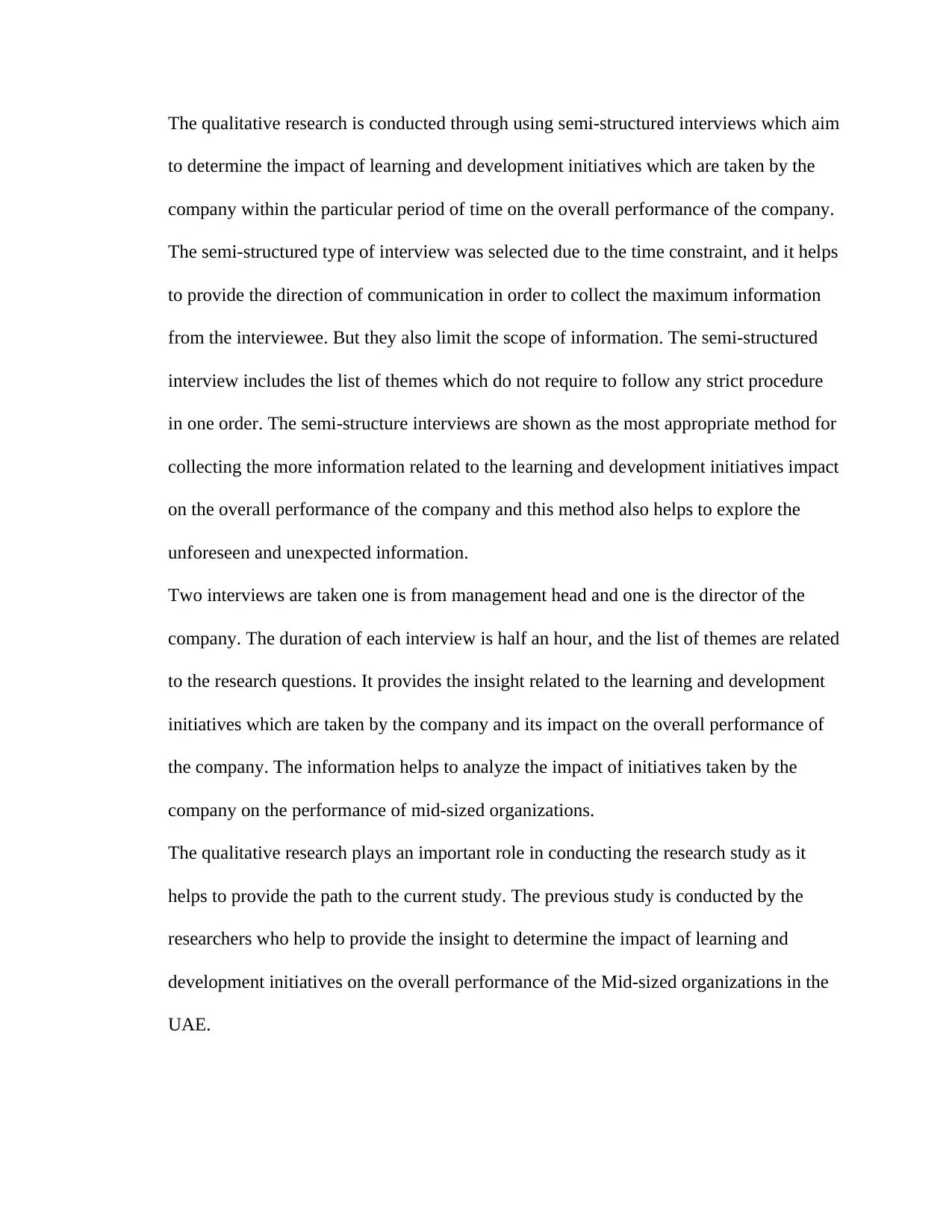
The qualitative research is conducted through using semi-structured interviews which aim
to determine the impact of learning and development initiatives which are taken by the
company within the particular period of time on the overall performance of the company.
The semi-structured type of interview was selected due to the time constraint, and it helps
to provide the direction of communication in order to collect the maximum information
from the interviewee. But they also limit the scope of information. The semi-structured
interview includes the list of themes which do not require to follow any strict procedure
in one order. The semi-structure interviews are shown as the most appropriate method for
collecting the more information related to the learning and development initiatives impact
on the overall performance of the company and this method also helps to explore the
unforeseen and unexpected information.
Two interviews are taken one is from management head and one is the director of the
company. The duration of each interview is half an hour, and the list of themes are related
to the research questions. It provides the insight related to the learning and development
initiatives which are taken by the company and its impact on the overall performance of
the company. The information helps to analyze the impact of initiatives taken by the
company on the performance of mid-sized organizations.
The qualitative research plays an important role in conducting the research study as it
helps to provide the path to the current study. The previous study is conducted by the
researchers who help to provide the insight to determine the impact of learning and
development initiatives on the overall performance of the Mid-sized organizations in the
UAE.
to determine the impact of learning and development initiatives which are taken by the
company within the particular period of time on the overall performance of the company.
The semi-structured type of interview was selected due to the time constraint, and it helps
to provide the direction of communication in order to collect the maximum information
from the interviewee. But they also limit the scope of information. The semi-structured
interview includes the list of themes which do not require to follow any strict procedure
in one order. The semi-structure interviews are shown as the most appropriate method for
collecting the more information related to the learning and development initiatives impact
on the overall performance of the company and this method also helps to explore the
unforeseen and unexpected information.
Two interviews are taken one is from management head and one is the director of the
company. The duration of each interview is half an hour, and the list of themes are related
to the research questions. It provides the insight related to the learning and development
initiatives which are taken by the company and its impact on the overall performance of
the company. The information helps to analyze the impact of initiatives taken by the
company on the performance of mid-sized organizations.
The qualitative research plays an important role in conducting the research study as it
helps to provide the path to the current study. The previous study is conducted by the
researchers who help to provide the insight to determine the impact of learning and
development initiatives on the overall performance of the Mid-sized organizations in the
UAE.

Both the qualitative and quantitative methods are used to conduct the research in order to
collect the maximum information from the respondents which enable to provide the
accuracy of results findings.
Research setting
The Synovate Research Company is a market research analysis company which provides the
decision support services such as business information, technology, business assessment report,
field assessment report, call verification report and others. It helps to provide the competitive
advantage to the companies through provide insight of business information. The aim of the
research is to gain the understanding of learning and development initiatives on the overall
performance of the mid-sized organizations so that the awareness among the mid-sized
organizations in UAE can be developed which improves the overall performance of the company
that directly contribute towards the overall performance of the company. The primary research is
conducted through questionnaire and semi-structured interview in order to collect the first-hand
information. The secondary data is collected from the annual reports, interim reports and other
reports of the company. The aim of the research is to determine the impact of learning and
development initiatives on the overall performance of the mid-sized organization in the UAE.
The primary research is oriented towards the employee’s performance. The training and
development initiatives by the organization help to improve the efficiency and skills of
employees which directly contributes towards the organizational performance within the specific
period of time.
collect the maximum information from the respondents which enable to provide the
accuracy of results findings.
Research setting
The Synovate Research Company is a market research analysis company which provides the
decision support services such as business information, technology, business assessment report,
field assessment report, call verification report and others. It helps to provide the competitive
advantage to the companies through provide insight of business information. The aim of the
research is to gain the understanding of learning and development initiatives on the overall
performance of the mid-sized organizations so that the awareness among the mid-sized
organizations in UAE can be developed which improves the overall performance of the company
that directly contribute towards the overall performance of the company. The primary research is
conducted through questionnaire and semi-structured interview in order to collect the first-hand
information. The secondary data is collected from the annual reports, interim reports and other
reports of the company. The aim of the research is to determine the impact of learning and
development initiatives on the overall performance of the mid-sized organization in the UAE.
The primary research is oriented towards the employee’s performance. The training and
development initiatives by the organization help to improve the efficiency and skills of
employees which directly contributes towards the organizational performance within the specific
period of time.
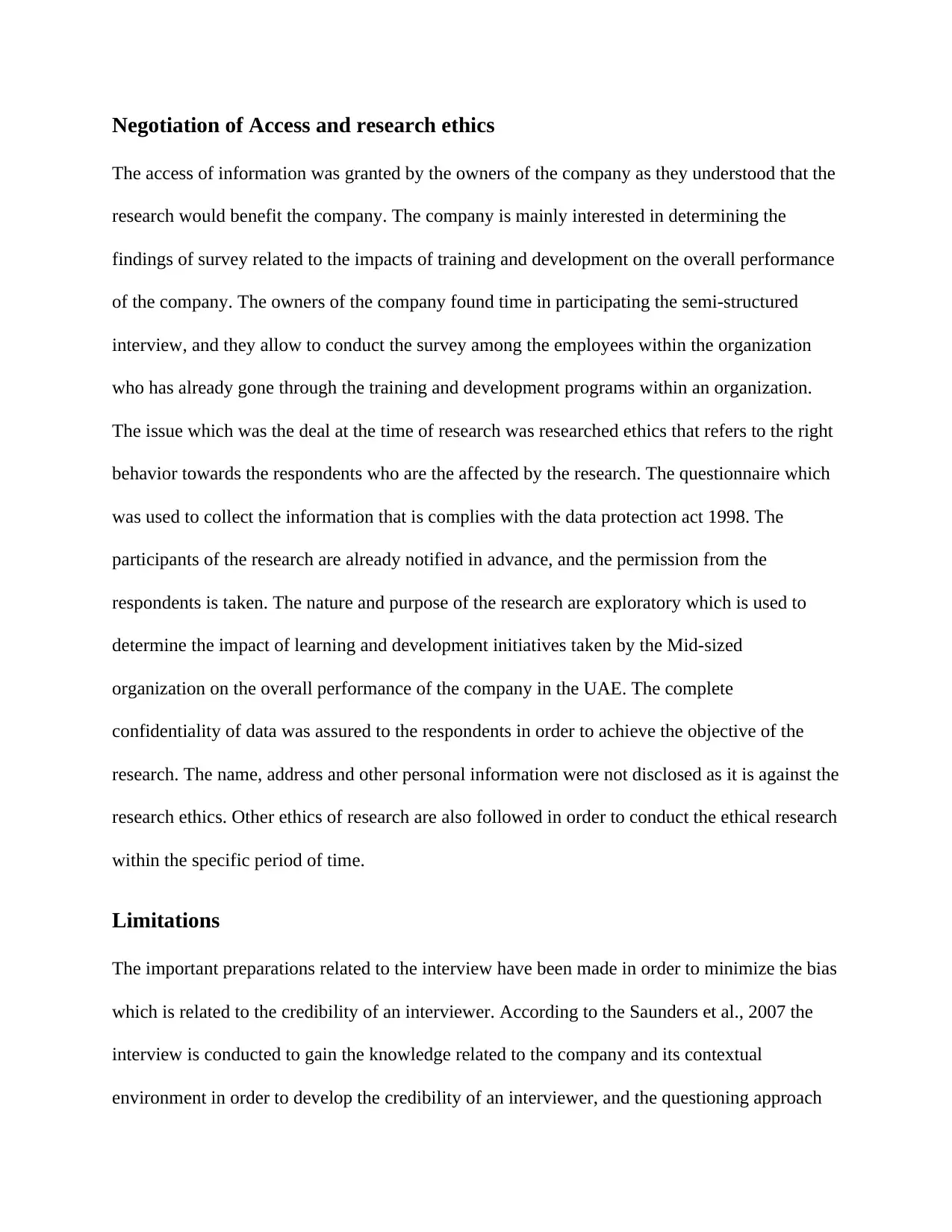
Negotiation of Access and research ethics
The access of information was granted by the owners of the company as they understood that the
research would benefit the company. The company is mainly interested in determining the
findings of survey related to the impacts of training and development on the overall performance
of the company. The owners of the company found time in participating the semi-structured
interview, and they allow to conduct the survey among the employees within the organization
who has already gone through the training and development programs within an organization.
The issue which was the deal at the time of research was researched ethics that refers to the right
behavior towards the respondents who are the affected by the research. The questionnaire which
was used to collect the information that is complies with the data protection act 1998. The
participants of the research are already notified in advance, and the permission from the
respondents is taken. The nature and purpose of the research are exploratory which is used to
determine the impact of learning and development initiatives taken by the Mid-sized
organization on the overall performance of the company in the UAE. The complete
confidentiality of data was assured to the respondents in order to achieve the objective of the
research. The name, address and other personal information were not disclosed as it is against the
research ethics. Other ethics of research are also followed in order to conduct the ethical research
within the specific period of time.
Limitations
The important preparations related to the interview have been made in order to minimize the bias
which is related to the credibility of an interviewer. According to the Saunders et al., 2007 the
interview is conducted to gain the knowledge related to the company and its contextual
environment in order to develop the credibility of an interviewer, and the questioning approach
The access of information was granted by the owners of the company as they understood that the
research would benefit the company. The company is mainly interested in determining the
findings of survey related to the impacts of training and development on the overall performance
of the company. The owners of the company found time in participating the semi-structured
interview, and they allow to conduct the survey among the employees within the organization
who has already gone through the training and development programs within an organization.
The issue which was the deal at the time of research was researched ethics that refers to the right
behavior towards the respondents who are the affected by the research. The questionnaire which
was used to collect the information that is complies with the data protection act 1998. The
participants of the research are already notified in advance, and the permission from the
respondents is taken. The nature and purpose of the research are exploratory which is used to
determine the impact of learning and development initiatives taken by the Mid-sized
organization on the overall performance of the company in the UAE. The complete
confidentiality of data was assured to the respondents in order to achieve the objective of the
research. The name, address and other personal information were not disclosed as it is against the
research ethics. Other ethics of research are also followed in order to conduct the ethical research
within the specific period of time.
Limitations
The important preparations related to the interview have been made in order to minimize the bias
which is related to the credibility of an interviewer. According to the Saunders et al., 2007 the
interview is conducted to gain the knowledge related to the company and its contextual
environment in order to develop the credibility of an interviewer, and the questioning approach
Paraphrase This Document
Need a fresh take? Get an instant paraphrase of this document with our AI Paraphraser

was also ensured. Although the research was conducted through ensuring highest possible
accuracy, but there are several limitations which restrict the scope of the study. The primary
research is conducted by one company which represents the impact of learning and development
initiatives on the overall performance of mid-sized organizations in the UAE which shows the
access to a large number of companies and relatively low survey response rate. The owners of
the company are also reluctant to provide the financial data details which limit the scope of the
study. The financial performance of the company is accessed through using the available
information about the trading accounts which restricts the assessment of resource and capabilities
of the company. The scope of the secondary information is limited to the financial information
and time in order to gain the particular information. The restricted access to the direct
competitor's data and major industry players implied the limitations on gathering the in-depth
information regarding the market share and overall performance of the company. The scope of
the research is wide as it is applicable on the entire UAE but the breath of the research study is
comparatively small as the number of participants is only hundred. Due to the time constraint,
the opinion of limited respondents has been taken which limits the scope of the study. The
literature review suggested that the interview with the interview the owners of the mid-sized
organization help to contribute towards the in-depth analysis related to the impact of training and
development initiatives on the organizational performance within the particular period of time.
Analysis of data
The data analysis is conducted through using the MS excel as the data analysis tool in which
tables and charts are used to represent the information which is collected through primary
research on the hundred employees within the organization which helps to determine the impact
of learning and development initiatives on the overall performance of the company. The data is
accuracy, but there are several limitations which restrict the scope of the study. The primary
research is conducted by one company which represents the impact of learning and development
initiatives on the overall performance of mid-sized organizations in the UAE which shows the
access to a large number of companies and relatively low survey response rate. The owners of
the company are also reluctant to provide the financial data details which limit the scope of the
study. The financial performance of the company is accessed through using the available
information about the trading accounts which restricts the assessment of resource and capabilities
of the company. The scope of the secondary information is limited to the financial information
and time in order to gain the particular information. The restricted access to the direct
competitor's data and major industry players implied the limitations on gathering the in-depth
information regarding the market share and overall performance of the company. The scope of
the research is wide as it is applicable on the entire UAE but the breath of the research study is
comparatively small as the number of participants is only hundred. Due to the time constraint,
the opinion of limited respondents has been taken which limits the scope of the study. The
literature review suggested that the interview with the interview the owners of the mid-sized
organization help to contribute towards the in-depth analysis related to the impact of training and
development initiatives on the organizational performance within the particular period of time.
Analysis of data
The data analysis is conducted through using the MS excel as the data analysis tool in which
tables and charts are used to represent the information which is collected through primary
research on the hundred employees within the organization which helps to determine the impact
of learning and development initiatives on the overall performance of the company. The data is
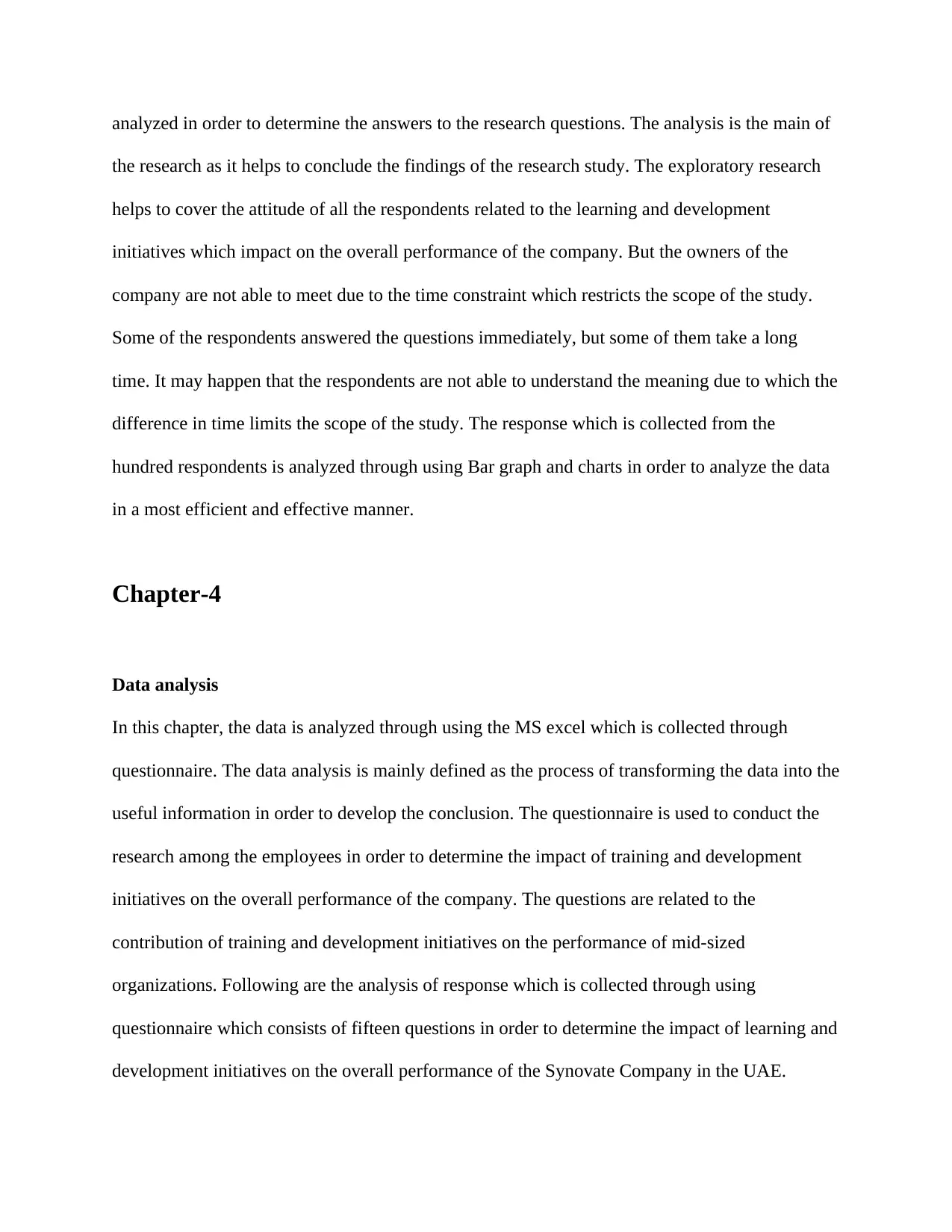
analyzed in order to determine the answers to the research questions. The analysis is the main of
the research as it helps to conclude the findings of the research study. The exploratory research
helps to cover the attitude of all the respondents related to the learning and development
initiatives which impact on the overall performance of the company. But the owners of the
company are not able to meet due to the time constraint which restricts the scope of the study.
Some of the respondents answered the questions immediately, but some of them take a long
time. It may happen that the respondents are not able to understand the meaning due to which the
difference in time limits the scope of the study. The response which is collected from the
hundred respondents is analyzed through using Bar graph and charts in order to analyze the data
in a most efficient and effective manner.
Chapter-4
Data analysis
In this chapter, the data is analyzed through using the MS excel which is collected through
questionnaire. The data analysis is mainly defined as the process of transforming the data into the
useful information in order to develop the conclusion. The questionnaire is used to conduct the
research among the employees in order to determine the impact of training and development
initiatives on the overall performance of the company. The questions are related to the
contribution of training and development initiatives on the performance of mid-sized
organizations. Following are the analysis of response which is collected through using
questionnaire which consists of fifteen questions in order to determine the impact of learning and
development initiatives on the overall performance of the Synovate Company in the UAE.
the research as it helps to conclude the findings of the research study. The exploratory research
helps to cover the attitude of all the respondents related to the learning and development
initiatives which impact on the overall performance of the company. But the owners of the
company are not able to meet due to the time constraint which restricts the scope of the study.
Some of the respondents answered the questions immediately, but some of them take a long
time. It may happen that the respondents are not able to understand the meaning due to which the
difference in time limits the scope of the study. The response which is collected from the
hundred respondents is analyzed through using Bar graph and charts in order to analyze the data
in a most efficient and effective manner.
Chapter-4
Data analysis
In this chapter, the data is analyzed through using the MS excel which is collected through
questionnaire. The data analysis is mainly defined as the process of transforming the data into the
useful information in order to develop the conclusion. The questionnaire is used to conduct the
research among the employees in order to determine the impact of training and development
initiatives on the overall performance of the company. The questions are related to the
contribution of training and development initiatives on the performance of mid-sized
organizations. Following are the analysis of response which is collected through using
questionnaire which consists of fifteen questions in order to determine the impact of learning and
development initiatives on the overall performance of the Synovate Company in the UAE.
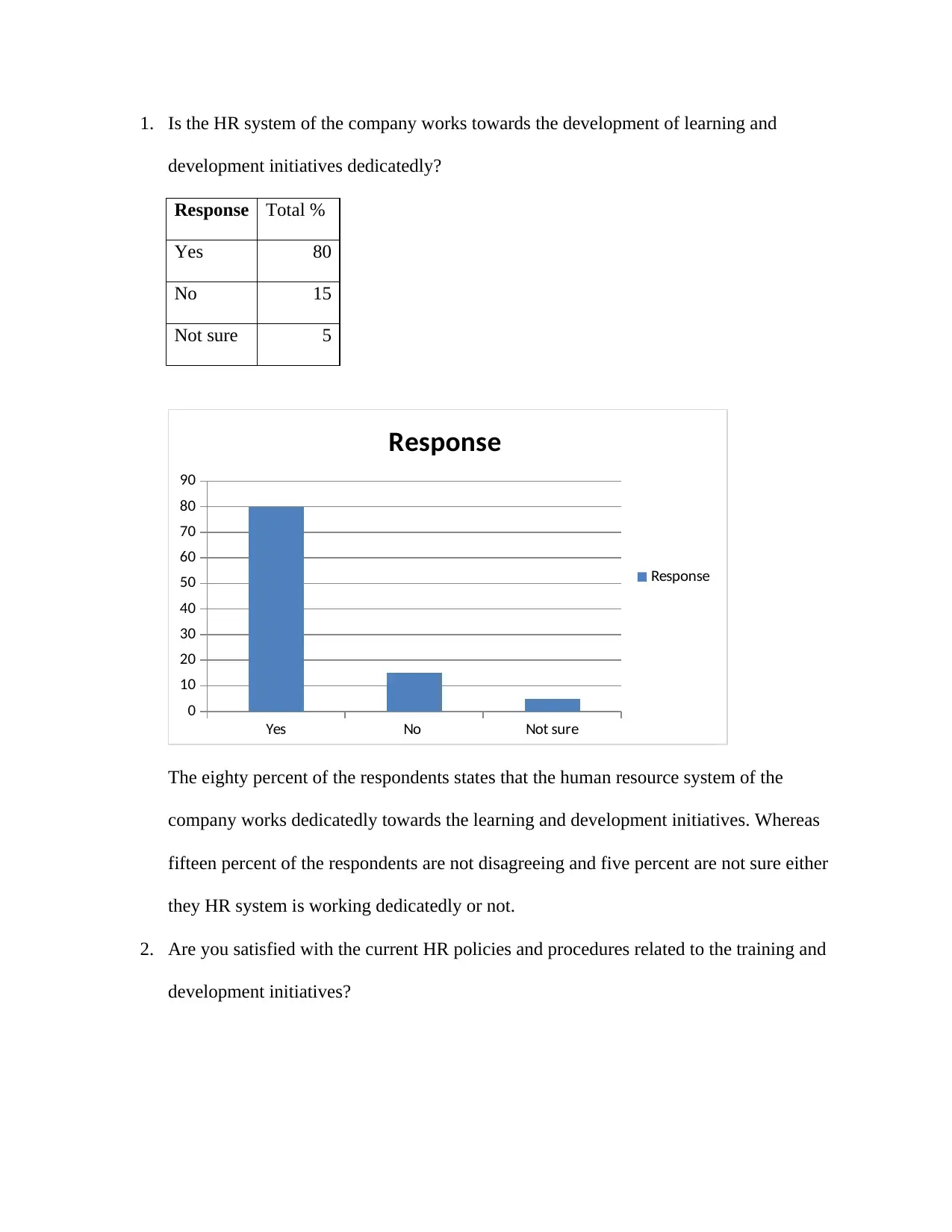
1. Is the HR system of the company works towards the development of learning and
development initiatives dedicatedly?
Response Total %
Yes 80
No 15
Not sure 5
Yes No Not sure
0
10
20
30
40
50
60
70
80
90
Response
Response
The eighty percent of the respondents states that the human resource system of the
company works dedicatedly towards the learning and development initiatives. Whereas
fifteen percent of the respondents are not disagreeing and five percent are not sure either
they HR system is working dedicatedly or not.
2. Are you satisfied with the current HR policies and procedures related to the training and
development initiatives?
development initiatives dedicatedly?
Response Total %
Yes 80
No 15
Not sure 5
Yes No Not sure
0
10
20
30
40
50
60
70
80
90
Response
Response
The eighty percent of the respondents states that the human resource system of the
company works dedicatedly towards the learning and development initiatives. Whereas
fifteen percent of the respondents are not disagreeing and five percent are not sure either
they HR system is working dedicatedly or not.
2. Are you satisfied with the current HR policies and procedures related to the training and
development initiatives?
Secure Best Marks with AI Grader
Need help grading? Try our AI Grader for instant feedback on your assignments.
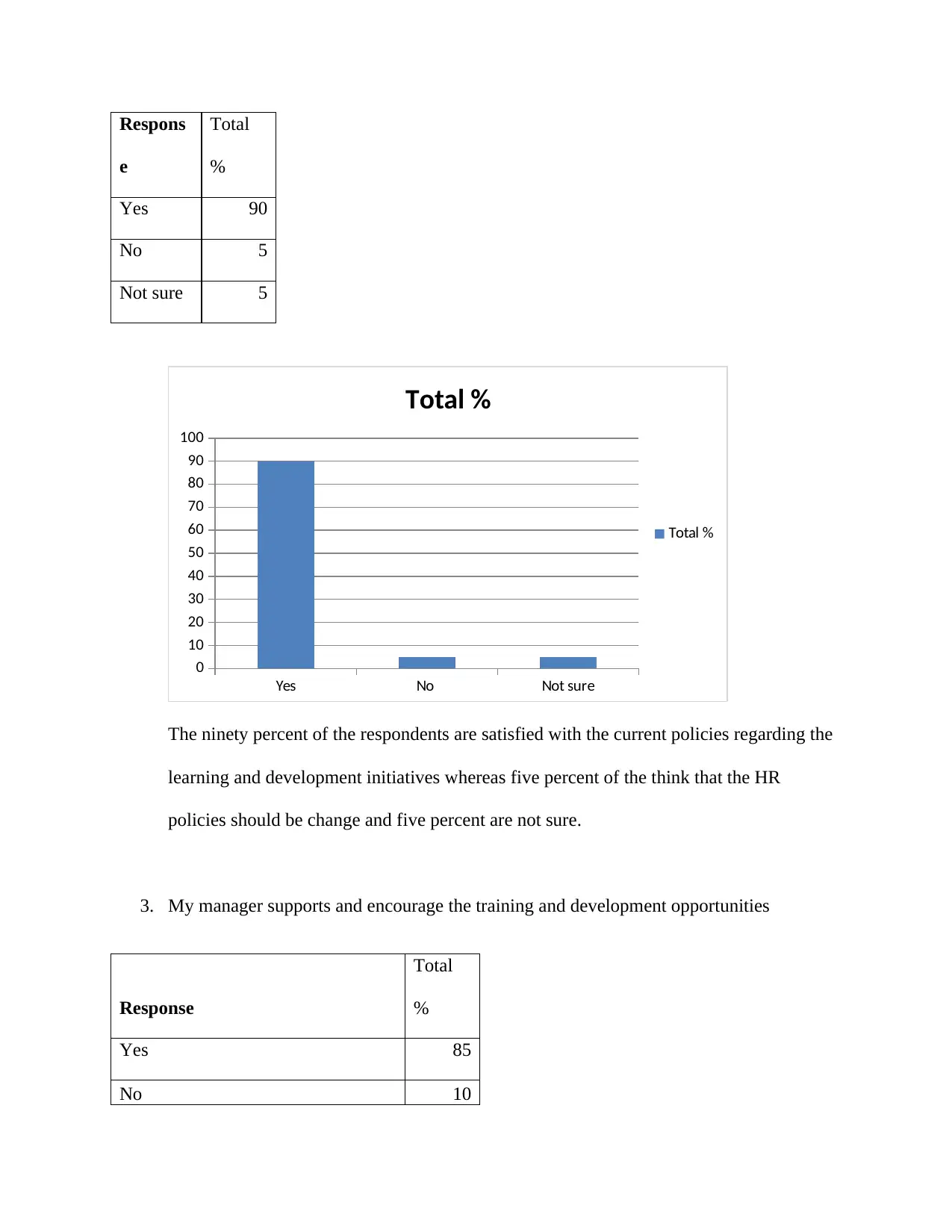
Respons
e
Total
%
Yes 90
No 5
Not sure 5
Yes No Not sure
0
10
20
30
40
50
60
70
80
90
100
Total %
Total %
The ninety percent of the respondents are satisfied with the current policies regarding the
learning and development initiatives whereas five percent of the think that the HR
policies should be change and five percent are not sure.
3. My manager supports and encourage the training and development opportunities
Response
Total
%
Yes 85
No 10
e
Total
%
Yes 90
No 5
Not sure 5
Yes No Not sure
0
10
20
30
40
50
60
70
80
90
100
Total %
Total %
The ninety percent of the respondents are satisfied with the current policies regarding the
learning and development initiatives whereas five percent of the think that the HR
policies should be change and five percent are not sure.
3. My manager supports and encourage the training and development opportunities
Response
Total
%
Yes 85
No 10
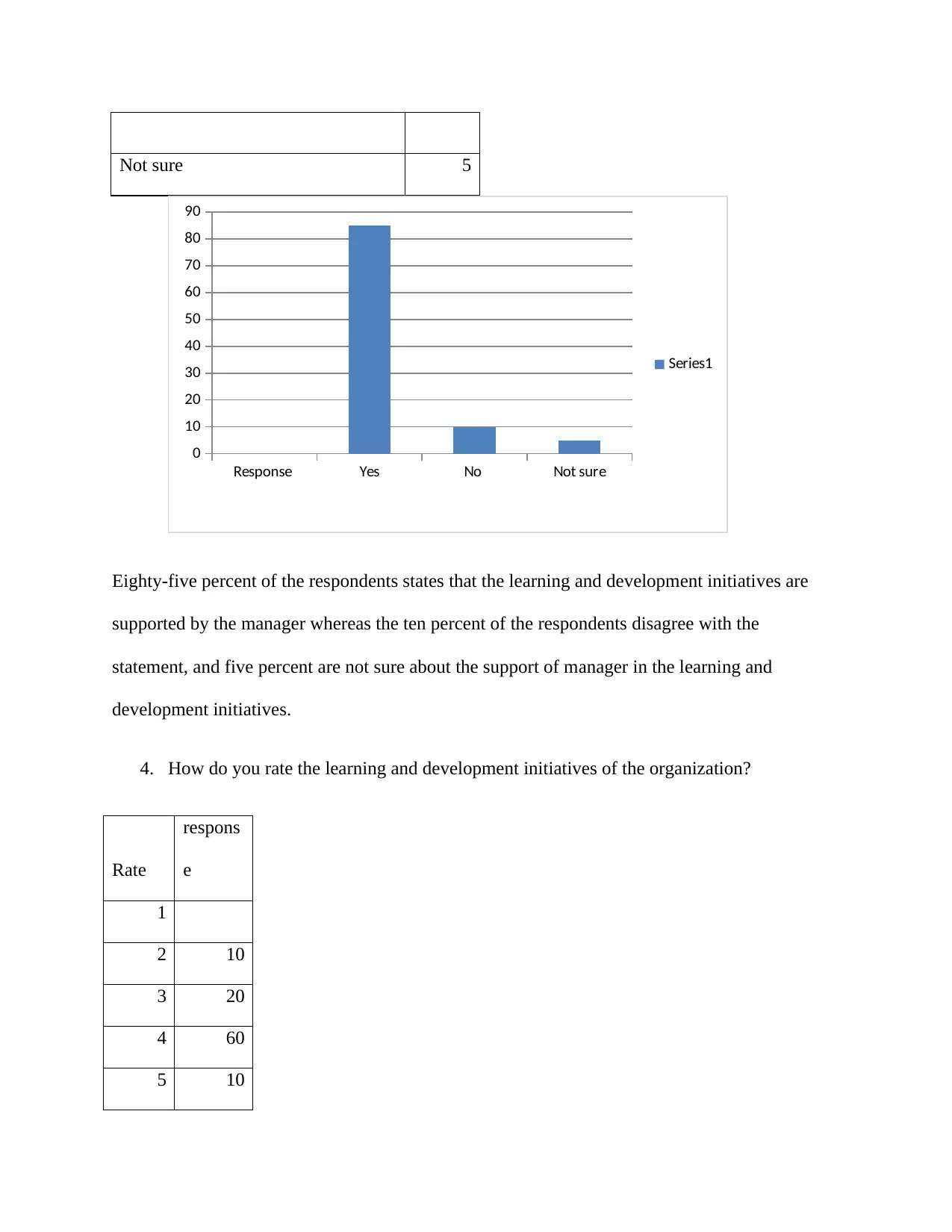
Not sure 5
Response Yes No Not sure
0
10
20
30
40
50
60
70
80
90
Series1
Eighty-five percent of the respondents states that the learning and development initiatives are
supported by the manager whereas the ten percent of the respondents disagree with the
statement, and five percent are not sure about the support of manager in the learning and
development initiatives.
4. How do you rate the learning and development initiatives of the organization?
Rate
respons
e
1
2 10
3 20
4 60
5 10
Response Yes No Not sure
0
10
20
30
40
50
60
70
80
90
Series1
Eighty-five percent of the respondents states that the learning and development initiatives are
supported by the manager whereas the ten percent of the respondents disagree with the
statement, and five percent are not sure about the support of manager in the learning and
development initiatives.
4. How do you rate the learning and development initiatives of the organization?
Rate
respons
e
1
2 10
3 20
4 60
5 10

1 2 3 4 5
0
2
4
6
8
10
12
Rate
response
The sixty percent of the respondents rate the learning and development initiatives four, twenty
percent of the respondent's rate three, ten percent of the respondent's rate two and ten percent of
the respondents rate ten percent.
5. Cognitive changes in last five years from learning and development initiatives
Cognitive changes
Respons
e
Satisfaction of employees 80
Efficiency in team meetings 75
Speed of operations 85
Improved level of business understandings 80
Team meeting efficiency 88
0
2
4
6
8
10
12
Rate
response
The sixty percent of the respondents rate the learning and development initiatives four, twenty
percent of the respondent's rate three, ten percent of the respondent's rate two and ten percent of
the respondents rate ten percent.
5. Cognitive changes in last five years from learning and development initiatives
Cognitive changes
Respons
e
Satisfaction of employees 80
Efficiency in team meetings 75
Speed of operations 85
Improved level of business understandings 80
Team meeting efficiency 88
Paraphrase This Document
Need a fresh take? Get an instant paraphrase of this document with our AI Paraphraser
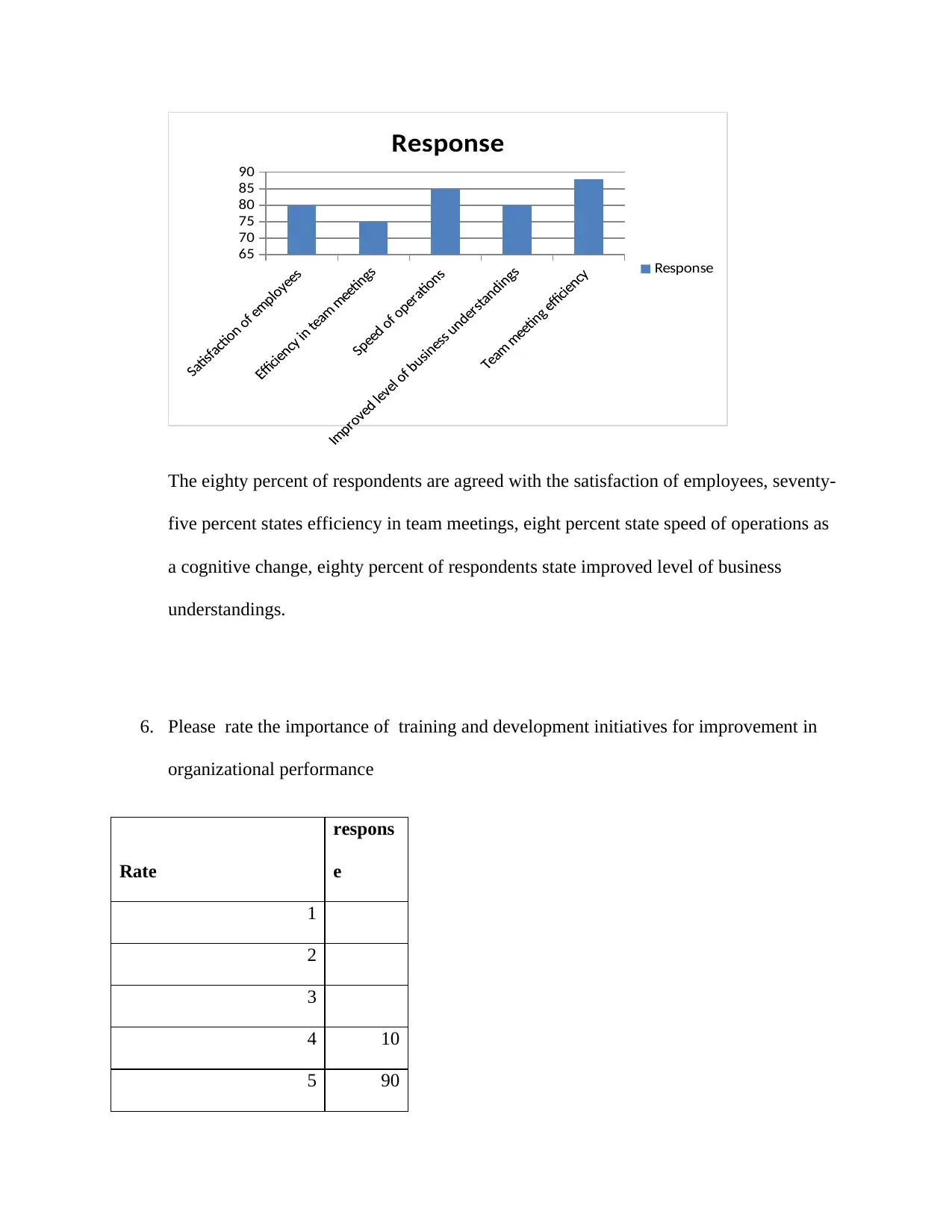
65
70
75
80
85
90
Response
Response
The eighty percent of respondents are agreed with the satisfaction of employees, seventy-
five percent states efficiency in team meetings, eight percent state speed of operations as
a cognitive change, eighty percent of respondents state improved level of business
understandings.
6. Please rate the importance of training and development initiatives for improvement in
organizational performance
Rate
respons
e
1
2
3
4 10
5 90
70
75
80
85
90
Response
Response
The eighty percent of respondents are agreed with the satisfaction of employees, seventy-
five percent states efficiency in team meetings, eight percent state speed of operations as
a cognitive change, eighty percent of respondents state improved level of business
understandings.
6. Please rate the importance of training and development initiatives for improvement in
organizational performance
Rate
respons
e
1
2
3
4 10
5 90
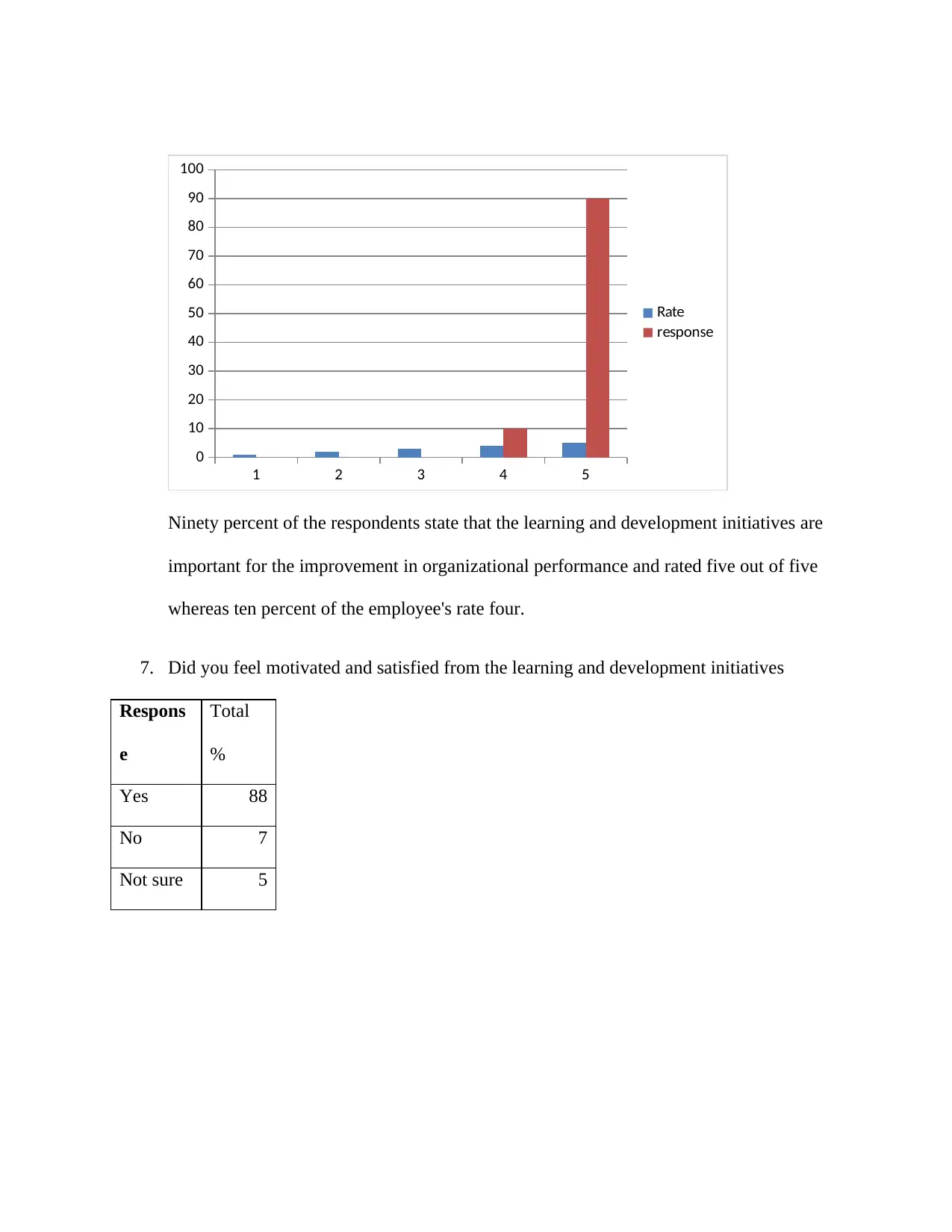
1 2 3 4 5
0
10
20
30
40
50
60
70
80
90
100
Rate
response
Ninety percent of the respondents state that the learning and development initiatives are
important for the improvement in organizational performance and rated five out of five
whereas ten percent of the employee's rate four.
7. Did you feel motivated and satisfied from the learning and development initiatives
Respons
e
Total
%
Yes 88
No 7
Not sure 5
0
10
20
30
40
50
60
70
80
90
100
Rate
response
Ninety percent of the respondents state that the learning and development initiatives are
important for the improvement in organizational performance and rated five out of five
whereas ten percent of the employee's rate four.
7. Did you feel motivated and satisfied from the learning and development initiatives
Respons
e
Total
%
Yes 88
No 7
Not sure 5
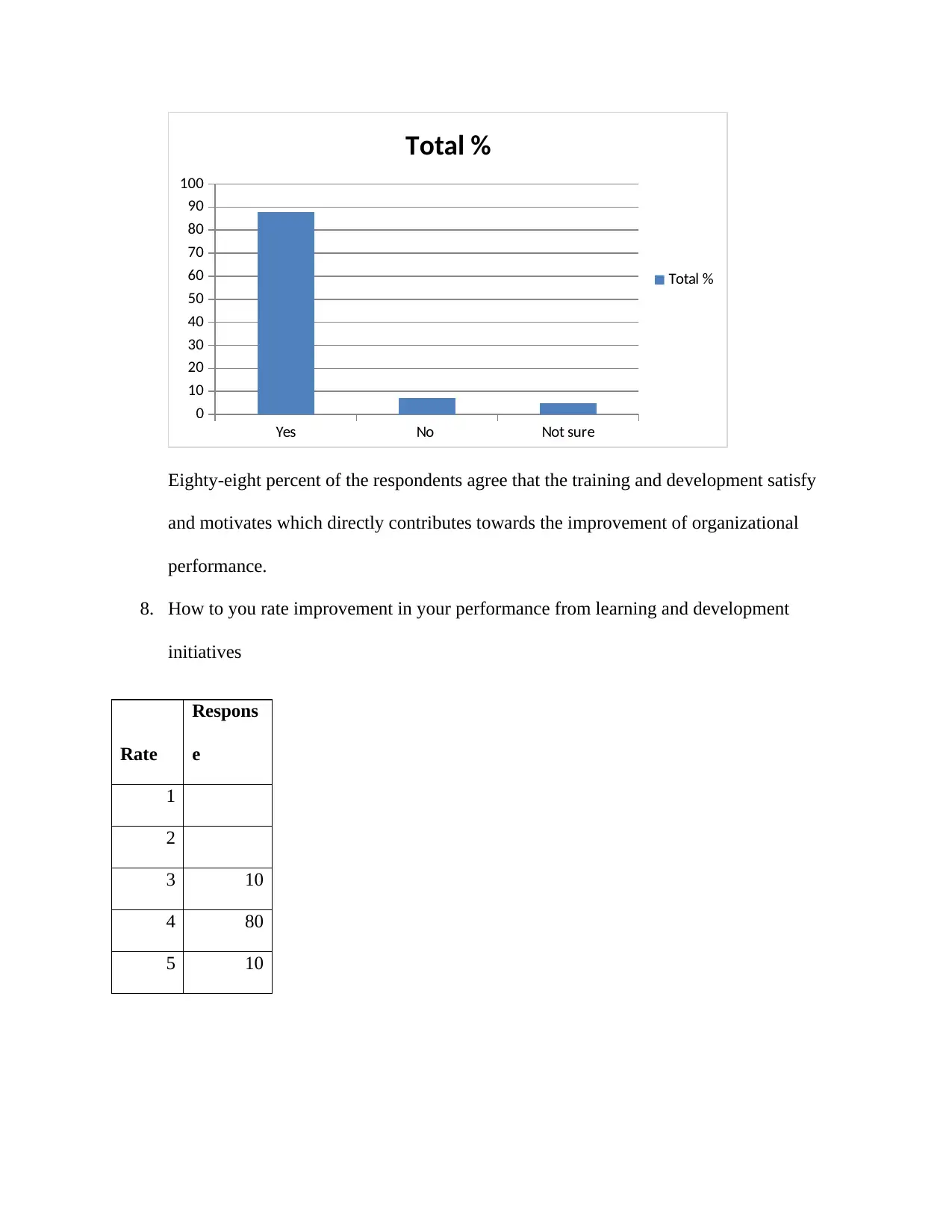
Yes No Not sure
0
10
20
30
40
50
60
70
80
90
100
Total %
Total %
Eighty-eight percent of the respondents agree that the training and development satisfy
and motivates which directly contributes towards the improvement of organizational
performance.
8. How to you rate improvement in your performance from learning and development
initiatives
Rate
Respons
e
1
2
3 10
4 80
5 10
0
10
20
30
40
50
60
70
80
90
100
Total %
Total %
Eighty-eight percent of the respondents agree that the training and development satisfy
and motivates which directly contributes towards the improvement of organizational
performance.
8. How to you rate improvement in your performance from learning and development
initiatives
Rate
Respons
e
1
2
3 10
4 80
5 10
Secure Best Marks with AI Grader
Need help grading? Try our AI Grader for instant feedback on your assignments.

1 2 3 4 5
0
10
20
30
40
50
60
70
80
90
Rate
Response
The eighty percent of the respondents rate their performance four whereas ten percent of
the respondents rate their performance three and rest ten percent of the respondent’s rate
their performance three.
9. According to you learning and development initiatives facilities:
Organizational performance 95
Career growth 90
Skills and capabilities 90
0
10
20
30
40
50
60
70
80
90
Rate
Response
The eighty percent of the respondents rate their performance four whereas ten percent of
the respondents rate their performance three and rest ten percent of the respondent’s rate
their performance three.
9. According to you learning and development initiatives facilities:
Organizational performance 95
Career growth 90
Skills and capabilities 90
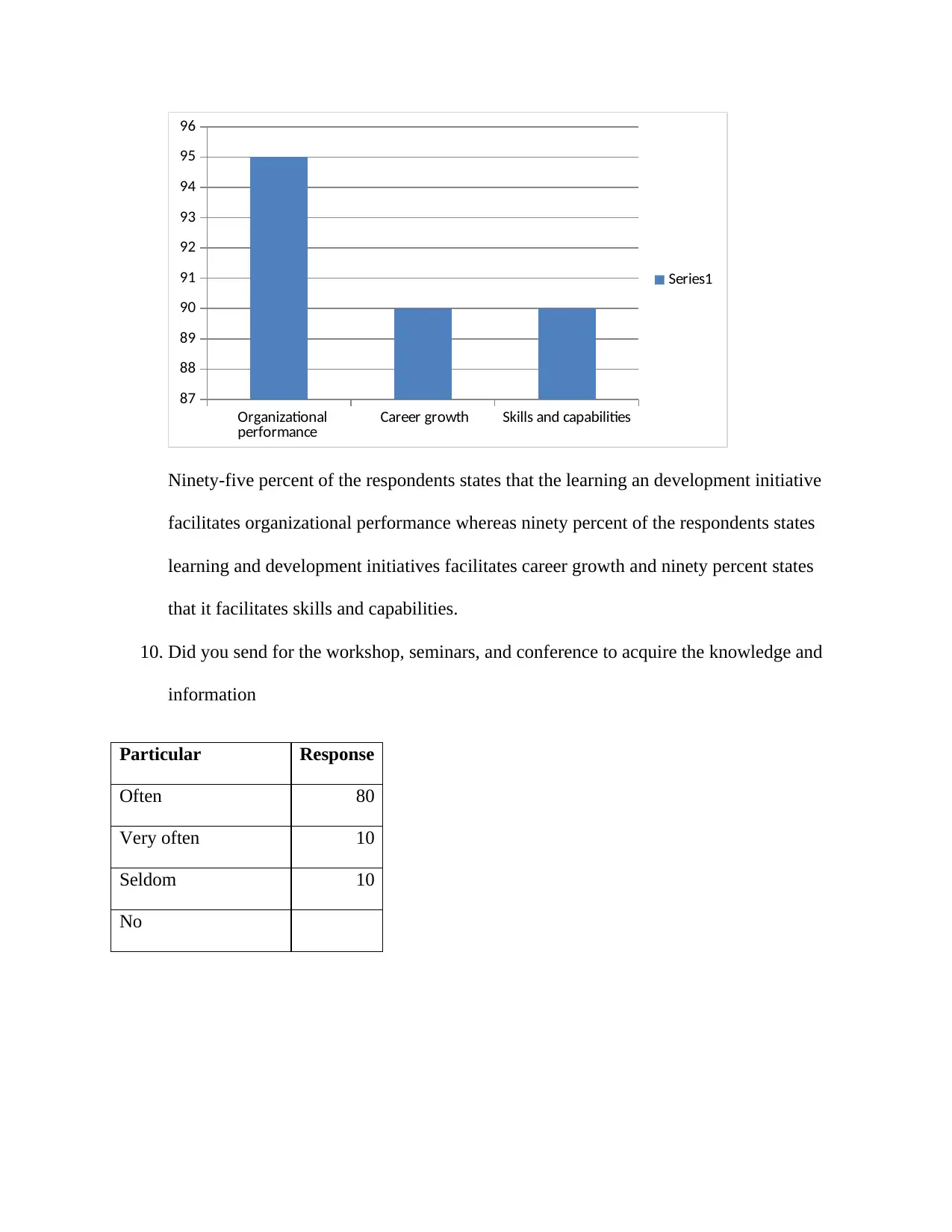
Organizational
performance Career growth Skills and capabilities
87
88
89
90
91
92
93
94
95
96
Series1
Ninety-five percent of the respondents states that the learning an development initiative
facilitates organizational performance whereas ninety percent of the respondents states
learning and development initiatives facilitates career growth and ninety percent states
that it facilitates skills and capabilities.
10. Did you send for the workshop, seminars, and conference to acquire the knowledge and
information
Particular Response
Often 80
Very often 10
Seldom 10
No
performance Career growth Skills and capabilities
87
88
89
90
91
92
93
94
95
96
Series1
Ninety-five percent of the respondents states that the learning an development initiative
facilitates organizational performance whereas ninety percent of the respondents states
learning and development initiatives facilitates career growth and ninety percent states
that it facilitates skills and capabilities.
10. Did you send for the workshop, seminars, and conference to acquire the knowledge and
information
Particular Response
Often 80
Very often 10
Seldom 10
No

Often Very often Seldom No
0
10
20
30
40
50
60
70
80
90
Response
Response
Eighty percent of the respondent's states that the employees are sent for workshop,
conference, and seminars whereas ten percent of the respondent’s states very often and
ten percent states seldom.
11. Please rate the value added by the employees in the organizational performance after
training and development initiatives
Rate Response
1
2
3 5
4 85
5 10
0
10
20
30
40
50
60
70
80
90
Response
Response
Eighty percent of the respondent's states that the employees are sent for workshop,
conference, and seminars whereas ten percent of the respondent’s states very often and
ten percent states seldom.
11. Please rate the value added by the employees in the organizational performance after
training and development initiatives
Rate Response
1
2
3 5
4 85
5 10
Paraphrase This Document
Need a fresh take? Get an instant paraphrase of this document with our AI Paraphraser

1 2 3 4 5
0
10
20
30
40
50
60
70
80
90
Rate
Response
The eighty percent of the respondent's rate four which states that the training and
development initiatives improved the employee's performance which helps to add value
to the organization whereas five percent of the employee rate three and ten percent of the
rate five out of five.
12. The information system of the organization provides an efficient and effective exchange
of information within the organization.
Response
Total
%
Yes 85
No 10
Not sure 5
0
10
20
30
40
50
60
70
80
90
Rate
Response
The eighty percent of the respondent's rate four which states that the training and
development initiatives improved the employee's performance which helps to add value
to the organization whereas five percent of the employee rate three and ten percent of the
rate five out of five.
12. The information system of the organization provides an efficient and effective exchange
of information within the organization.
Response
Total
%
Yes 85
No 10
Not sure 5
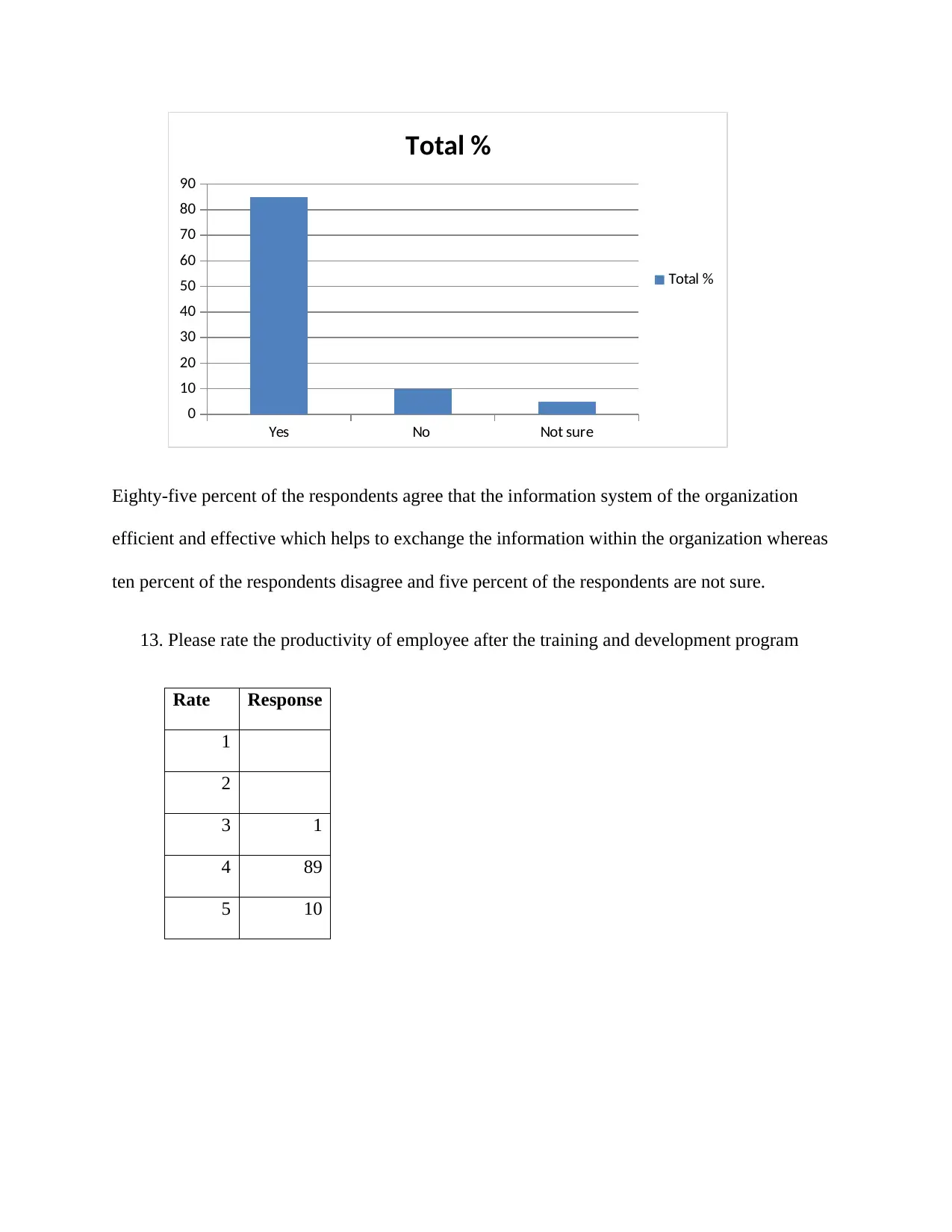
Yes No Not sure
0
10
20
30
40
50
60
70
80
90
Total %
Total %
Eighty-five percent of the respondents agree that the information system of the organization
efficient and effective which helps to exchange the information within the organization whereas
ten percent of the respondents disagree and five percent of the respondents are not sure.
13. Please rate the productivity of employee after the training and development program
Rate Response
1
2
3 1
4 89
5 10
0
10
20
30
40
50
60
70
80
90
Total %
Total %
Eighty-five percent of the respondents agree that the information system of the organization
efficient and effective which helps to exchange the information within the organization whereas
ten percent of the respondents disagree and five percent of the respondents are not sure.
13. Please rate the productivity of employee after the training and development program
Rate Response
1
2
3 1
4 89
5 10
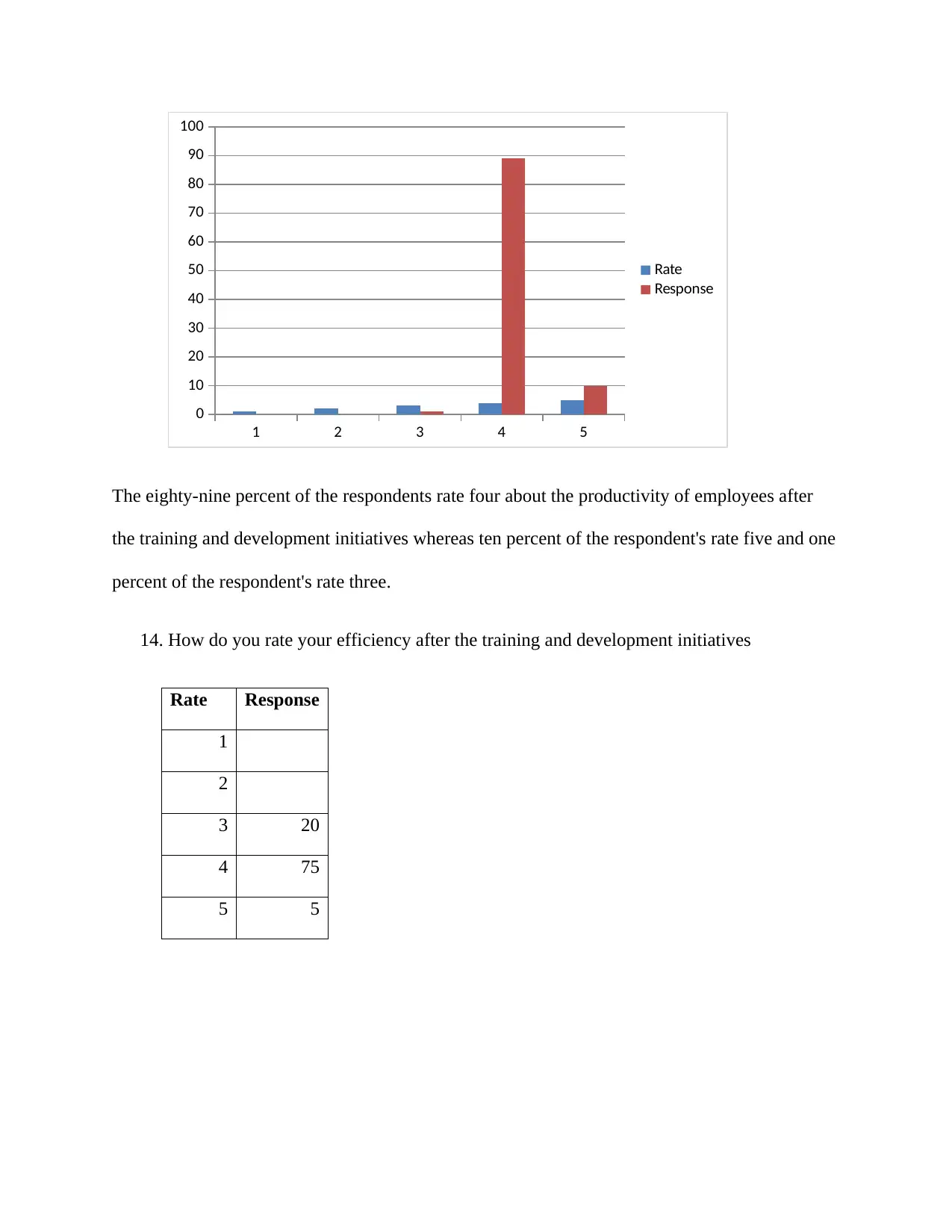
1 2 3 4 5
0
10
20
30
40
50
60
70
80
90
100
Rate
Response
The eighty-nine percent of the respondents rate four about the productivity of employees after
the training and development initiatives whereas ten percent of the respondent's rate five and one
percent of the respondent's rate three.
14. How do you rate your efficiency after the training and development initiatives
Rate Response
1
2
3 20
4 75
5 5
0
10
20
30
40
50
60
70
80
90
100
Rate
Response
The eighty-nine percent of the respondents rate four about the productivity of employees after
the training and development initiatives whereas ten percent of the respondent's rate five and one
percent of the respondent's rate three.
14. How do you rate your efficiency after the training and development initiatives
Rate Response
1
2
3 20
4 75
5 5
Secure Best Marks with AI Grader
Need help grading? Try our AI Grader for instant feedback on your assignments.
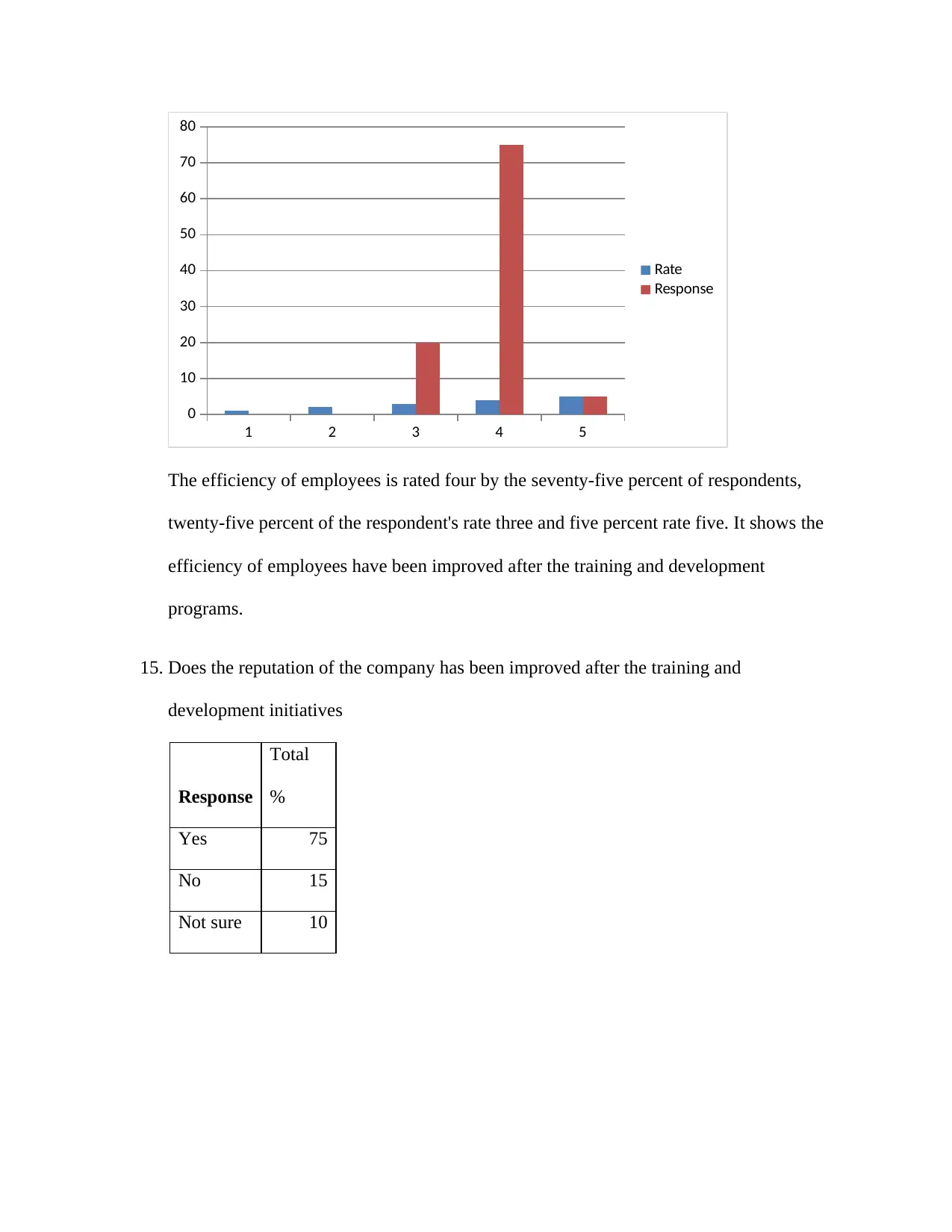
1 2 3 4 5
0
10
20
30
40
50
60
70
80
Rate
Response
The efficiency of employees is rated four by the seventy-five percent of respondents,
twenty-five percent of the respondent's rate three and five percent rate five. It shows the
efficiency of employees have been improved after the training and development
programs.
15. Does the reputation of the company has been improved after the training and
development initiatives
Response
Total
%
Yes 75
No 15
Not sure 10
0
10
20
30
40
50
60
70
80
Rate
Response
The efficiency of employees is rated four by the seventy-five percent of respondents,
twenty-five percent of the respondent's rate three and five percent rate five. It shows the
efficiency of employees have been improved after the training and development
programs.
15. Does the reputation of the company has been improved after the training and
development initiatives
Response
Total
%
Yes 75
No 15
Not sure 10
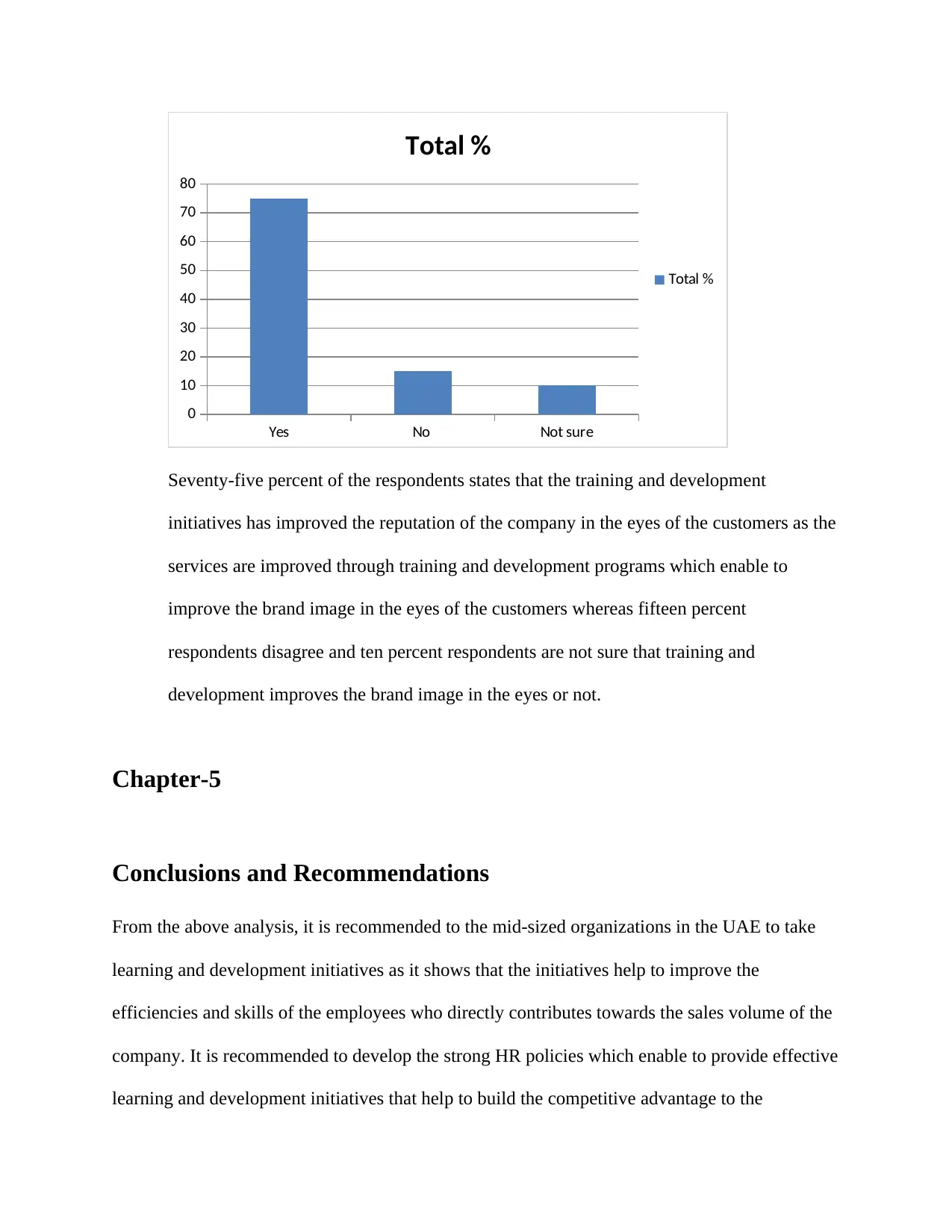
Yes No Not sure
0
10
20
30
40
50
60
70
80
Total %
Total %
Seventy-five percent of the respondents states that the training and development
initiatives has improved the reputation of the company in the eyes of the customers as the
services are improved through training and development programs which enable to
improve the brand image in the eyes of the customers whereas fifteen percent
respondents disagree and ten percent respondents are not sure that training and
development improves the brand image in the eyes or not.
Chapter-5
Conclusions and Recommendations
From the above analysis, it is recommended to the mid-sized organizations in the UAE to take
learning and development initiatives as it shows that the initiatives help to improve the
efficiencies and skills of the employees who directly contributes towards the sales volume of the
company. It is recommended to develop the strong HR policies which enable to provide effective
learning and development initiatives that help to build the competitive advantage to the
0
10
20
30
40
50
60
70
80
Total %
Total %
Seventy-five percent of the respondents states that the training and development
initiatives has improved the reputation of the company in the eyes of the customers as the
services are improved through training and development programs which enable to
improve the brand image in the eyes of the customers whereas fifteen percent
respondents disagree and ten percent respondents are not sure that training and
development improves the brand image in the eyes or not.
Chapter-5
Conclusions and Recommendations
From the above analysis, it is recommended to the mid-sized organizations in the UAE to take
learning and development initiatives as it shows that the initiatives help to improve the
efficiencies and skills of the employees who directly contributes towards the sales volume of the
company. It is recommended to develop the strong HR policies which enable to provide effective
learning and development initiatives that help to build the competitive advantage to the
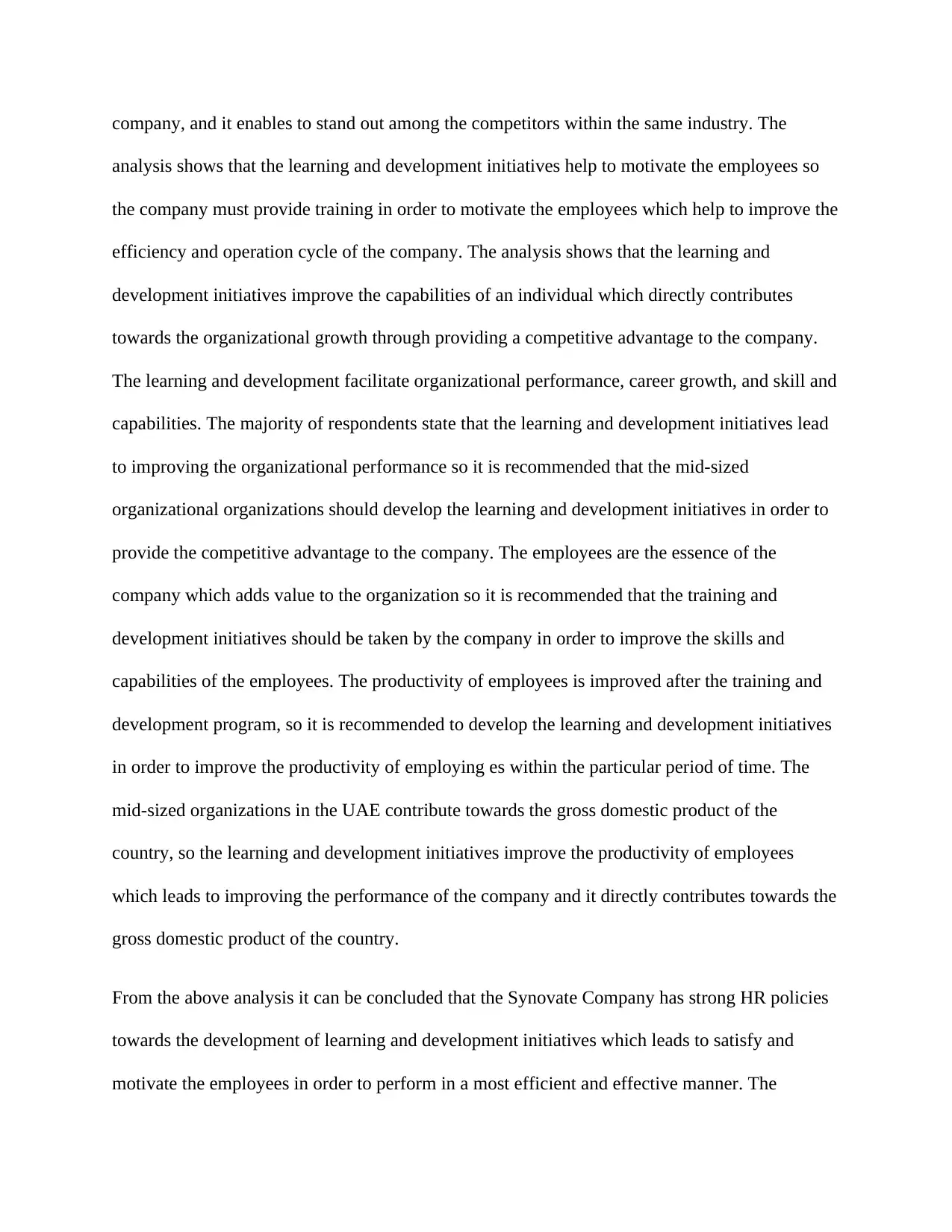
company, and it enables to stand out among the competitors within the same industry. The
analysis shows that the learning and development initiatives help to motivate the employees so
the company must provide training in order to motivate the employees which help to improve the
efficiency and operation cycle of the company. The analysis shows that the learning and
development initiatives improve the capabilities of an individual which directly contributes
towards the organizational growth through providing a competitive advantage to the company.
The learning and development facilitate organizational performance, career growth, and skill and
capabilities. The majority of respondents state that the learning and development initiatives lead
to improving the organizational performance so it is recommended that the mid-sized
organizational organizations should develop the learning and development initiatives in order to
provide the competitive advantage to the company. The employees are the essence of the
company which adds value to the organization so it is recommended that the training and
development initiatives should be taken by the company in order to improve the skills and
capabilities of the employees. The productivity of employees is improved after the training and
development program, so it is recommended to develop the learning and development initiatives
in order to improve the productivity of employing es within the particular period of time. The
mid-sized organizations in the UAE contribute towards the gross domestic product of the
country, so the learning and development initiatives improve the productivity of employees
which leads to improving the performance of the company and it directly contributes towards the
gross domestic product of the country.
From the above analysis it can be concluded that the Synovate Company has strong HR policies
towards the development of learning and development initiatives which leads to satisfy and
motivate the employees in order to perform in a most efficient and effective manner. The
analysis shows that the learning and development initiatives help to motivate the employees so
the company must provide training in order to motivate the employees which help to improve the
efficiency and operation cycle of the company. The analysis shows that the learning and
development initiatives improve the capabilities of an individual which directly contributes
towards the organizational growth through providing a competitive advantage to the company.
The learning and development facilitate organizational performance, career growth, and skill and
capabilities. The majority of respondents state that the learning and development initiatives lead
to improving the organizational performance so it is recommended that the mid-sized
organizational organizations should develop the learning and development initiatives in order to
provide the competitive advantage to the company. The employees are the essence of the
company which adds value to the organization so it is recommended that the training and
development initiatives should be taken by the company in order to improve the skills and
capabilities of the employees. The productivity of employees is improved after the training and
development program, so it is recommended to develop the learning and development initiatives
in order to improve the productivity of employing es within the particular period of time. The
mid-sized organizations in the UAE contribute towards the gross domestic product of the
country, so the learning and development initiatives improve the productivity of employees
which leads to improving the performance of the company and it directly contributes towards the
gross domestic product of the country.
From the above analysis it can be concluded that the Synovate Company has strong HR policies
towards the development of learning and development initiatives which leads to satisfy and
motivate the employees in order to perform in a most efficient and effective manner. The
Paraphrase This Document
Need a fresh take? Get an instant paraphrase of this document with our AI Paraphraser
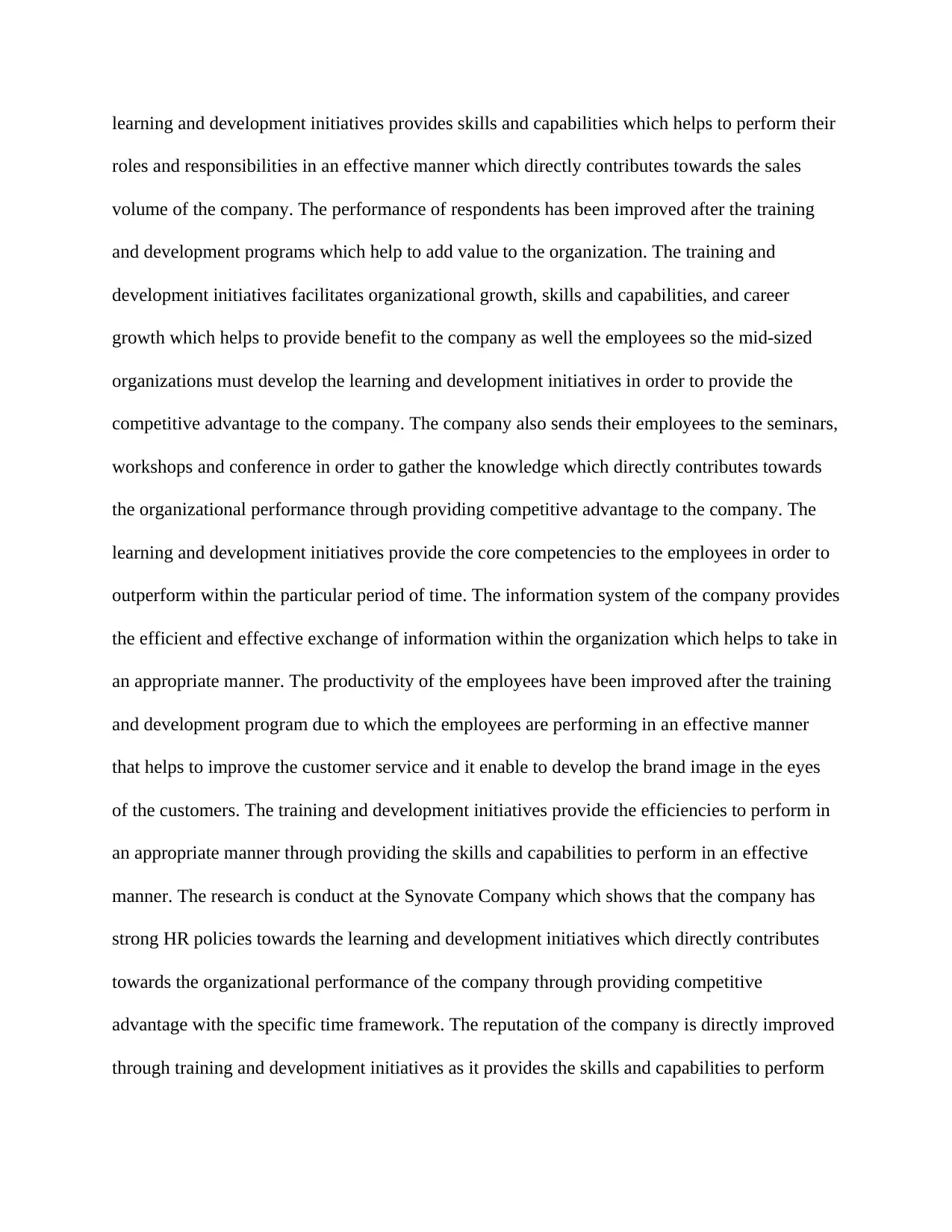
learning and development initiatives provides skills and capabilities which helps to perform their
roles and responsibilities in an effective manner which directly contributes towards the sales
volume of the company. The performance of respondents has been improved after the training
and development programs which help to add value to the organization. The training and
development initiatives facilitates organizational growth, skills and capabilities, and career
growth which helps to provide benefit to the company as well the employees so the mid-sized
organizations must develop the learning and development initiatives in order to provide the
competitive advantage to the company. The company also sends their employees to the seminars,
workshops and conference in order to gather the knowledge which directly contributes towards
the organizational performance through providing competitive advantage to the company. The
learning and development initiatives provide the core competencies to the employees in order to
outperform within the particular period of time. The information system of the company provides
the efficient and effective exchange of information within the organization which helps to take in
an appropriate manner. The productivity of the employees have been improved after the training
and development program due to which the employees are performing in an effective manner
that helps to improve the customer service and it enable to develop the brand image in the eyes
of the customers. The training and development initiatives provide the efficiencies to perform in
an appropriate manner through providing the skills and capabilities to perform in an effective
manner. The research is conduct at the Synovate Company which shows that the company has
strong HR policies towards the learning and development initiatives which directly contributes
towards the organizational performance of the company through providing competitive
advantage with the specific time framework. The reputation of the company is directly improved
through training and development initiatives as it provides the skills and capabilities to perform
roles and responsibilities in an effective manner which directly contributes towards the sales
volume of the company. The performance of respondents has been improved after the training
and development programs which help to add value to the organization. The training and
development initiatives facilitates organizational growth, skills and capabilities, and career
growth which helps to provide benefit to the company as well the employees so the mid-sized
organizations must develop the learning and development initiatives in order to provide the
competitive advantage to the company. The company also sends their employees to the seminars,
workshops and conference in order to gather the knowledge which directly contributes towards
the organizational performance through providing competitive advantage to the company. The
learning and development initiatives provide the core competencies to the employees in order to
outperform within the particular period of time. The information system of the company provides
the efficient and effective exchange of information within the organization which helps to take in
an appropriate manner. The productivity of the employees have been improved after the training
and development program due to which the employees are performing in an effective manner
that helps to improve the customer service and it enable to develop the brand image in the eyes
of the customers. The training and development initiatives provide the efficiencies to perform in
an appropriate manner through providing the skills and capabilities to perform in an effective
manner. The research is conduct at the Synovate Company which shows that the company has
strong HR policies towards the learning and development initiatives which directly contributes
towards the organizational performance of the company through providing competitive
advantage with the specific time framework. The reputation of the company is directly improved
through training and development initiatives as it provides the skills and capabilities to perform
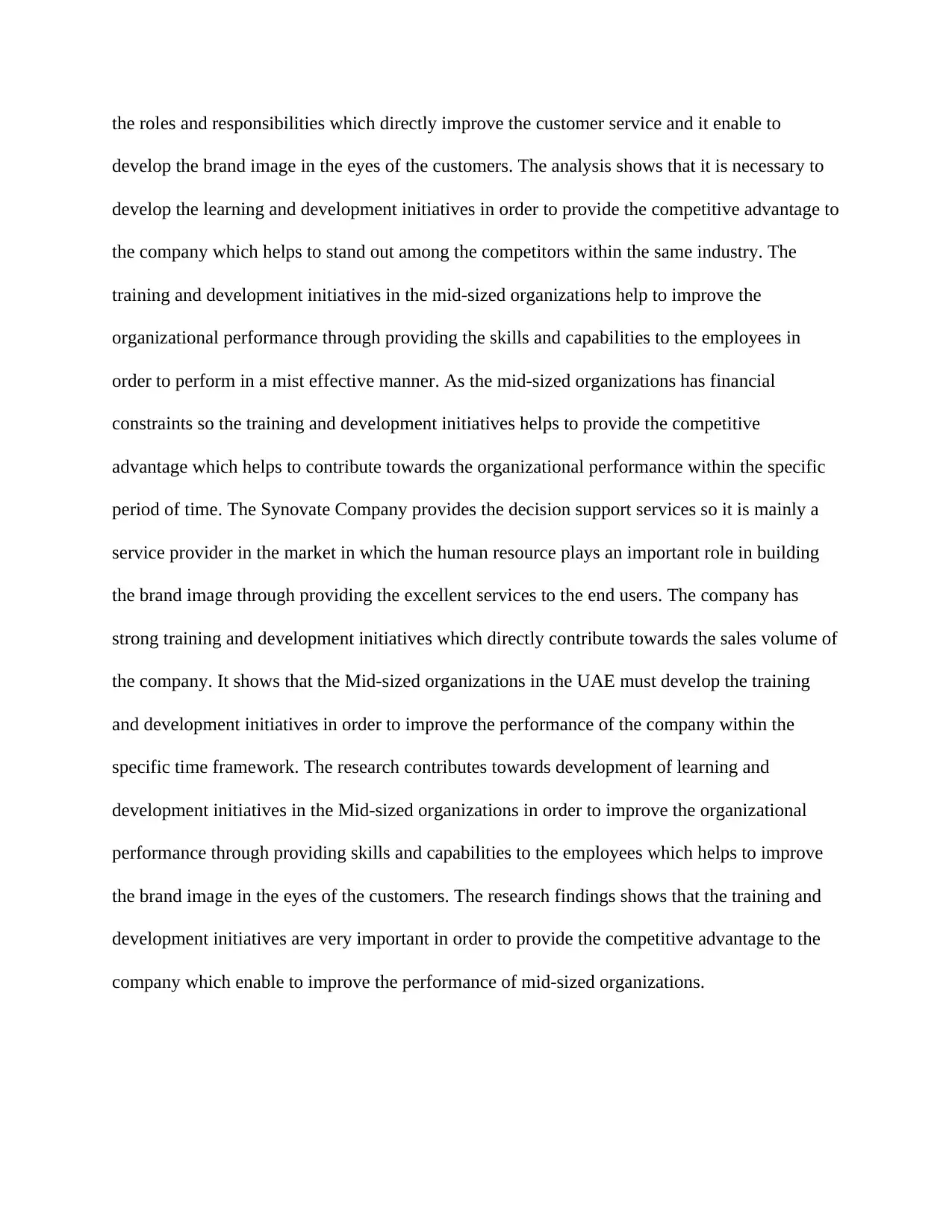
the roles and responsibilities which directly improve the customer service and it enable to
develop the brand image in the eyes of the customers. The analysis shows that it is necessary to
develop the learning and development initiatives in order to provide the competitive advantage to
the company which helps to stand out among the competitors within the same industry. The
training and development initiatives in the mid-sized organizations help to improve the
organizational performance through providing the skills and capabilities to the employees in
order to perform in a mist effective manner. As the mid-sized organizations has financial
constraints so the training and development initiatives helps to provide the competitive
advantage which helps to contribute towards the organizational performance within the specific
period of time. The Synovate Company provides the decision support services so it is mainly a
service provider in the market in which the human resource plays an important role in building
the brand image through providing the excellent services to the end users. The company has
strong training and development initiatives which directly contribute towards the sales volume of
the company. It shows that the Mid-sized organizations in the UAE must develop the training
and development initiatives in order to improve the performance of the company within the
specific time framework. The research contributes towards development of learning and
development initiatives in the Mid-sized organizations in order to improve the organizational
performance through providing skills and capabilities to the employees which helps to improve
the brand image in the eyes of the customers. The research findings shows that the training and
development initiatives are very important in order to provide the competitive advantage to the
company which enable to improve the performance of mid-sized organizations.
develop the brand image in the eyes of the customers. The analysis shows that it is necessary to
develop the learning and development initiatives in order to provide the competitive advantage to
the company which helps to stand out among the competitors within the same industry. The
training and development initiatives in the mid-sized organizations help to improve the
organizational performance through providing the skills and capabilities to the employees in
order to perform in a mist effective manner. As the mid-sized organizations has financial
constraints so the training and development initiatives helps to provide the competitive
advantage which helps to contribute towards the organizational performance within the specific
period of time. The Synovate Company provides the decision support services so it is mainly a
service provider in the market in which the human resource plays an important role in building
the brand image through providing the excellent services to the end users. The company has
strong training and development initiatives which directly contribute towards the sales volume of
the company. It shows that the Mid-sized organizations in the UAE must develop the training
and development initiatives in order to improve the performance of the company within the
specific time framework. The research contributes towards development of learning and
development initiatives in the Mid-sized organizations in order to improve the organizational
performance through providing skills and capabilities to the employees which helps to improve
the brand image in the eyes of the customers. The research findings shows that the training and
development initiatives are very important in order to provide the competitive advantage to the
company which enable to improve the performance of mid-sized organizations.
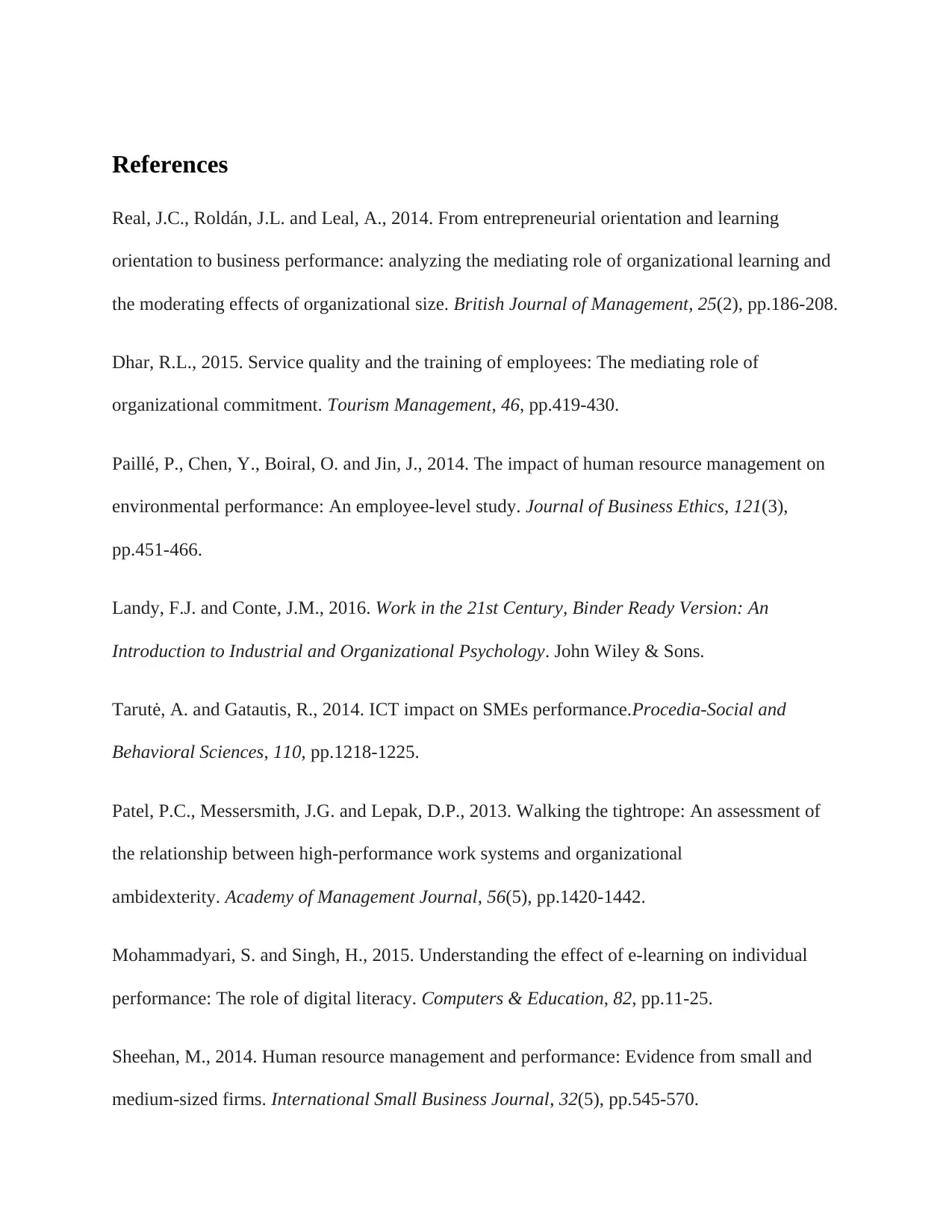
References
Real, J.C., Roldán, J.L. and Leal, A., 2014. From entrepreneurial orientation and learning
orientation to business performance: analyzing the mediating role of organizational learning and
the moderating effects of organizational size. British Journal of Management, 25(2), pp.186-208.
Dhar, R.L., 2015. Service quality and the training of employees: The mediating role of
organizational commitment. Tourism Management, 46, pp.419-430.
Paillé, P., Chen, Y., Boiral, O. and Jin, J., 2014. The impact of human resource management on
environmental performance: An employee-level study. Journal of Business Ethics, 121(3),
pp.451-466.
Landy, F.J. and Conte, J.M., 2016. Work in the 21st Century, Binder Ready Version: An
Introduction to Industrial and Organizational Psychology. John Wiley & Sons.
Tarutė, A. and Gatautis, R., 2014. ICT impact on SMEs performance.Procedia-Social and
Behavioral Sciences, 110, pp.1218-1225.
Patel, P.C., Messersmith, J.G. and Lepak, D.P., 2013. Walking the tightrope: An assessment of
the relationship between high-performance work systems and organizational
ambidexterity. Academy of Management Journal, 56(5), pp.1420-1442.
Mohammadyari, S. and Singh, H., 2015. Understanding the effect of e-learning on individual
performance: The role of digital literacy. Computers & Education, 82, pp.11-25.
Sheehan, M., 2014. Human resource management and performance: Evidence from small and
medium-sized firms. International Small Business Journal, 32(5), pp.545-570.
Real, J.C., Roldán, J.L. and Leal, A., 2014. From entrepreneurial orientation and learning
orientation to business performance: analyzing the mediating role of organizational learning and
the moderating effects of organizational size. British Journal of Management, 25(2), pp.186-208.
Dhar, R.L., 2015. Service quality and the training of employees: The mediating role of
organizational commitment. Tourism Management, 46, pp.419-430.
Paillé, P., Chen, Y., Boiral, O. and Jin, J., 2014. The impact of human resource management on
environmental performance: An employee-level study. Journal of Business Ethics, 121(3),
pp.451-466.
Landy, F.J. and Conte, J.M., 2016. Work in the 21st Century, Binder Ready Version: An
Introduction to Industrial and Organizational Psychology. John Wiley & Sons.
Tarutė, A. and Gatautis, R., 2014. ICT impact on SMEs performance.Procedia-Social and
Behavioral Sciences, 110, pp.1218-1225.
Patel, P.C., Messersmith, J.G. and Lepak, D.P., 2013. Walking the tightrope: An assessment of
the relationship between high-performance work systems and organizational
ambidexterity. Academy of Management Journal, 56(5), pp.1420-1442.
Mohammadyari, S. and Singh, H., 2015. Understanding the effect of e-learning on individual
performance: The role of digital literacy. Computers & Education, 82, pp.11-25.
Sheehan, M., 2014. Human resource management and performance: Evidence from small and
medium-sized firms. International Small Business Journal, 32(5), pp.545-570.
Secure Best Marks with AI Grader
Need help grading? Try our AI Grader for instant feedback on your assignments.
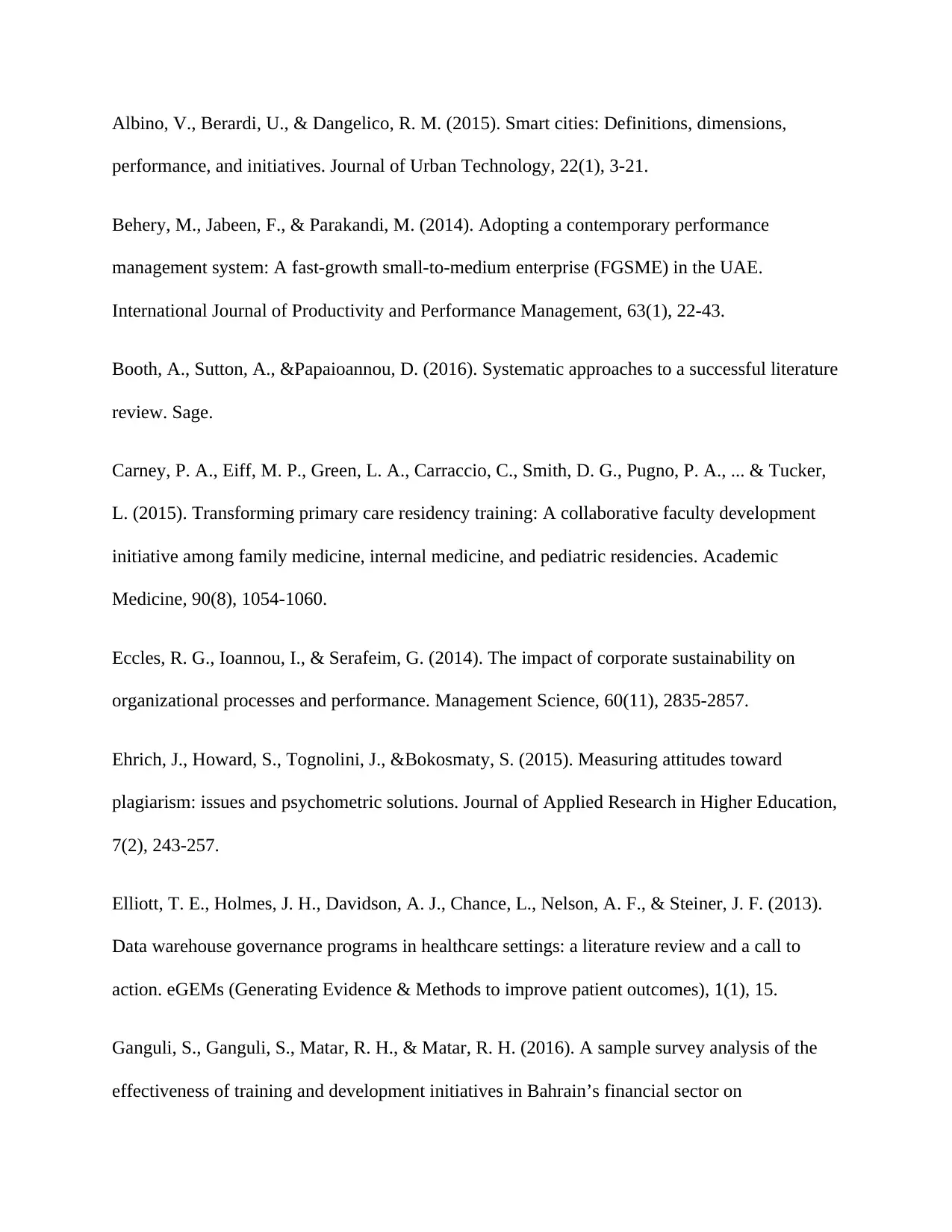
Albino, V., Berardi, U., & Dangelico, R. M. (2015). Smart cities: Definitions, dimensions,
performance, and initiatives. Journal of Urban Technology, 22(1), 3-21.
Behery, M., Jabeen, F., & Parakandi, M. (2014). Adopting a contemporary performance
management system: A fast-growth small-to-medium enterprise (FGSME) in the UAE.
International Journal of Productivity and Performance Management, 63(1), 22-43.
Booth, A., Sutton, A., &Papaioannou, D. (2016). Systematic approaches to a successful literature
review. Sage.
Carney, P. A., Eiff, M. P., Green, L. A., Carraccio, C., Smith, D. G., Pugno, P. A., ... & Tucker,
L. (2015). Transforming primary care residency training: A collaborative faculty development
initiative among family medicine, internal medicine, and pediatric residencies. Academic
Medicine, 90(8), 1054-1060.
Eccles, R. G., Ioannou, I., & Serafeim, G. (2014). The impact of corporate sustainability on
organizational processes and performance. Management Science, 60(11), 2835-2857.
Ehrich, J., Howard, S., Tognolini, J., &Bokosmaty, S. (2015). Measuring attitudes toward
plagiarism: issues and psychometric solutions. Journal of Applied Research in Higher Education,
7(2), 243-257.
Elliott, T. E., Holmes, J. H., Davidson, A. J., Chance, L., Nelson, A. F., & Steiner, J. F. (2013).
Data warehouse governance programs in healthcare settings: a literature review and a call to
action. eGEMs (Generating Evidence & Methods to improve patient outcomes), 1(1), 15.
Ganguli, S., Ganguli, S., Matar, R. H., & Matar, R. H. (2016). A sample survey analysis of the
effectiveness of training and development initiatives in Bahrain’s financial sector on
performance, and initiatives. Journal of Urban Technology, 22(1), 3-21.
Behery, M., Jabeen, F., & Parakandi, M. (2014). Adopting a contemporary performance
management system: A fast-growth small-to-medium enterprise (FGSME) in the UAE.
International Journal of Productivity and Performance Management, 63(1), 22-43.
Booth, A., Sutton, A., &Papaioannou, D. (2016). Systematic approaches to a successful literature
review. Sage.
Carney, P. A., Eiff, M. P., Green, L. A., Carraccio, C., Smith, D. G., Pugno, P. A., ... & Tucker,
L. (2015). Transforming primary care residency training: A collaborative faculty development
initiative among family medicine, internal medicine, and pediatric residencies. Academic
Medicine, 90(8), 1054-1060.
Eccles, R. G., Ioannou, I., & Serafeim, G. (2014). The impact of corporate sustainability on
organizational processes and performance. Management Science, 60(11), 2835-2857.
Ehrich, J., Howard, S., Tognolini, J., &Bokosmaty, S. (2015). Measuring attitudes toward
plagiarism: issues and psychometric solutions. Journal of Applied Research in Higher Education,
7(2), 243-257.
Elliott, T. E., Holmes, J. H., Davidson, A. J., Chance, L., Nelson, A. F., & Steiner, J. F. (2013).
Data warehouse governance programs in healthcare settings: a literature review and a call to
action. eGEMs (Generating Evidence & Methods to improve patient outcomes), 1(1), 15.
Ganguli, S., Ganguli, S., Matar, R. H., & Matar, R. H. (2016). A sample survey analysis of the
effectiveness of training and development initiatives in Bahrain’s financial sector on
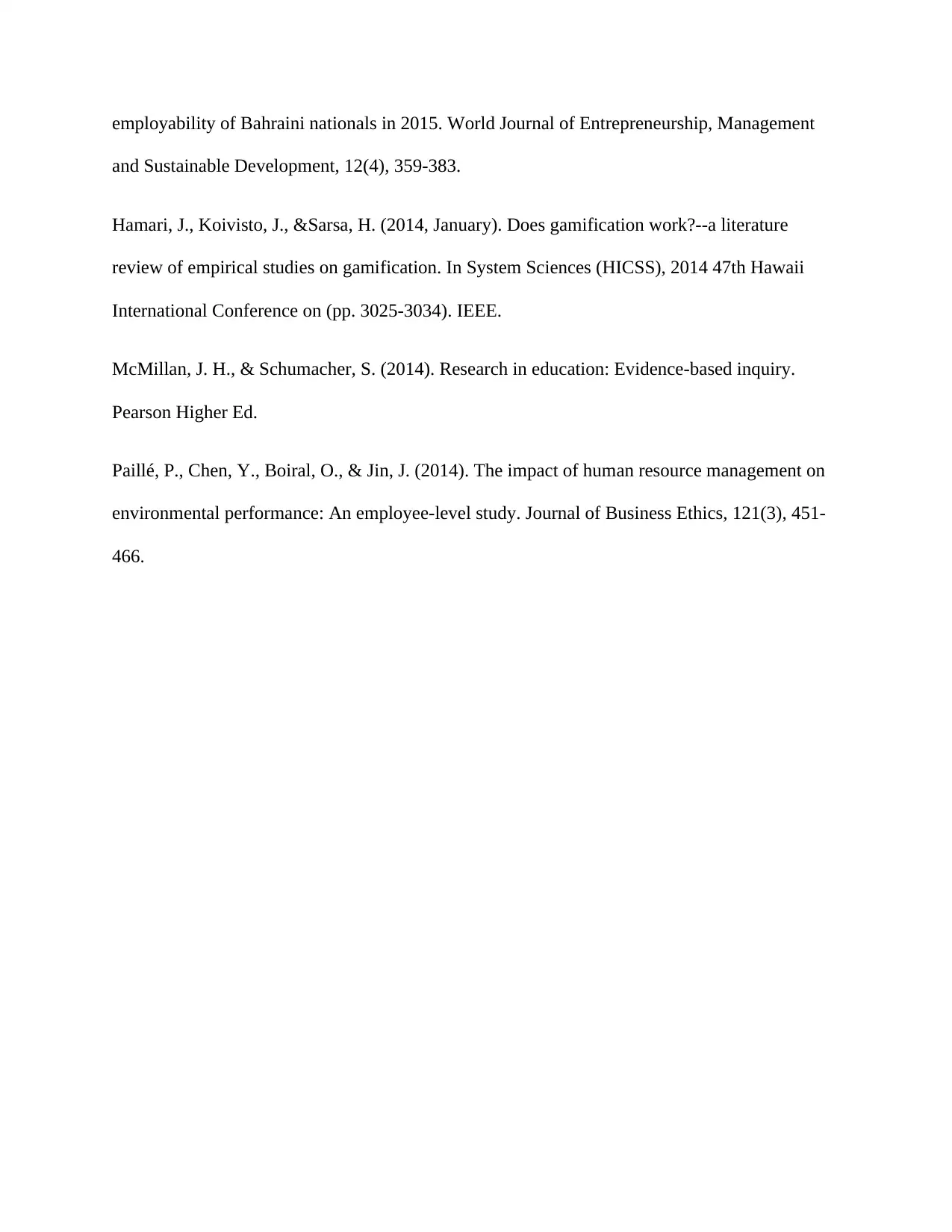
employability of Bahraini nationals in 2015. World Journal of Entrepreneurship, Management
and Sustainable Development, 12(4), 359-383.
Hamari, J., Koivisto, J., &Sarsa, H. (2014, January). Does gamification work?--a literature
review of empirical studies on gamification. In System Sciences (HICSS), 2014 47th Hawaii
International Conference on (pp. 3025-3034). IEEE.
McMillan, J. H., & Schumacher, S. (2014). Research in education: Evidence-based inquiry.
Pearson Higher Ed.
Paillé, P., Chen, Y., Boiral, O., & Jin, J. (2014). The impact of human resource management on
environmental performance: An employee-level study. Journal of Business Ethics, 121(3), 451-
466.
and Sustainable Development, 12(4), 359-383.
Hamari, J., Koivisto, J., &Sarsa, H. (2014, January). Does gamification work?--a literature
review of empirical studies on gamification. In System Sciences (HICSS), 2014 47th Hawaii
International Conference on (pp. 3025-3034). IEEE.
McMillan, J. H., & Schumacher, S. (2014). Research in education: Evidence-based inquiry.
Pearson Higher Ed.
Paillé, P., Chen, Y., Boiral, O., & Jin, J. (2014). The impact of human resource management on
environmental performance: An employee-level study. Journal of Business Ethics, 121(3), 451-
466.
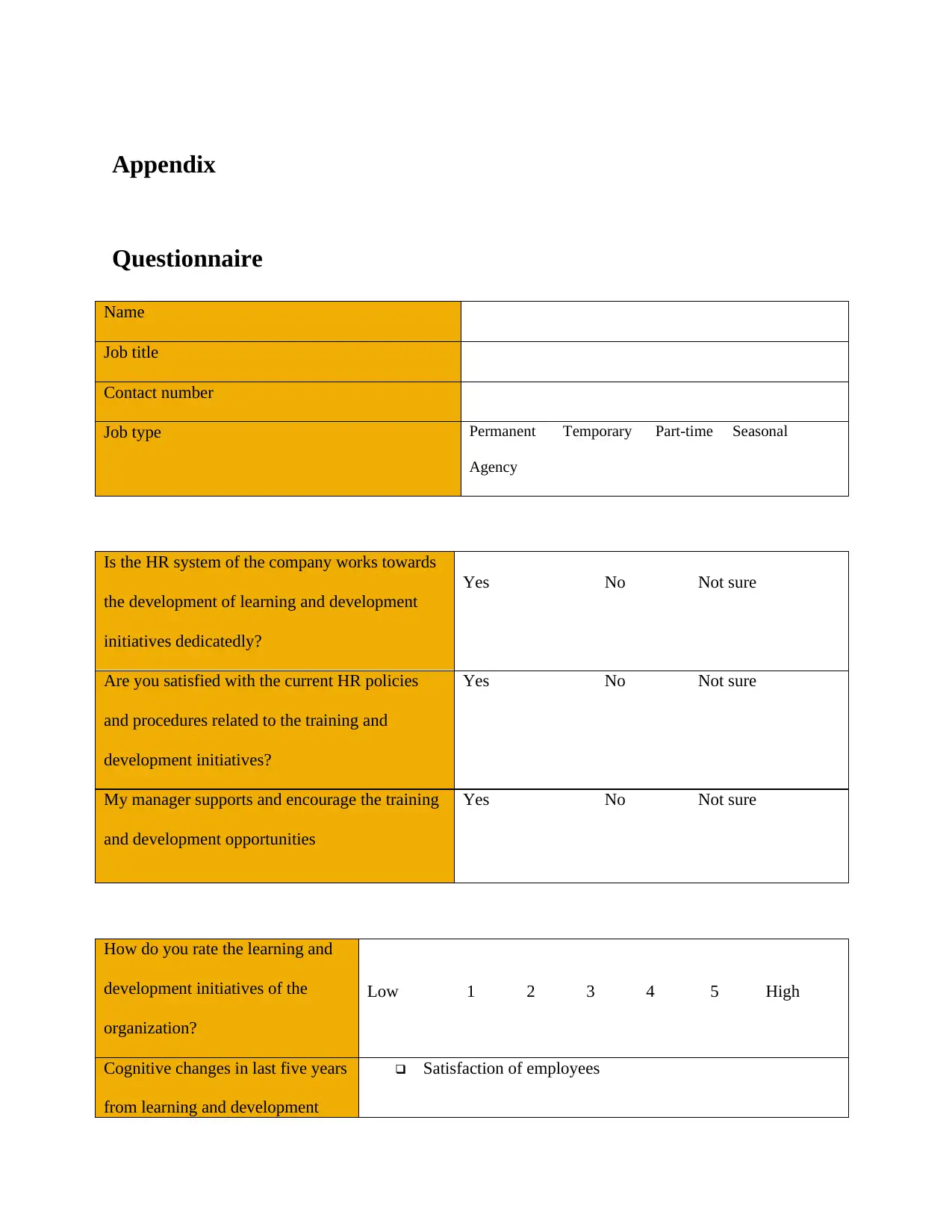
Appendix
Questionnaire
Name
Job title
Contact number
Job type Permanent Temporary Part-time Seasonal
Agency
Is the HR system of the company works towards
the development of learning and development
initiatives dedicatedly?
Yes No Not sure
Are you satisfied with the current HR policies
and procedures related to the training and
development initiatives?
Yes No Not sure
My manager supports and encourage the training
and development opportunities
Yes No Not sure
How do you rate the learning and
development initiatives of the
organization?
Low 1 2 3 4 5 High
Cognitive changes in last five years
from learning and development
Satisfaction of employees
Questionnaire
Name
Job title
Contact number
Job type Permanent Temporary Part-time Seasonal
Agency
Is the HR system of the company works towards
the development of learning and development
initiatives dedicatedly?
Yes No Not sure
Are you satisfied with the current HR policies
and procedures related to the training and
development initiatives?
Yes No Not sure
My manager supports and encourage the training
and development opportunities
Yes No Not sure
How do you rate the learning and
development initiatives of the
organization?
Low 1 2 3 4 5 High
Cognitive changes in last five years
from learning and development
Satisfaction of employees
Paraphrase This Document
Need a fresh take? Get an instant paraphrase of this document with our AI Paraphraser
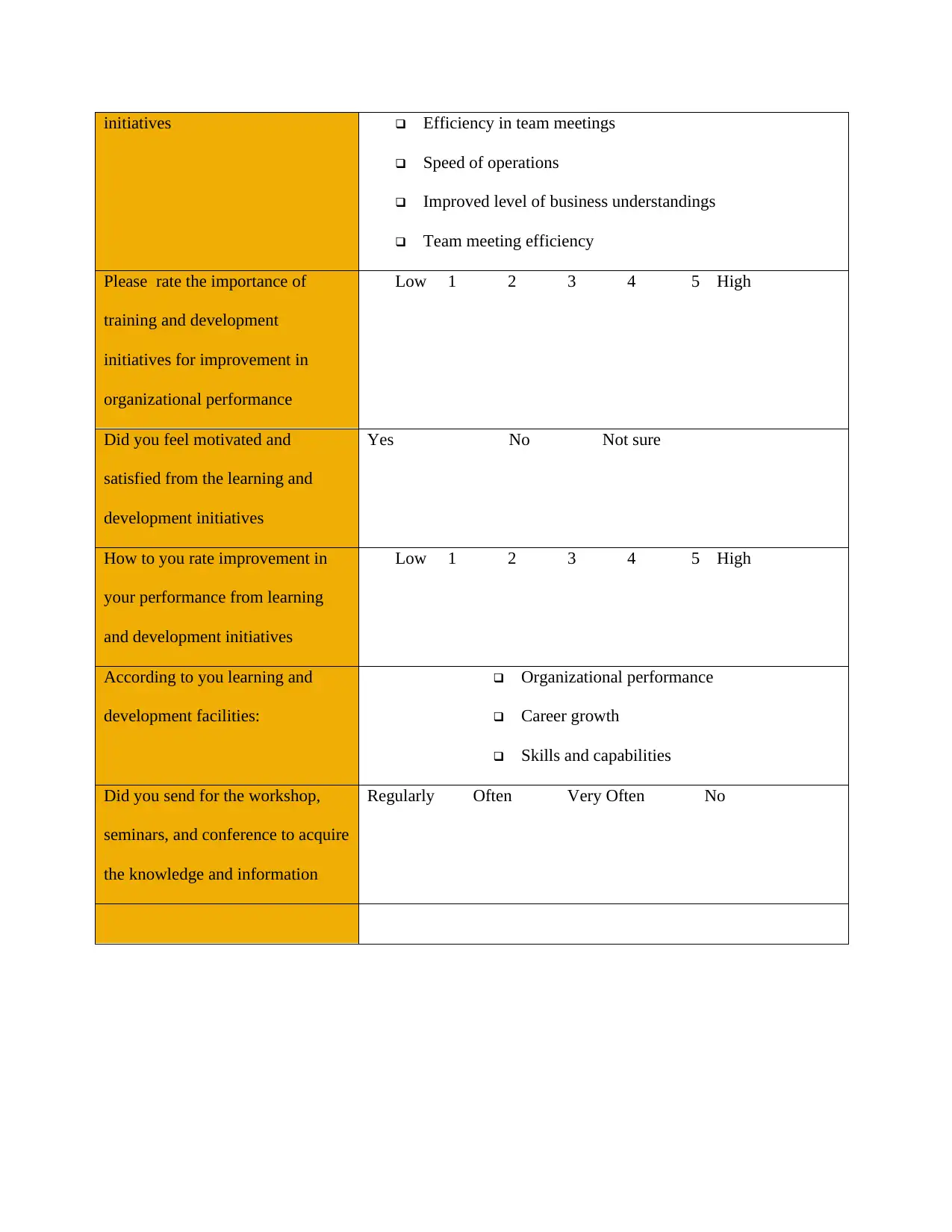
initiatives Efficiency in team meetings
Speed of operations
Improved level of business understandings
Team meeting efficiency
Please rate the importance of
training and development
initiatives for improvement in
organizational performance
Low 1 2 3 4 5 High
Did you feel motivated and
satisfied from the learning and
development initiatives
Yes No Not sure
How to you rate improvement in
your performance from learning
and development initiatives
Low 1 2 3 4 5 High
According to you learning and
development facilities:
Organizational performance
Career growth
Skills and capabilities
Did you send for the workshop,
seminars, and conference to acquire
the knowledge and information
Regularly Often Very Often No
Speed of operations
Improved level of business understandings
Team meeting efficiency
Please rate the importance of
training and development
initiatives for improvement in
organizational performance
Low 1 2 3 4 5 High
Did you feel motivated and
satisfied from the learning and
development initiatives
Yes No Not sure
How to you rate improvement in
your performance from learning
and development initiatives
Low 1 2 3 4 5 High
According to you learning and
development facilities:
Organizational performance
Career growth
Skills and capabilities
Did you send for the workshop,
seminars, and conference to acquire
the knowledge and information
Regularly Often Very Often No
1 out of 59
Related Documents
Your All-in-One AI-Powered Toolkit for Academic Success.
+13062052269
info@desklib.com
Available 24*7 on WhatsApp / Email
![[object Object]](/_next/static/media/star-bottom.7253800d.svg)
Unlock your academic potential
© 2024 | Zucol Services PVT LTD | All rights reserved.





